It seems we can’t find what you’re looking for. Perhaps searching can help.




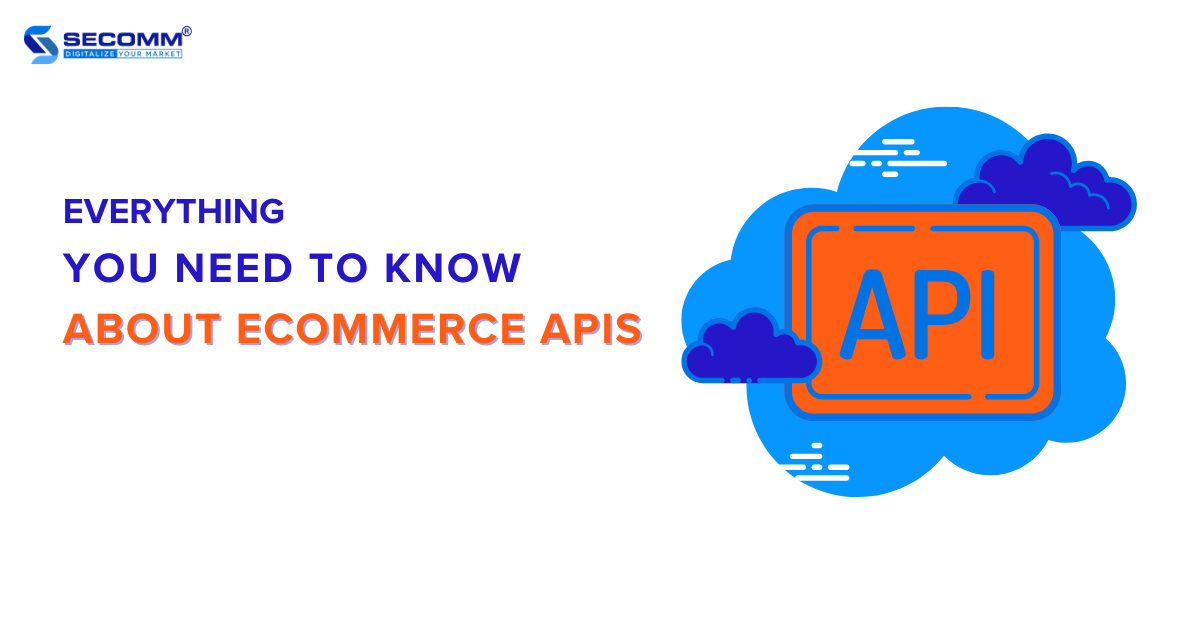
EVERYTHING YOU NEED TO KNOW ABOUT ECOMMERCE APIs
Businesses going headless aim to integrate with third-party applications or services to extend capabilities, boost performance, and enhance the flexibility of their eCommerce systems. Therefore, they have to understand eCommerce APIs or application programming interfaces.
This article will provide a brief overview of what eCommerce APIs are, how they work, the types, and roles for going headless, and the advantages gained through their integration.
Learn more: What is Headless Commerce?
What are eCommerce APIs?
eCommerce APIs are application programming interfaces (APIs) that enable external applications and systems to access and interact with the functionalities and data of an eCommerce platform.
For example, an eCommerce API allows businesses to access product information, place orders, handle payments, manage inventory, or integrate with third-party services such as shipping, analytics, email marketing, and delivery.
How do eCommerce APIs work?
They operate based on a request-and-response model. When an application or system intends to access or perform a function on the eCommerce system, it sends a request to the API through an HTTP method such as GET, POST, PUT, or DELETE.
This request contains information like the URL address of the API and necessary data. Then, eCommerce APIs process the request and respond to the application or system that initiated the preceding request. This response includes an HTTP code indicating the outcome of the request (success or failure) and may contain data in formats like JSON, XML, etc.
APIs in the field of eCommerce are often published in the form of documentation known as “API documentation”. This documentation contains detailed instructions on how to establish connections and share data through the API. This helps businesses and developers understand how to use each type of API effectively.
Types of eCommerce APIs
There are various types of eCommerce APIs depending on their functions and specific use cases. Some common include:
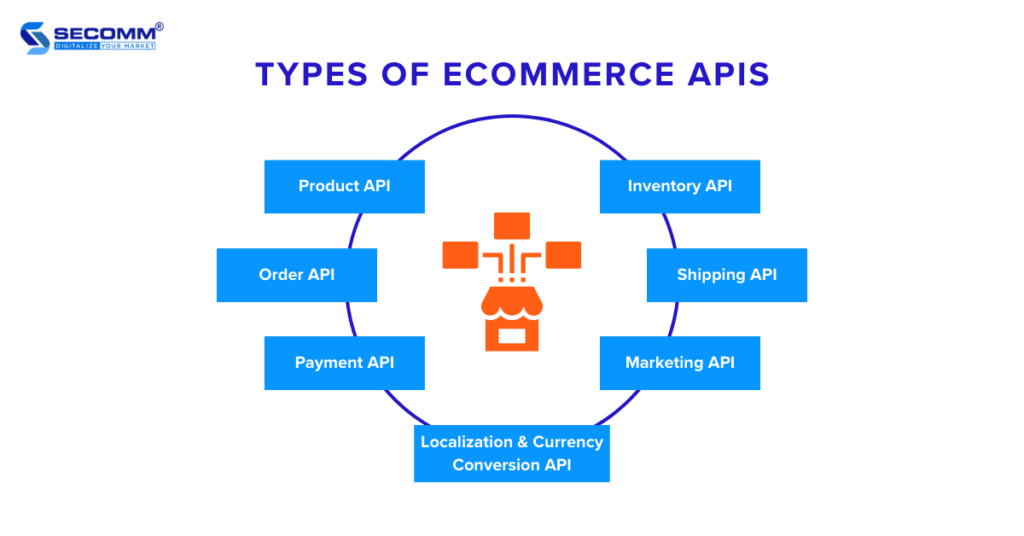
- Product API: Provides product information, allowing the display of product lists, product details, and product category management on an eCommerce website. Examples include Shopify Product API, BigCommerce Product API, WooCommerce Product API,…
- Order API: Supports order management, from creating orders, and updating order status to handling returns and refunds. Examples include Shopify Order API, BigCommerce Order API, Magento Order API,…
- Payment API: Enables online payment processing, integrates payment gateways, and ensures secure payment transaction processing. Examples include Stripe API, PayPal API, Braintree API,…
- Inventory API: Manages inventory information, including available product quantities, updates inventory after each order, and tracks inventory levels. Examples include Shopify Inventory API, BigCommerce Inventory API, Magento Inventory API, WooCommerce Inventory API,…
- Shipping API: Provides integrated shipping and order tracking, helping customers view shipping information and predict delivery times. Examples include ShipStation API, FedEx API, Shippo API,…
- Marketing API: Allows integration with email marketing tools, paid advertising, or social media platforms. Examples include Mailchimp API, HubSpot API, Google Ads API,…
- Localization & Currency Conversion API: Allows customization and formatting of eCommerce websites to suit different customer demographics in various countries and territories. Examples include Shopify Multi-Currency API, Stripe Localization API, PayPal Localization API,…
The Role of eCommerce APIs in Headless Commerce
Headless is an eCommerce model that allows the separation of the user interface (frontend) and the management system (backend) of an eCommerce website. is also referred to as the “API-first” approach because the frontend and backend communicate with each other through an API layer.
Therefore, eCommerce APIs play a crucial role in connecting the frontend and backend. For instance, when a customer accesses a business’s eCommerce website and places an order, the website’s frontend can use eCommerce APIs to send requests to the backend to check product availability, calculate the order value, and create the order.
The backend can then process these requests and provide the necessary information to display to the customer.
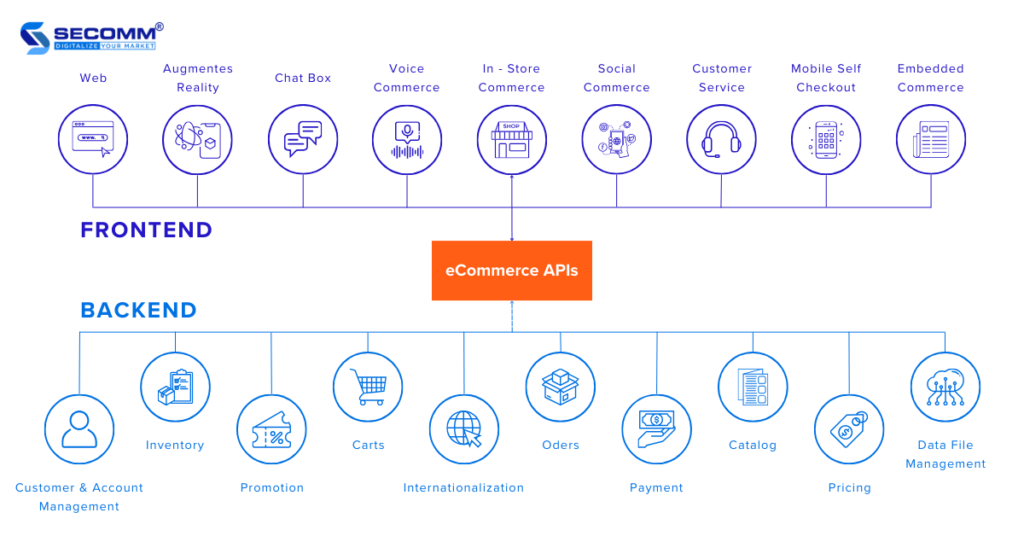
eCommerce APIs allow the frontend to access and interact with the functions and data of the backend. They also enable the backend to integrate with third-party services and systems such as CMS, CRM, ERP, and DXP. Additionally, eCommerce APIs help businesses create various user interfaces for diverse sales channels and devices, including websites, mobile apps, voice commerce, wearables, AR/VR.
These eCommerce APIs empower businesses to go headless flexibly, providing not only a multi-channel shopping experience but also facilitating rapid and efficient expansion and development in the international market.
Benefits of integrating eCommerce APIs
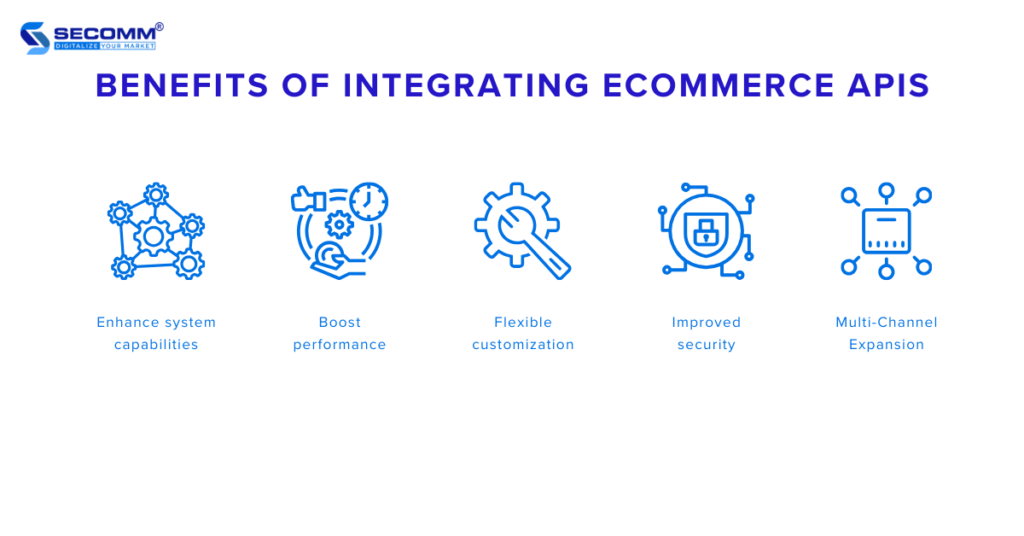
- Enhance system capabilities
Businesses can add new functions and features to their eCommerce websites by using available APIs or creating their own APIs. This allows businesses to easily expand the capabilities of their eCommerce systems, providing customers with an enhanced shopping experience.
- Boost performance
Businesses can optimize the performance of their eCommerce websites by leveraging eCommerce APIs to automate business processes, minimizing potential errors. For example, a business can use APIs to synchronize data across different systems for more efficient management and operations.
- Flexible customization
Businesses have the freedom to customize their eCommerce websites according to their needs and preferences by integrating APIs to connect with third-party applications and systems. For example, businesses can use APIs to create a unique user experience, incorporating new technologies such as AI, AR/VR, and blockchain.
- Improved security
Third-party applications and systems, especially payment systems, often include strict security protocols. Therefore, integrating them into a business’s website through APIs enhances the security of the site. This helps safeguard business data, customer information, and payment details from the risk of theft.
- Multi-Channel Expansion
APIs enable businesses to integrate with various user interfaces, allowing them to expand their business operations across multiple sales channels, including websites, mobile apps, and even social media.
The Bottom Line
Here is what you need to know about eCommerce APIs – application programming interfaces that enable various applications and systems to interact with each other efficiently within the eCommerce system. In other words, eCommerce APIs act as a bridge between the frontend and backend in the Headless model, allowing businesses to customize operations flexibly and provide customers with a unique and seamless shopping experience.
Contact SECOMM or call the hotline at 028 7108 9908 to learn more about integrating eCommerce APIs and going headless. We have a team of experienced and specialized experts to turn your business ideas into reality and accompany businesses on their eCommerce journey.
 2
2

 3,925
3,925

 0
0

 1
1
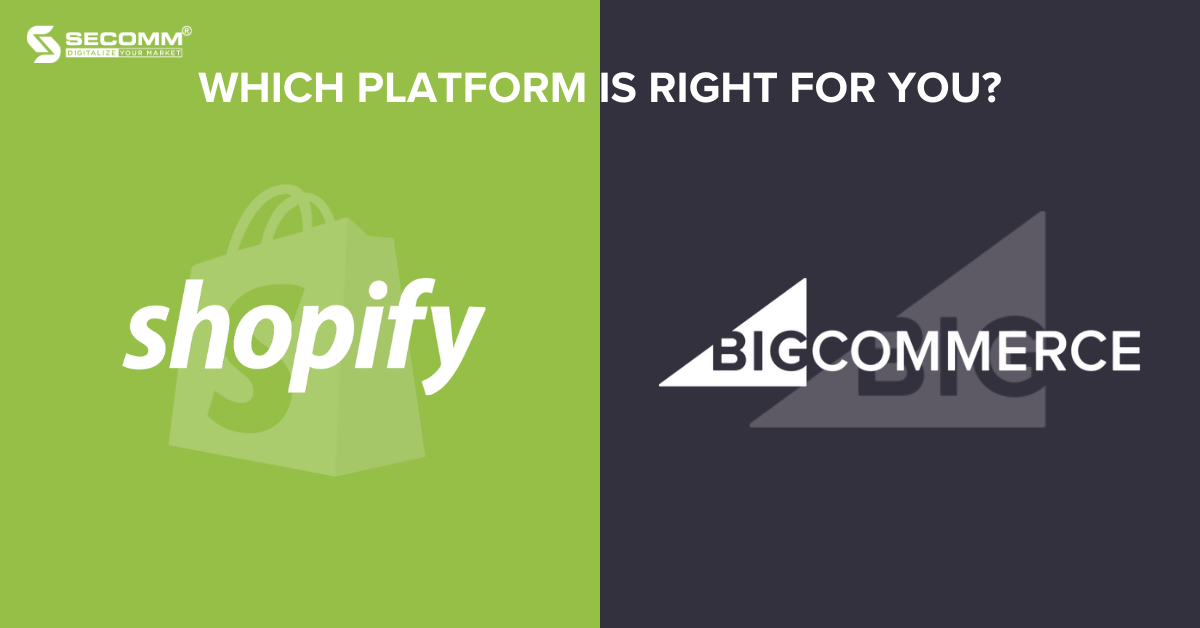
SHOPIFY VS BIGCOMMERCE: WHICH PLATFORM IS RIGHT FOR YOU?
In recent times, SaaS platforms like Shopify and BigCommerce have gained popularity thanks to the growing demand for eCommerce. While BigCommerce currently supports over 45 thousand active online stores globally, Shopify surpasses it with around 4.5 million active websites. Although Shopify and BigCommerce share typical features of SaaS platforms, there are notable differences between the two.
This article will compare the distinctions between Shopify and BigCommerce, providing valuable insights to help you, as a business make informed decisions quickly.
Learn more: Shopify Plus vs BigCommerce Enterprise
Shopify vs BigCommerce: Pros and Cons
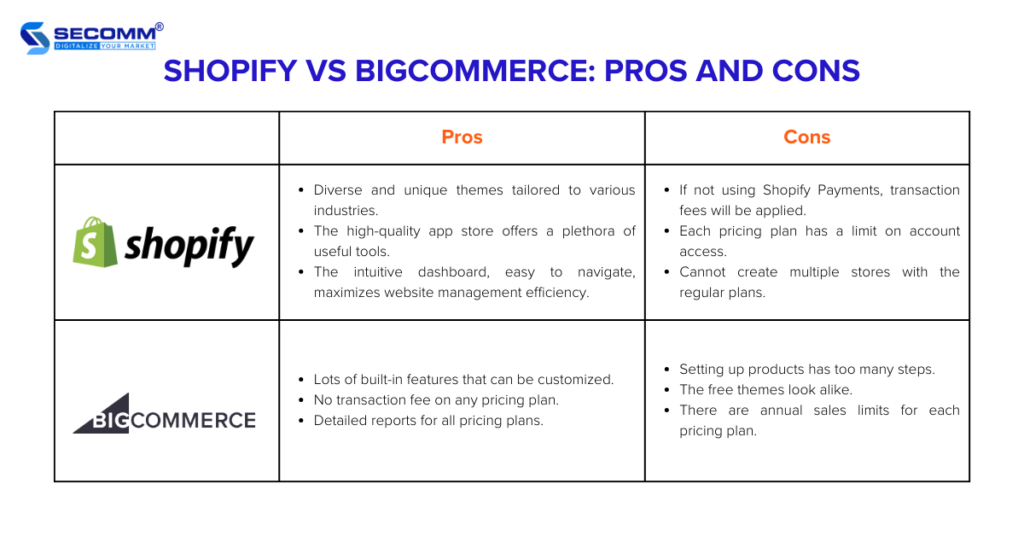
Shopify vs BigCommerce: So sánh nhanh
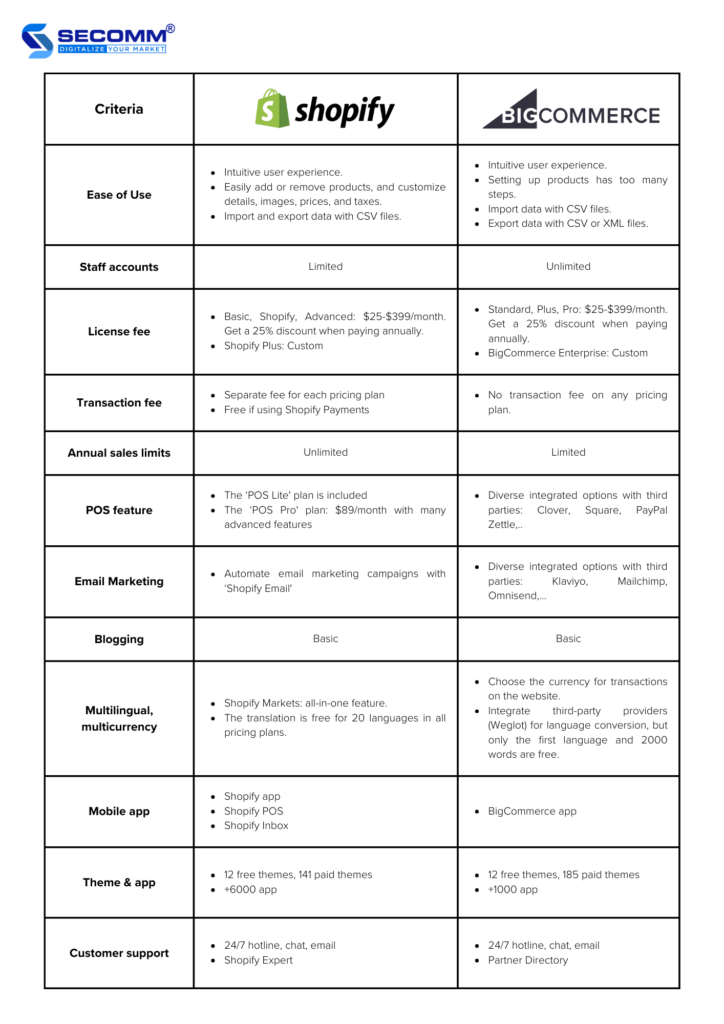
Shopify vs BigCommerce: Detailed Comparison
Ease of Use
New businesses often find Shopify more user-friendly than BigCommerce when it comes to setup and usage. Adding or removing products, customization, and editing layouts on Shopify are all straightforward tasks.
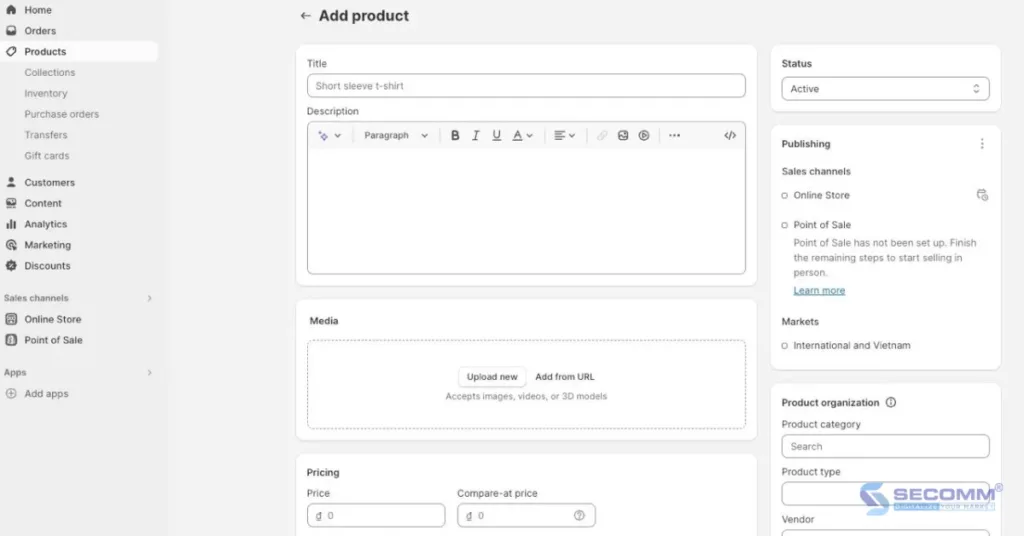
This doesn’t mean that the user experience of BigCommerce is less intuitive than the other. Both platforms are similar, providing drag-and-drop store editors, detailed documentation, and quick support. However, BigCommerce offers many built-in features that are expandable and customizable.
Users, though, may find themselves completing several different steps for each setup task, which can be overwhelming and time-consuming.
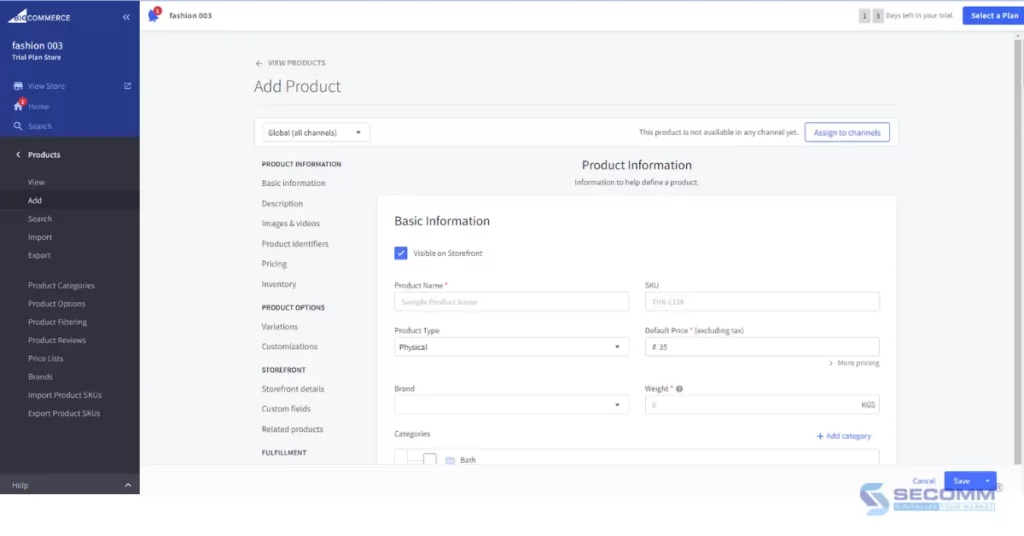
Staff Accounts
Shopify sets account staff limits for each pricing plan. Specifically, the Basic package allows 2 staff accounts, Shopify allows 5 staff accounts, and Advanced allows 15 staff accounts.
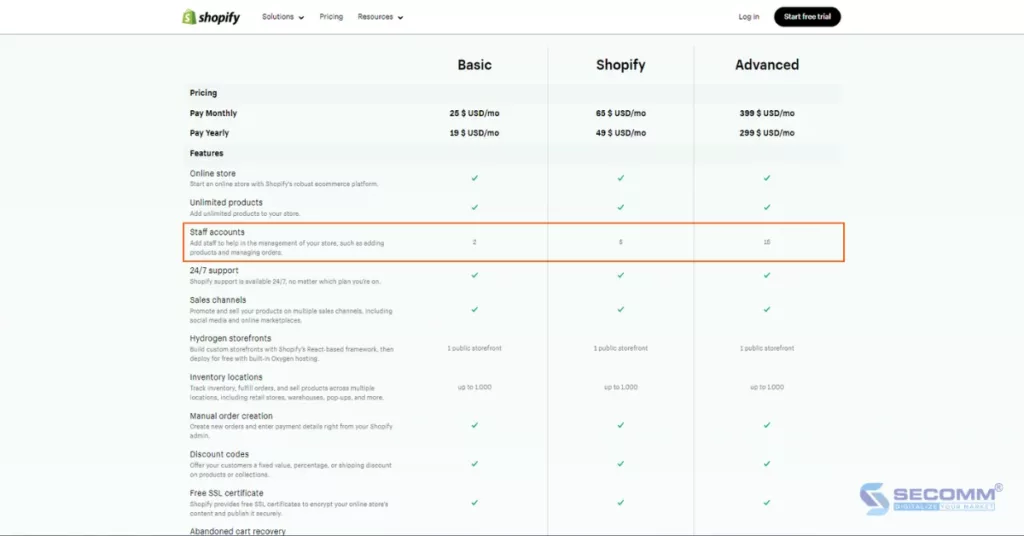
In this regard, BigCommerce has a significant advantage by providing unlimited account access for all solution packages. This flexibility can benefit businesses with many employees needing access to the eCommerce website system.
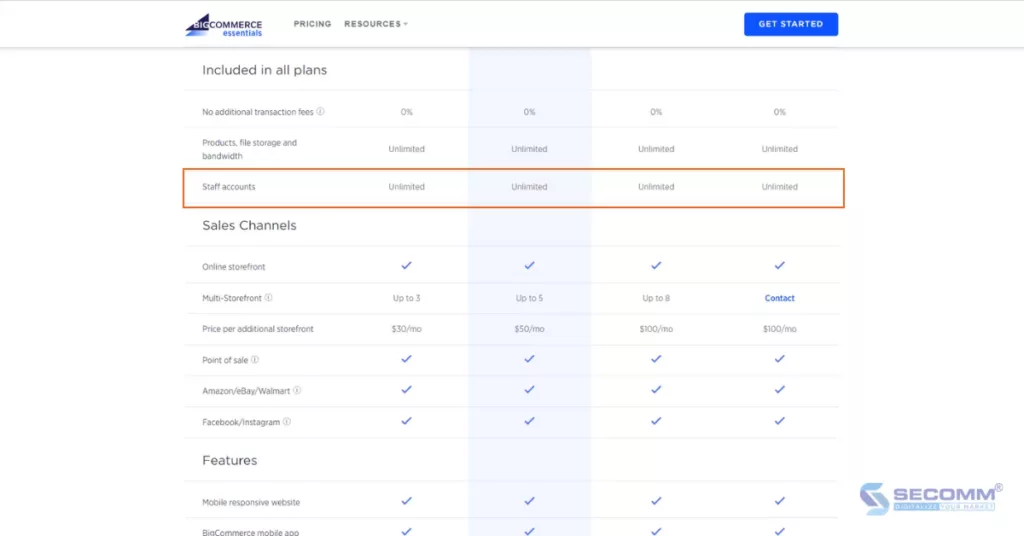
Pricing
- Pricing plans
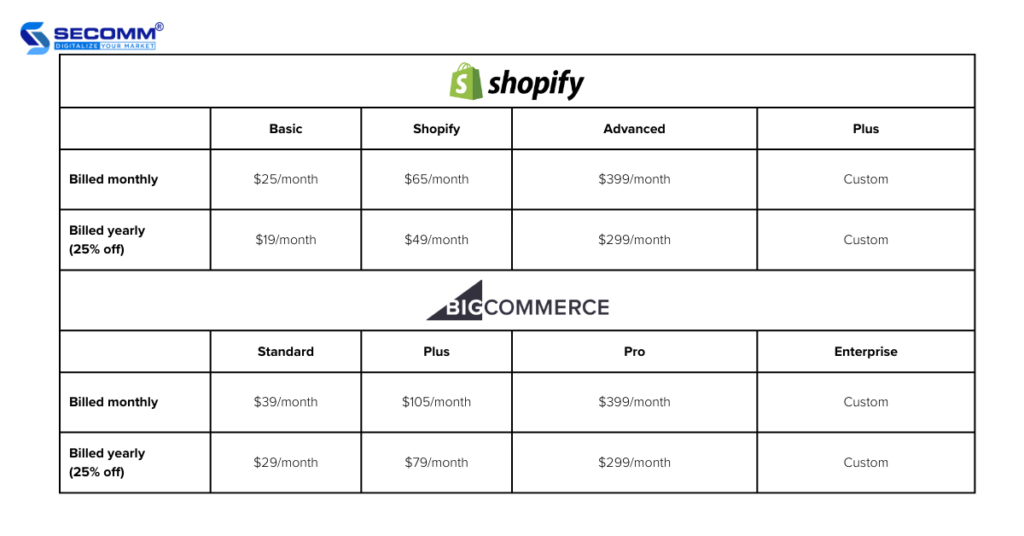
By using BigCommerce pricing plans, you can enjoy a 15-day free trial. The other offers a 3-day free trial for its 3 pricing plans, followed by a payment of only $1 per month for the initial 3 months. This gives you more time to experience the platform at a highly affordable cost.
- Transaction fee
The transaction fee is a drawback of Shopify. If you opt for third-party payment gateways, you’ll incur a transaction fee of 2%, 1%, and 0.5% for the Basic, Shopify, and Advanced plans, respectively. On the other hand, this fee is waived if you use Shopify Payments. However, Shopify Payments is limited to certain countries, some businesses may not have access. This, in turn, makes BigCommerce more appealing as it doesn’t impose transaction fees on any pricing plan.
Annual Sales Limits
BigCommerce sets annual sales limits to $50k for the ‘Standard’ plan, $180k for ‘Plus,’ and $400k for ‘Pro’, while the ‘Enterprise’ plan can be negotiated. To exceed these limits, you must upgrade to a higher pricing plan.
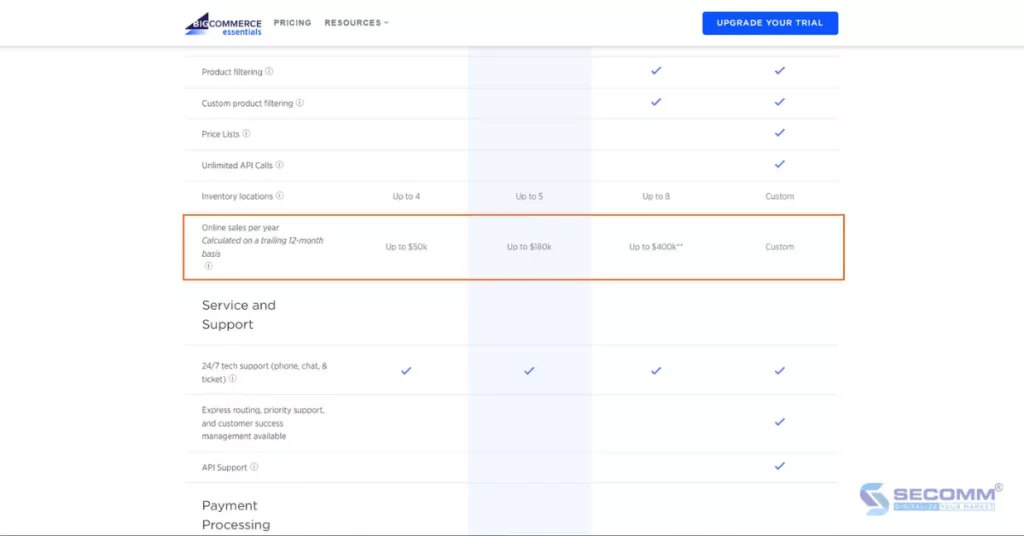
However, your business may not need the features offered in higher-tier plans and may be hesitant to pay additional fees for an upgrade. Therefore, the sales volume limit on the BigCommerce platform is a crucial factor that requires thoughtful consideration. In contrast, Shopify doesn’t impose any annual sales limits on any of its pricing plans.
Features
- Point of Sale (POS)
The POS feature isn’t limited to eCommerce transactions but also extends to traditional brick-and-mortar stores. Both BigCommerce and Shopify allow you to implement POS on mobile devices (smartphones, tablets) and other hardware (cash registers, barcode scanners).
To use POS with BigCommerce, you need to integrate with software like Clover, Vend, Square, PayPal Zettle, and others. Hence, if you are currently using a third-party POS system may appreciate the flexibility offered by BigCommerce.
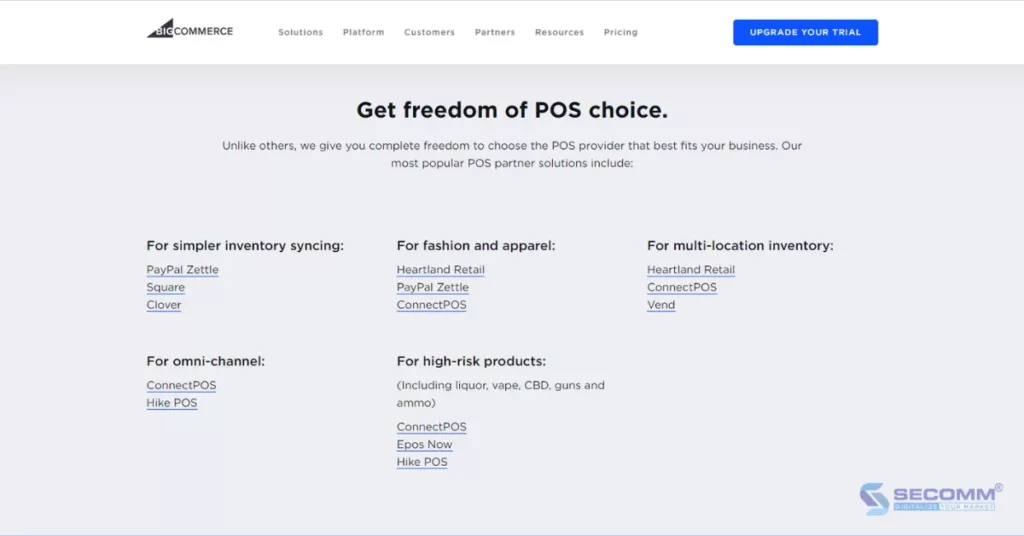
Conversely, Shopify offers built-in POS features, starting with the ‘POS Lite’ plan within its pricing plans. However, to access more advanced POS features, you can opt for the ‘POS Pro’ plan at $89 per month per location, added to the chosen pricing plan. If you choose the annual payment option, the ‘POS Pro’ plan is only $79 per month per location.
Shopify POS solution caters to diverse needs, including single-store transactions, multi-store transactions, event transactions, online and offline sales, as well as omnichannel operations.
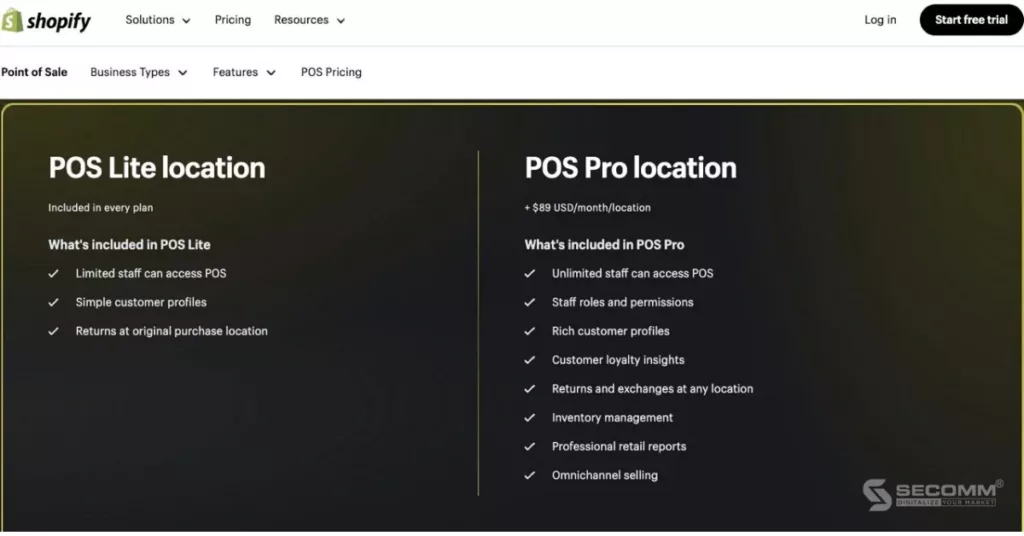
- Email Marketing
In eCommerce, email marketing is crucial when it comes to customer attraction and substantial sales growth. Hence, it’s a feature you should prioritize when selecting an eCommerce platform.
Beyond the Shopify POS solution, Shopify offers you the built-in Shopify Email feature, designed for Email Marketing campaigns and automating email processes (Welcome Email, Winback Email, Upsell Email).
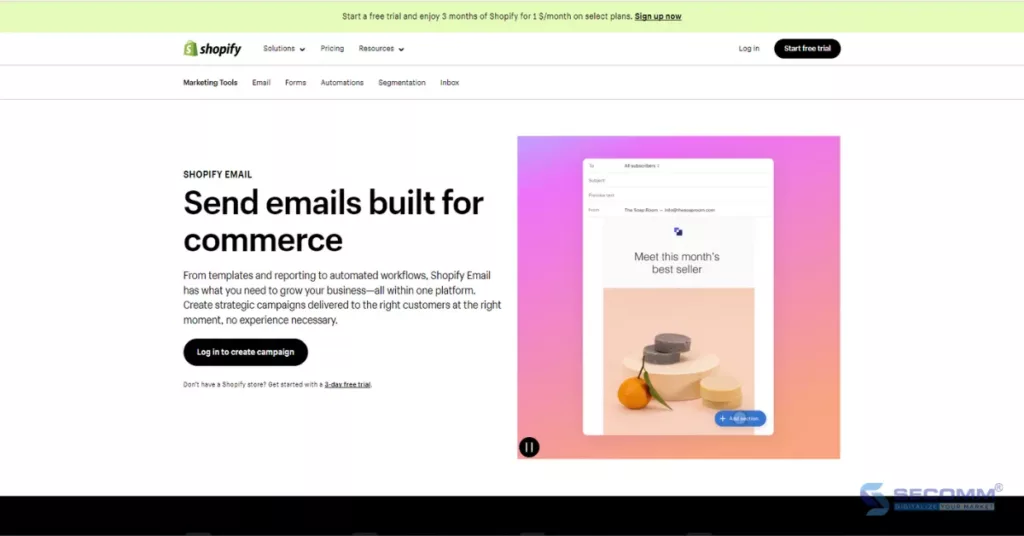
Meanwhile, for Email Marketing on BigCommerce, you need to integrate with third-party service providers like Klaviyo, MailChimp, Omnisend, and others.
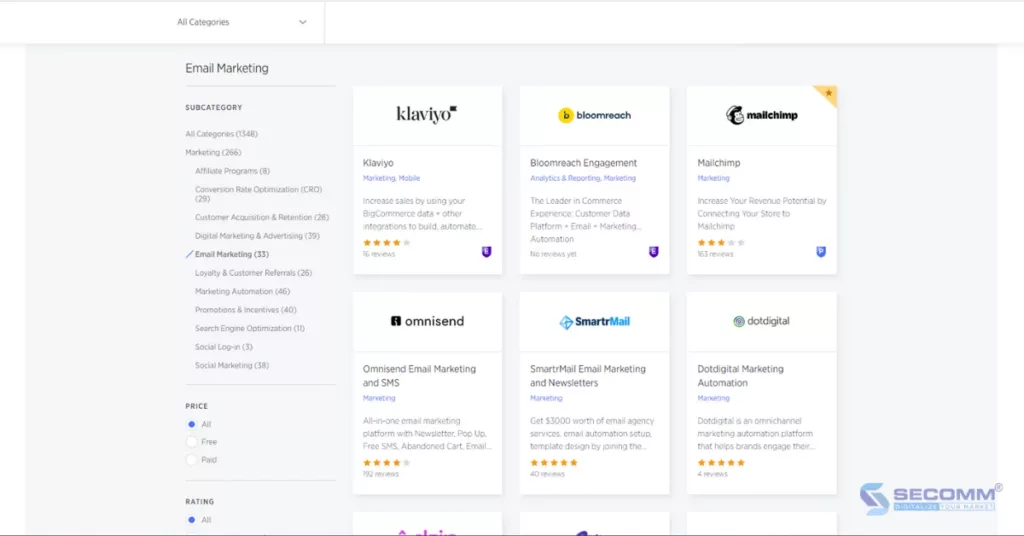
- Blogging
When you utilize blogging effectively, it can be one of the best sources to attract organic traffic. Both BigCommerce and Shopify come with built-in blogging features at a basic level, offering attractive templates that help you create SEO-optimized blog content to draw in potential customers. Moreover, you can seamlessly integrate with WordPress or other CMS platforms for more advanced blogging features
- Multilingual, multicurrency
Cross-border selling is currently a common goal for many eCommerce businesses. Fortunately, both Shopify and BigCommerce provide features and tools to help businesses expand into the global market
Shopify Markets, introduced in 2021, is a feature that allows you to select the specific markets you want to sell in. It’s an all-in-one feature that helps you centrally manage multiple local domains, languages, currencies, and payment gateways.
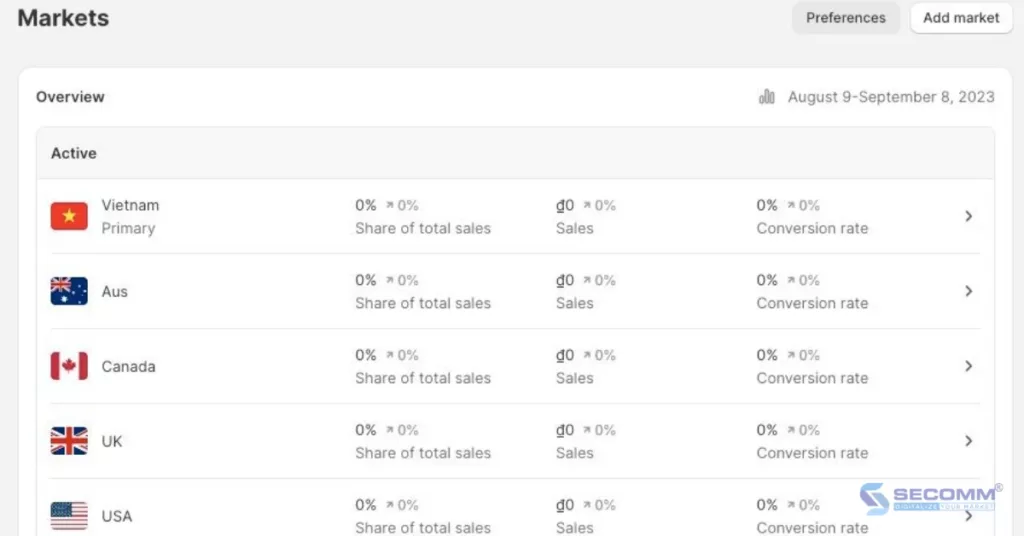
Plus, Shopify Markets utilizes the IP address of visitors outside the default ‘market’ that you previously defined to prompt them to select a location and the appropriate currency.
On the other hand, with BigCommerce, you can choose the currency for transactions on your eCommerce website instead of opting for a ‘market’ like Shopify. Additionally, the currency is automatically converted based on the customer’s IP address.
While language conversion capabilities are built into Shopify when the Shopify Markets feature is enabled, for BigCommerce websites, you’ll need to integrate with a third-party service to achieve the same, such as Weglot, which offers free conversion for 1 language and 2000 words. In contrast, Shopify provides free conversion for 20 languages across all pricing plans.
- Mobile app
While BigCommerce has only one app to help you manage sales, interact with customers, and access basic reports, Shopify you up to 3 apps to improve efficiency in eCommerce operations.
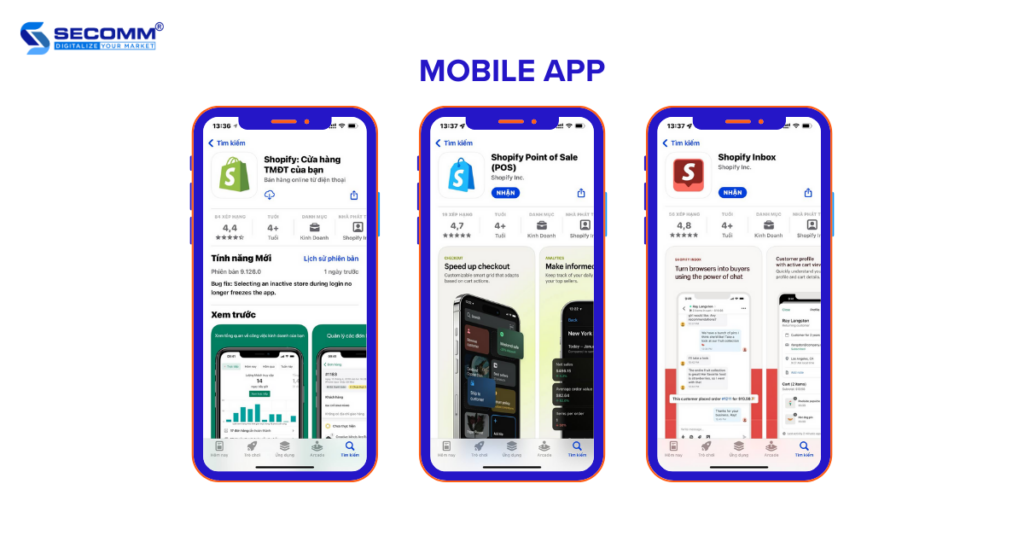
- Shopify: The main app for order and product management, along with viewing updated reports.
- Shopify POS: Manages online, offline, and omnichannel sales transactions.
- Shopify Inbox: Facilitates customer interaction, product sharing, and direct sales within the chat interface.
Themes & Apps
- Themes
Both BigCommerce and Shopify offer you a variety of free and paid themes. For BigCommerce, the platform provides 12 free themes, but in reality, there are around 5-6 distinct free themes as the layouts are quite similar. As for paid themes, BigCommerce has approximately 185 themes ranging from $150 to $400 per theme.
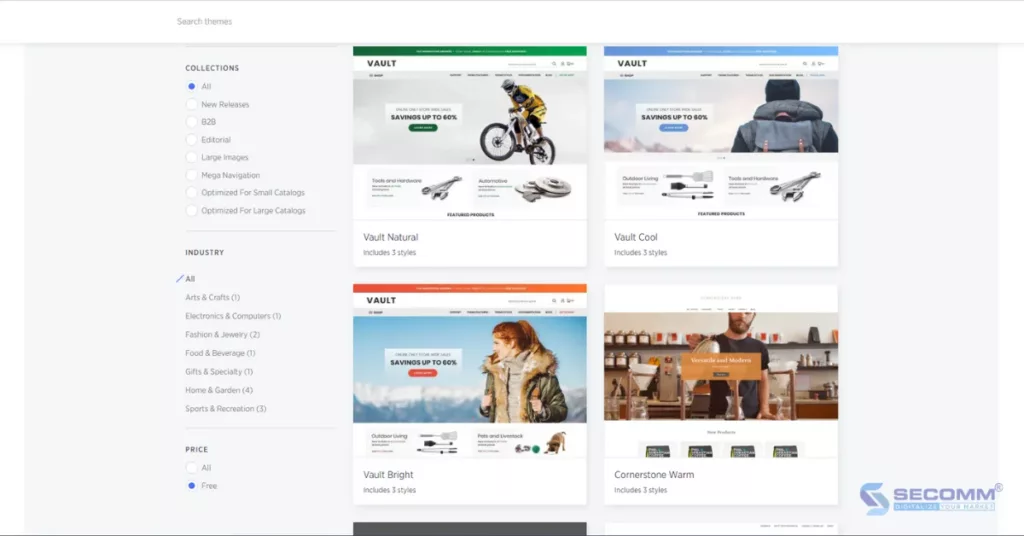
On Shopify, the platform offers 12 free themes and 141 paid themes with prices ranging from $170 to $380 per theme. Both Shopify and BigCommerce provide users with drag-and-drop theme editors to modify layouts, colors, fonts, and text sizes and add/remove elements and widgets.
However, Shopify’s themes, both free and paid, are widely favored for their modern and contemporary styles. Additionally, Shopify offers a diverse selection of fonts for you to choose from. In contrast, BigCommerce has around 8 font options.
- Apps
Alongside their built-in features, Shopify and BigCommerce both offer extensive app stores to help you optimize your eCommerce activities. Both app stores offer free versions of apps, but certain features may be limited. To access the full functionality, you’ll need to subscribe to the paid versions, which often involve monthly fees. The number of apps available on Shopify and BigCommerce differs significantly, with Shopify boasting over 6000 apps, while BigCommerce has over 1000.
Customer Support
In the process of deploying an eCommerce website, both BigCommerce and Shopify offer 24/7 support through hotlines, chat, and email. Plus, if you seek advice and support in addressing specialized issues related to technology, design, and marketing, BigCommerce provides Partner Directory services, while Shopify offers Shopify Experts.
Final Thoughts
Above are the comparisons between Shopify and BigCommerce. However, it’s challenging to determine which platform is the best in 2023 for developing an eCommerce website. The choice will depend on your specific needs and wants.
With years of experience advising and collaborating with numerous businesses both domestically and internationally on implementing eCommerce websites on both Shopify and BigCommerce, SECOMM has gathered valuable insights to help your business streamline your eCommerce development process, optimize your website performance, and swiftly generate conversions.
Contact SECOMM today or call directly at the hotline 028 7108 9908 for free and detailed consultations.
 2
2

 7,301
7,301

 0
0

 1
1
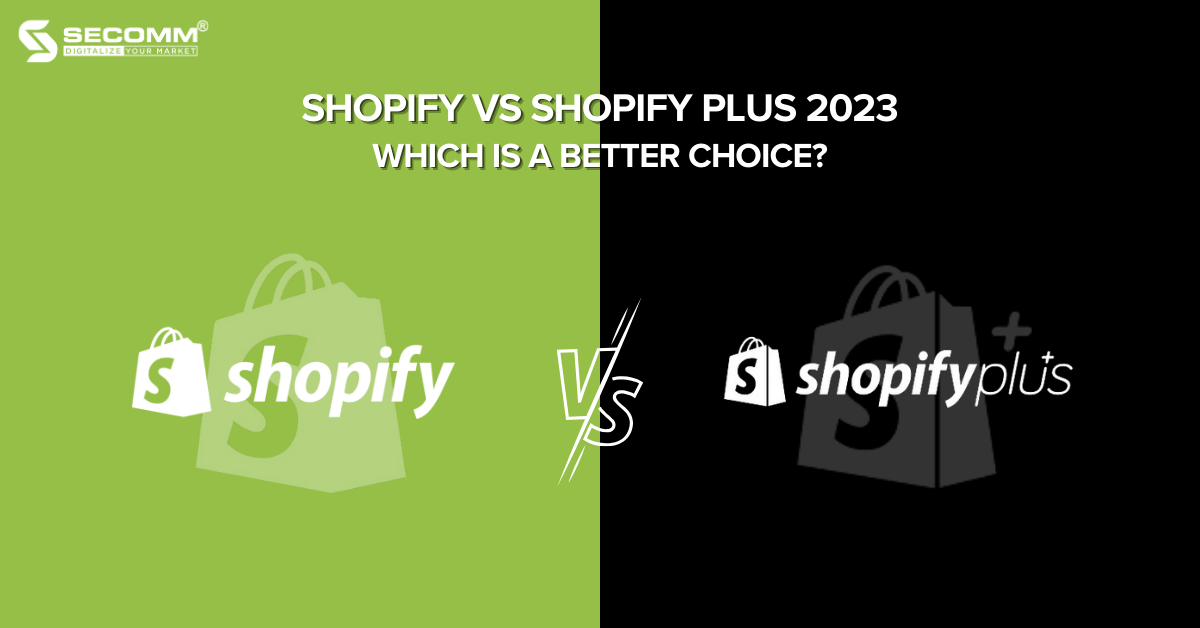
SHOPIFY VS SHOPIFY PLUS 2023: WHICH IS A BETTER CHOICE?
Shopify and Shopify Plus are two leading eCommerce platforms globally, used by millions of businesses to deploy eCommerce websites. The Shopify platform is designed for small and medium-sized enterprises, providing basic, user-friendly features for building and managing eCommerce websites. According to Builtwith, over 4 million active Shopify stores are currently worldwide.
On the other hand, Shopify Plus is specifically crafted for large-scale enterprises, offering advanced features, customization options, and flexible scalability. Builtwith statistics indicate that there are over 44 thousand active Shopify Plus websites globally.
What are the differences between Shopify and Shopify Plus? Which platform should you choose to build your eCommerce websites? This article will focus on clarifying the differences between Shopify and Shopify Plus in three aspects: cost, features, and support capabilities, to help you choose the most suitable platform for your needs and goals.
Shopify vs Shopify Plus: Pricing
The first distinction and crucial criterion to consider between Shopify and Shopify Plus are the license fees and transaction fees. Shopify and Shopify Plus offer different solution packages with varying pricing to suit businesses with different budgets and scales.
Shopify Pricing
Shopify offers three main pricing plans: Basic, Shopify, and Advanced, priced at $25, $65, and $399 per month, respectively. Also, Shopify has a special solution package called Shopify Starter at $5/month, enabling you to sell on social media and chat apps.
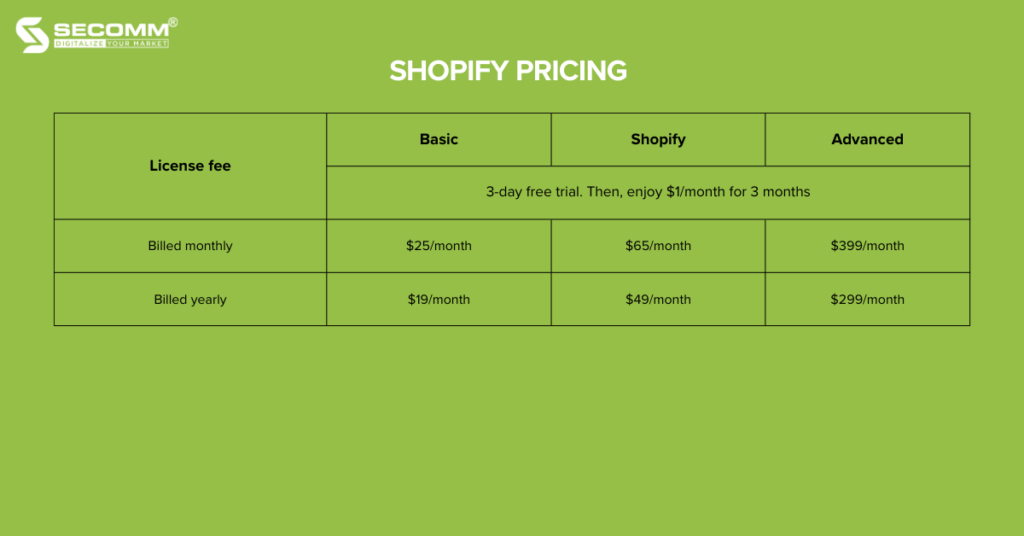
*Note: The mentioned fees apply to the Vietnamese market, and platform license fees may vary depending on the region or country.
Beyond the license fees, you also need to consider the transaction fee when using different payment methods. Shopify offers its payment method called Shopify Payments, allowing you to effortlessly accept all major payment methods on your eCommerce website.
If using Shopify Payments, you don’t have to pay any transaction fee to Shopify.
On the other hand, If you don’t use Shopify Payments and select one of many third-party payment service providers supported by Shopify, you’ll pay transaction fees of 2%, 1%, and 0,5% for the Basic, Shopify, and Advanced plans, respectively.
Shopify Plus Pricing
Since Shopify Plus is designed for large businesses, the pricing structure for the Shopify Plus package is variable and depends on the individual deployment requirements and revenue of each business. According to Shopify, the initial cost for using Shopify Plus is $2,000/month, with subsequent increases based on monthly revenue.
Specifically, when the revenue of a Shopify Plus store reaches $800,000/month, the platform will apply a charge of 0.25% of the monthly revenue. It’s worth noting that the fee will not exceed $40,000/month and $480,000/year.
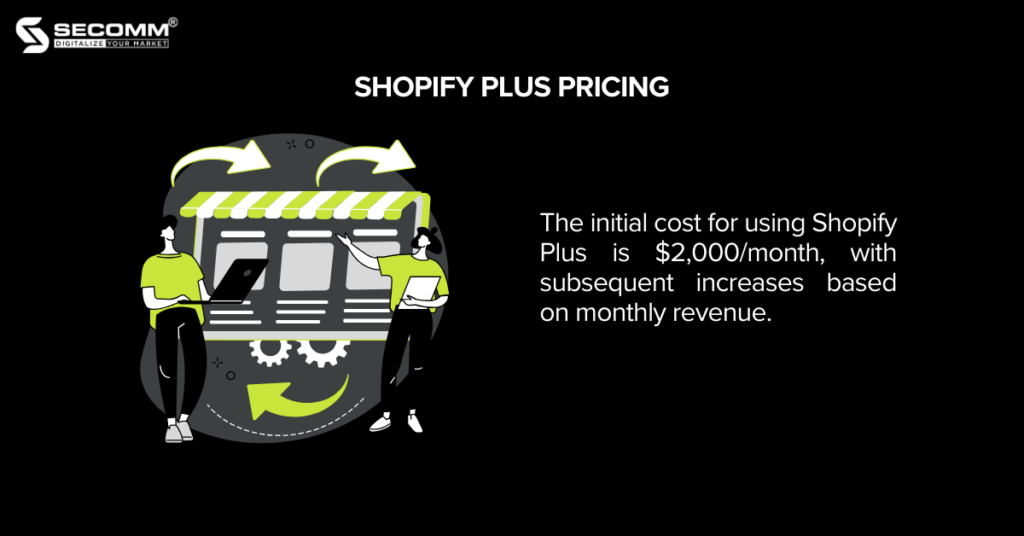
Similar to the Shopify pricing plans, Shopify Plus supports both Shopify Payments and third-party payment service providers. However, the transaction fees associated with Shopify Plus are lower compared to regular Shopify plans. If you don’t use Shopify Payments, you’ll incur a transaction fee of 0.15% on each transaction.
Shopify vs Shopify Plus: Feature
When it comes to features, Shopify Plus excels by providing a range of advanced features for you to customize your eCommerce websites, aiming to deliver a unique experience for customers.
Related Reading: 6 key Shopify Plus features
Custom checkout page & cart
Most Shopify businesses typically utilize either the available free or paid themes on Shopify, encountering several limitations when customizing the checkout or cart pages. However, with the implementation of Shopify Plus, you can leverage Shopify Scripts to tailor small code segments, enabling the creation of a personalized shopping experience for customers at the cart and checkout pages.
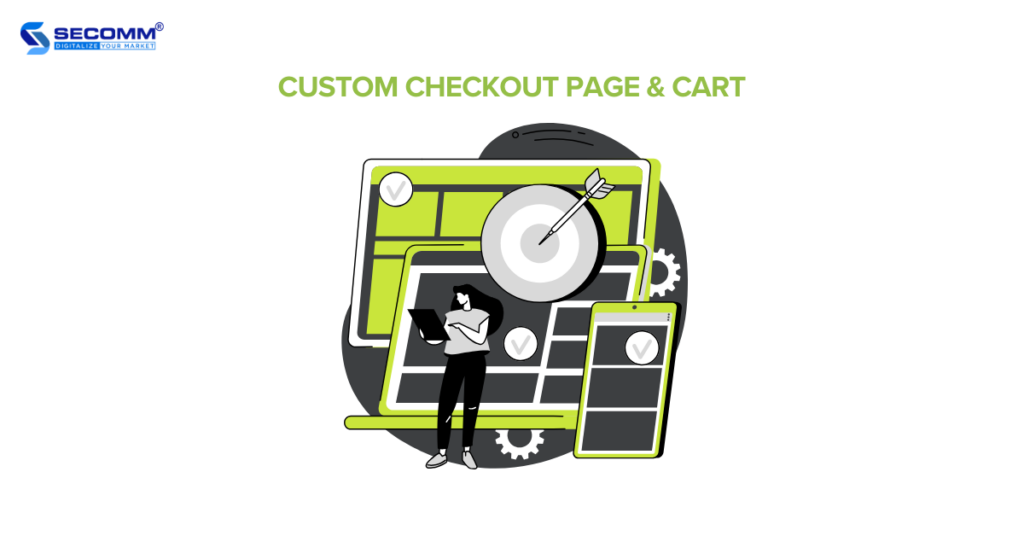
Automation
The Shopify pricing plans provide a set of built features for businesses to automate eCommerce and marketing operations. On the other hand, with the deployment of Shopify Plus, businesses can utilize specialized tools to automate eCommerce processes, such as:
- Shopify Flow: The most advanced eCommerce automation tool recommended by Shopify for all businesses implementing Shopify Plus.
- LaunchPad: An automated scheduling tool for running promotional campaigns, flash sales, or launching events for new product releases.
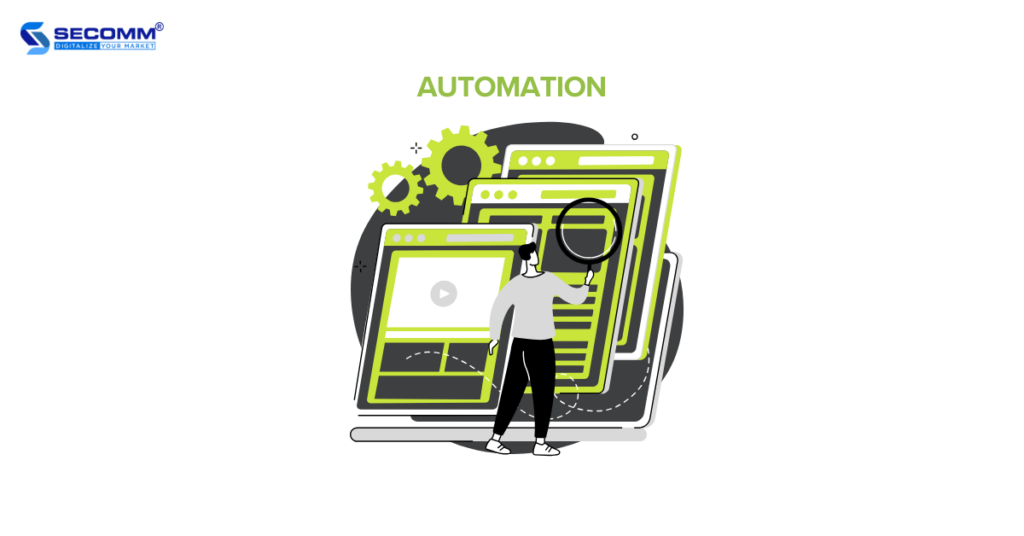
Shopify POS
For all Shopify businesses, the Shopify POS feature is included in the standard service package known as POS Lite, but it has limitations in terms of features and POS usage locations. To unlock more advanced features and extend the POS capabilities, Shopify businesses need to upgrade to the POS Pro package, priced at $89 per month per location.
On the other hand, Shopify Plus businesses enjoy free access to POS Pro for their initial 20 locations. This implies that businesses implementing Shopify Plus can leverage advanced POS features, including BOPIS deployment, unlimited user accounts, omnichannel selling, inventory management, and more.
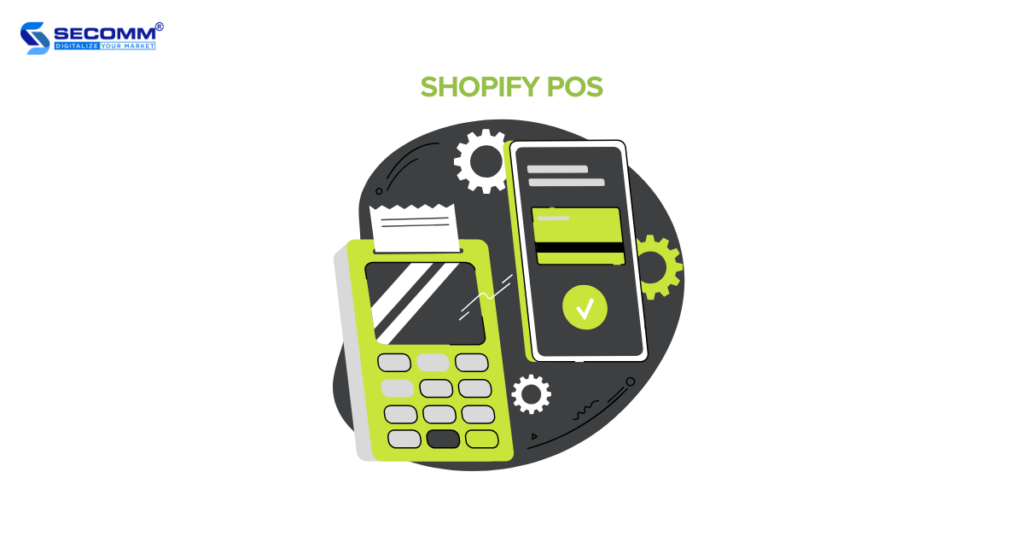
B2B Feature
This feature is specifically designed for Shopify Plus businesses, facilitating B2B transactions directly through the eCommerce website without reliance on third-party apps or alternative solutions. You can set up catalogs, payment terms, and company profiles, and customize prices specifically for B2B customers.
This provides the flexibility to develop a website that serves B2B and B2C customers or craft a specialized platform dedicated to B2B clients.
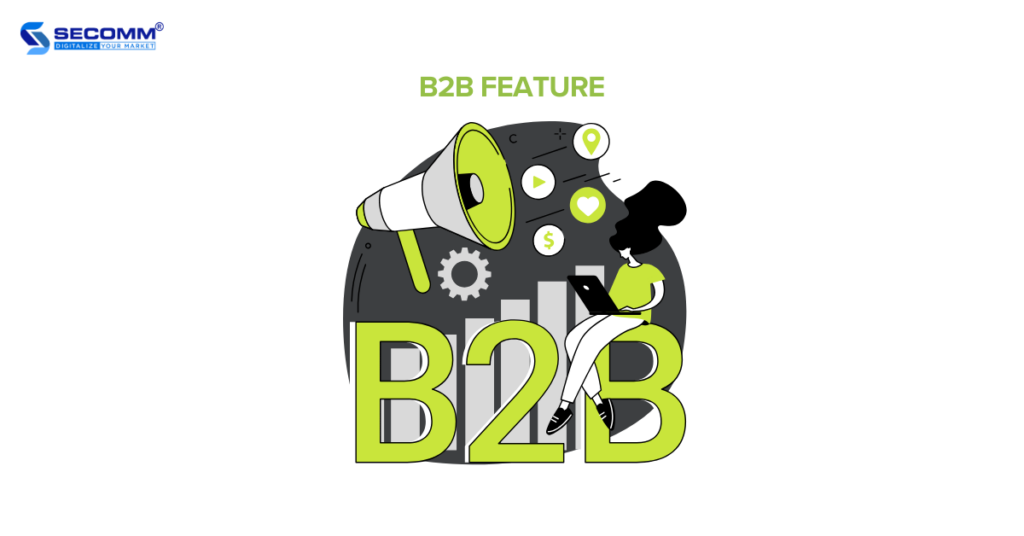
Wholesale feature
The wholesale feature is specifically designed for Shopify Plus merchants. This feature allows you to customize the wholesale website interface differently from the regular eCommerce site, adjust pricing, and establish a distinct ordering process specifically for wholesale customers. You can also choose to showcase products intended for wholesale transactions exclusively on the Shopify Plus wholesale website.
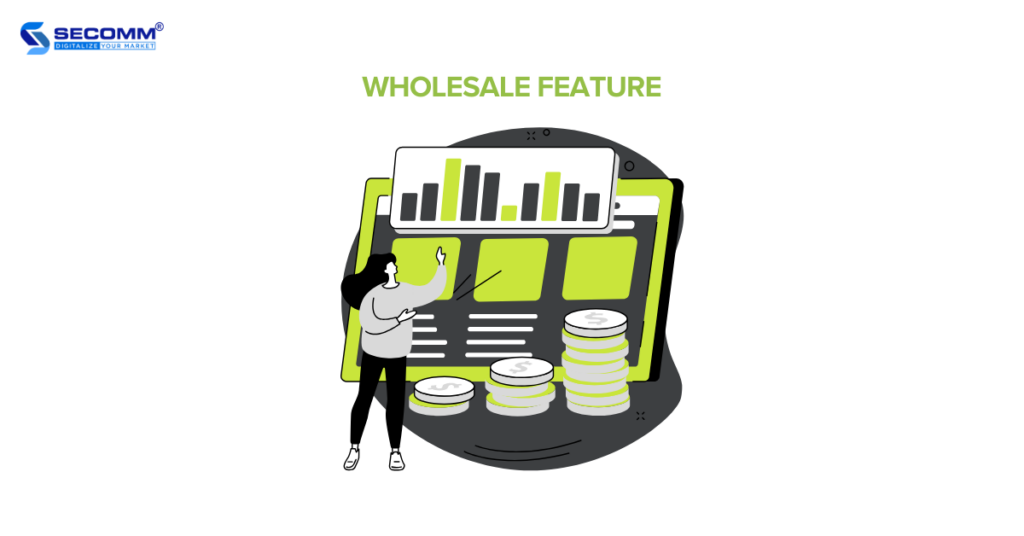
Shopify vs Shopify Plus: Resources
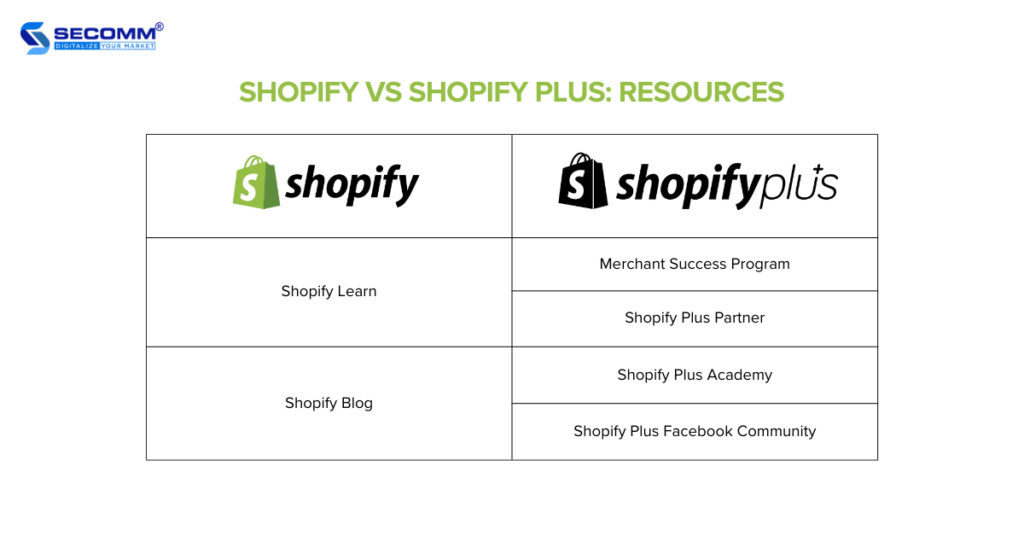
Shopify
For Shopify businesses, they can access support 24/7 throughout the entire process of building and advancing their eCommerce website through channels like the hotline, email, or chatbox. Additionally, Shopify provides resources for businesses to enhance their eCommerce operations, including:
- Shopify Learn: Numerous free online courses featuring leading experts in eCommerce, including Daymond John, a renowned figure from the popular TV show Shark Tank. The courses cover topics such as goal setting, effective marketing, sales strategies, and efficient customer care.
- Shopify Blog: The blog articles on Shopify delve into the latest trends in eCommerce marketing. These regularly updated posts, enriched by the unique perspectives of top experts, can prove valuable for startups or businesses venturing into the realm of eCommerce.
Shopify Plus
In addition to the support services available through the hotline, email, or chatbox, businesses utilizing Shopify Plus enjoy enhanced access to educational resources and support:
- Merchant Success Program: This program connects businesses with Shopify’s specialized team, offering assistance throughout the implementation of their eCommerce website, covering aspects such as customization and integration.
- Shopify Plus Partner: A collaborative platform for developers, solution providers, and technology experts, facilitating the deployment of eCommerce solutions specifically tailored for Shopify Plus.
- Shopify Plus Academy: Offering a variety of courses and webinars, this resource helps businesses optimize the development of their Shopify Plus website.
- Shopify Plus Facebook Community: A dedicated space for Shopify Plus businesses to connect, share practical insights, discuss business solutions, and explore potential collaborations.
Shopify vs Shopify Plus: Which version is right for you?
Here is an overview of the significant differences between Shopify and Shopify Plus platforms. The decision on which platform is most suitable depends on each business’s scale and deployment requirements.
For startups or small to medium-sized enterprises with minimal customization requirements and a desire for quick product launches, regular Shopify solutions may be more suitable.
On the other hand, large-scale enterprises with high integration and customization needs should prioritize Shopify Plus.
With years of experience deploying Shopify Plus eCommerce websites for leading businesses such as Vinamilk and Suzuverse, SECOMM boasts a professional team with exceptional technical skills and in-depth knowledge of the Shopify Plus platform.
Contact SECOMM or call the hotline at 028 7108 9908 to deploy Shopify Plus today!
 2
2

 3,246
3,246

 0
0

 1
1
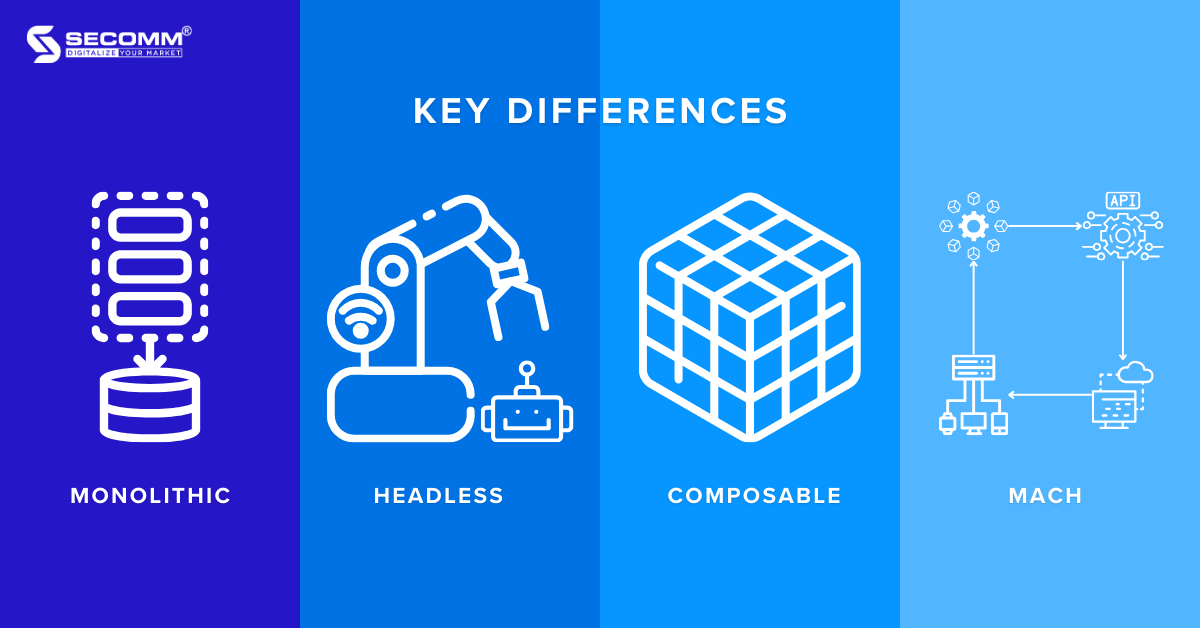
MONOLITHIC, HEADLESS, COMPOSABLE, OR MACH ARCHITECTURE
The eCommerce sector is experiencing rapid growth, with global retail sales reaching 5.7 trillion USD in 2022 and projected to hit 6.3 trillion USD in 2023, as reported by Insider Intelligence. This requires businesses to adopt more efficient and flexible eCommerce architectural solutions to meet customer demands for online shopping experiences.
However, there is no one-size-fits-all eCommerce architectural solution. Each architecture comes with its own set of advantages and disadvantages, catering to different goals and requirements. Hence, businesses must discern between eCommerce architectures to choose the most fitting one for their business model.
This article will introduce the four most common eCommerce architectures: Monolithic, Headless, Composable, and MACH. Also, it’ll compare and evaluate these architectures based on criteria such as cost, scalability, customization, security, and performance.
Monolithic Architecture
Monolithic architecture is a traditional and long-standing model in eCommerce development. In this approach, the entire eCommerce website is built as a unified application on a single source codebase.
This means that both the user interface (frontend) and business logic (backend) are combined and implemented within a comprehensive “all-in-one” system. So, modifications to specific eCommerce components may have repercussions on the overall functionality of the system.
Pros:
- Ease of Deployment: Utilizing the monolithic architecture simplifies the management of a single source codebase and a unified database system for the entire application. This streamlines the processes of deployment, updates, and application modifications.
- Performance: eCommerce components are tightly connected, so for a simple and uncomplicated system, the Monolithic architecture can provide high performance.
Cons:
- Limited Scalability: The monolithic architecture, being a unified block, faces challenges in scalability and customization, especially as the system grows larger and more complex.
- Maintenance and Updates Difficulty: The tight integration of components within the system makes challenges in maintaining a website under a Monolithic architecture, making it both challenging and costly. Also, any modifications or updates to one component can impact others and the overall system’s functionality.
- Innovation Constraints: While traditional eCommerce architectures are considered stable and reliable, their limitations in scalability and customization make it difficult to keep up with the latest technological advancements.
- Increasing Costs: Initially, implementing a Monolithic system may not be overly complex or expensive. However, as businesses aim to scale, customize, or perform maintenance and updates, costs tend to escalate significantly.
The Monolithic architecture can be used in case your business is implementing a small-scale, straightforward eCommerce system, seeking a rapid market launch without immediate plans for significant future development. However, architectures like Headless or Composable would be more appropriate as the system grows and expands, requiring increased customization and scalability
Headless Architecture
The Headless architecture is a popular architectural solution in eCommerce, where the user interface (frontend) of the eCommerce website is decoupled from the operational system (backend). The Headless architecture is often called “API-first” because the frontend and backend communicate with each other through an API layer.
Many businesses opt for the Headless Commerce model to create and customize user interfaces (frontends) to provide customers with a rich and seamless shopping experience across various channels such as websites, mobile apps, IoT, and POS. These user interfaces can connect to a single backend system through an API layer, enabling businesses to engage in multi-channel commerce and rapidly expand internationally.
Pros:
- Flexibility: Businesses can utilize any technology and tools to develop the frontend, creating a unique and customized user interface and shopping experience without being restricted by predefined themes.
- Ease of Integration: Seamless connection and integration with third-party tools and services through APIs, eliminating the need to rewrite source code.
- High Performance: Since the frontend and backend operate independently, businesses can optimize performance for both, enhancing the overall performance and page loading speed of the eCommerce website.
- Scalability: Businesses can easily customize, add, or remove components of the frontend or backend flexibly without affecting the overall system’s operation.
Cons:
- Complex Deployment: Because the frontend and backend are separated and developed independently, the deployment process is more time-consuming compared to Monolithic, and ensuring the interaction and efficient operation of both parts can be challenging.
- Specialized Expertise: Headless Commerce allows seamless integration with third-party technologies and systems, requiring technical skills and knowledge of APIs, as well as a certain understanding of different systems.
- High Costs: Utilizing various third-party services implies additional expenses, alongside costs for the development and maintenance of the system.
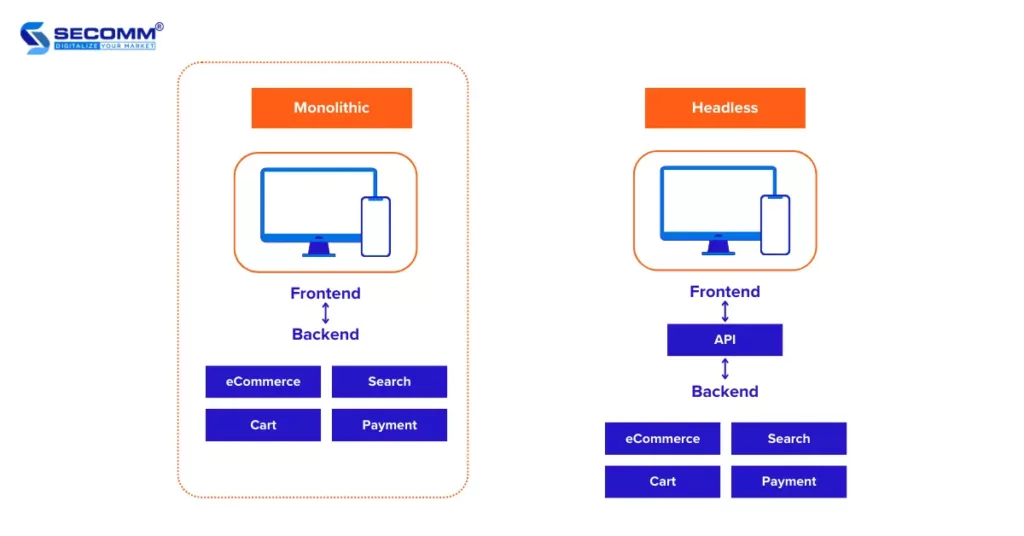
Deploying Headless Commerce may be suitable for businesses that require flexibility to create and customize multiple user interfaces for multi-channel sales purposes and expand their business globally. In particular, businesses that demand independent development of both frontend and backend, as well as the need for integration with various third-party systems, should prioritize the Headless architecture.
Composable Architecture
If the standout feature of the Headless architecture is the separation of frontend and backend, providing scalability and flexible customization, then the Composable architecture, also known as Module-driven architecture, takes it a step further by decoupling all eCommerce components such as Search, Payment, Cart, etc.
This allows businesses to select components and package them into Packaged Business Capabilities (PBC) to create a specialized and comprehensive eCommerce website solution.
Pros:
- High Flexibility: Implementing Composable Commerce allows businesses to integrate components that best suit their deployment needs. This enables businesses to stay abreast of the latest eCommerce development trends.
- High Customization and Scalability: Components are developed independently, and altering any component does not impact the others. Similarly, customizing and expanding components to meet business objectives can be done without the need to overhaul the entire system architecture.
- Ease of Maintenance: With components in the eCommerce system being separate and developed entirely independently, maintaining and updating each component individually becomes more straightforward, avoiding disruptions or temporary halts to the system’s operation.
- Vendor Independence: The flexibility to seamlessly integrate components from various providers has helped businesses deploying Composable Commerce avoid dependence on a specific service provider. This allows businesses to change providers for any component whenever needed, while also leveraging the latest and optimal technologies for their eCommerce system.
Cons:
- High Costs: The cost of using each component varies, so the more components integrated, the higher the overall cost, not to mention maintenance costs for each component.
- High Expertise Requirements: Implementing Composable Commerce requires advanced technical skills and specific knowledge of the technologies in use to ensure a quick and effective deployment process.
- Complex Management: Utilizing numerous components means that a business has to work with multiple different providers, each with its own security protocols and compliance requirements. As the eCommerce system scales up, the business needs to collaborate with providers to ensure that each component is developed, expanded, and remains compatible, preventing any negative impacts on the system.
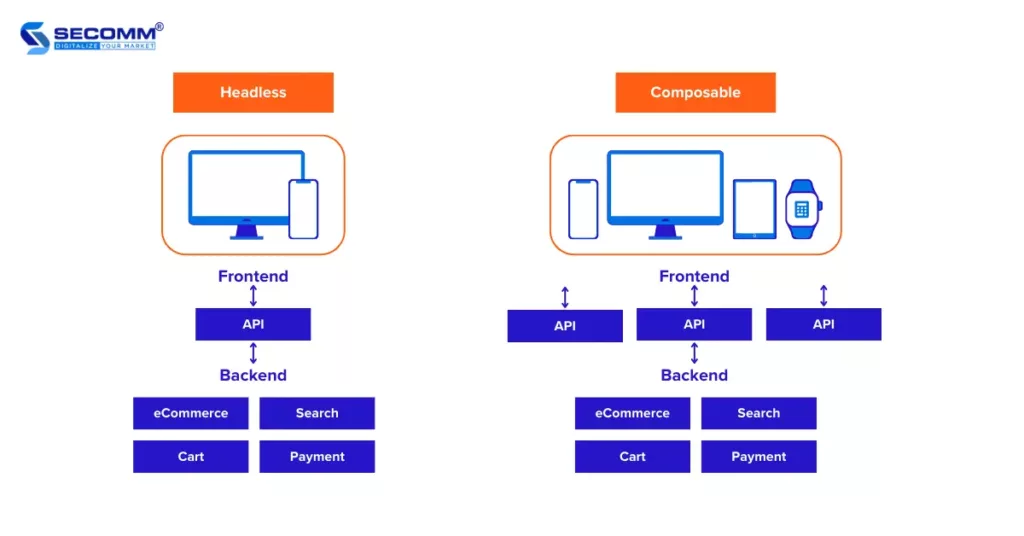
Composable architecture is suitable for cases where businesses undertake large projects, have high demands for flexibility and customization, need to integrate multiple services and third-party systems, as well as require complete independence between the components of the eCommerce system.
MACH Architecture
The MACH architecture is the most modern approach for building and developing highly flexible eCommerce websites. This architecture allows businesses to integrate leading technologies into a single system, incorporating Microservices-based, API-first, Cloud-native, and Headless components.
- M (Microservices-based): Independent small applications are developed, deployed, and managed separately. These applications are designed to perform specific business functions.
- A (API-first): All components of the eCommerce system are connected through an Application Programming Interface (API), enabling different components to operate efficiently within the same system.
- C (Cloud-native): The development of the eCommerce system takes place in the cloud, providing a scalable infrastructure, and technology services are automatically updated by the provider.
- H (Headless): Implementing Headless allows the separation of the user interface (frontend) and the operational system (backend) for eCommerce website deployment. This enables the creation and customization of unique and seamless user experiences.
Pros:
- High Flexibility: Businesses can choose and modify tools and services according to business needs, making it easy to customize and expand services when there is a need to scale the business.
- Easy Integration: APIs are at the core of the MACH architecture, facilitating easy connections with third-party services and applications.
- High Performance and Security: Because businesses can leverage state-of-the-art technologies, it ensures system operational performance, page loading speed, user experience, and high security.
Cons:
- High Complexity: The separation of many components and technologies makes the deployment of the MACH architecture complex. This requires high technical skills and experience to ensure an effective deployment, management, and operation of the system.
- High Costs: Integrating multiple technologies or incorporating various third-party services can result in higher expenses, such as integration fees, training fees, or hiring a deployment team, along with maintenance and update-related costs.
MACH architecture is suitable for businesses with ample budgets aiming to implement large projects based on the four MACH technologies and with high requirements for customization and scalability. It is also beneficial if they have in-house expertise or collaborate with highly specialized development teams.
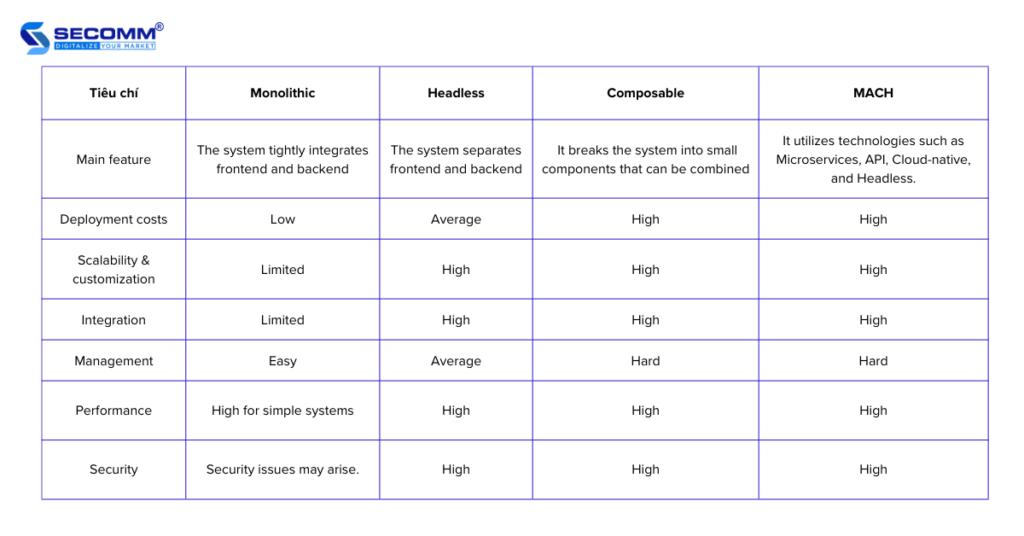
Monolithic, Headless, Composable and MACH: Which is the right choice?
Above is a summary of the essence of the four eCommerce website deployment architectures: Monolithic, Headless, Composable, and MACH. While Monolithic may seem outdated and has many limitations, the Composable and MACH architectures are innovative, providing more optimal and flexible development solutions, but their deployment and operation processes are complex, requiring a highly skilled development team. Therefore, Headless becomes a valuable architectural solution compared to the other three choices for implementing eCommerce websites at the current time.
Headless Commerce is the most popular solution today, with a 25% increase in demand for Headless Commerce deployment in the past two years. Implementing Headless allows businesses to create a customized and multi-channel user experience by integrating with leading tools and technologies. To effectively develop Headless Commerce, businesses need to collaborate with a development team with high skills and expertise, as well as a well-thought-out strategy.
With extensive technical experience and high expertise in the e-commerce field, SECOMM has successfully consulted and implemented Headless Commerce for leading businesses such as Vinamilk, and Suzuverse, based on one of Shopify’s three solutions:
- Shopify Hydrogen + Oxygen: This superior solution includes the Hydrogen framework based on React and the Oxygen hosting, enabling businesses to quickly and effectively deploy an eCommerce website using the Headless architecture.
- Commerce Components: A breakthrough tech stack developed specifically for large enterprises implementing Headless Commerce or Composable Commerce. This solution allows businesses to integrate independent components to customize and enhance the eCommerce experience.
Contact SECOMM or call directly on the hotline (02871089908) to explore how we can support businesses in maximizing the potential of Headless Commerce and enhancing competitiveness in the eCommerce market.
 2
2

 5,175
5,175

 0
0

 1
1
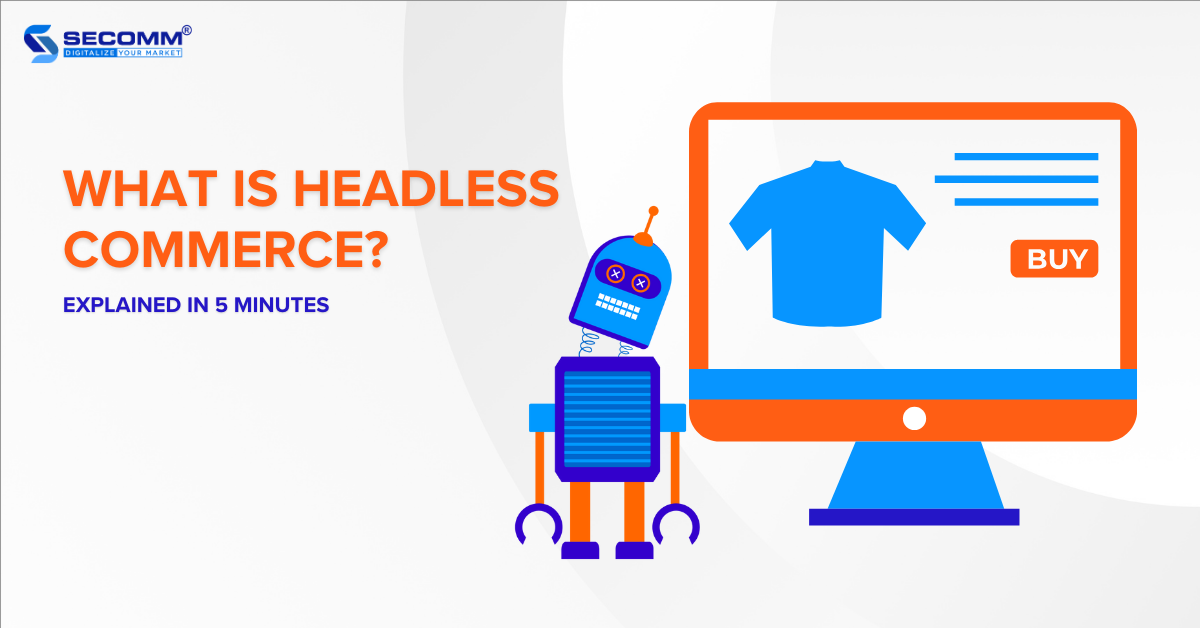
WHAT IS HEADLESS COMMERCE? EXPLAINED IN 5 MINUTES
When learning the significant changes in eCommerce over the past decade, one concept that cannot be ignored is Headless Commerce. It isn’t a mere trend; rather, it presents a revolutionary solution for how businesses implement eCommerce, aiming to provide flexibility and enhanced efficiency in delivering a seamless shopping experience for customers.
The following statistics contribute to proving that Headless Commerce is one of the fastest-growing trends in eCommerce:
- Headless Commerce deployment has increased by 50% in the past two years.
- By 2025, 35% of businesses plan to transition from the Traditional Commerce model to Headless Commerce.
- 60% of top retailers in North America are predicted to implement Headless by 2025.
- Headless Commerce platforms have seen a 40% increase in usage during the Covid period.
- Businesses implementing Headless report a 20% reduction in website loading time and an average revenue increase of 24%.
So, what is Headless Commerce, and why is it considered a modern and flexible approach to eCommerce deployment? Let’s explore this in the following article.
What is Headless Commerce?
Headless Commerce is an eCommerce architecture that separates the user interface (Frontend) from the data management and functionality (Backend) of an eCommerce website. This separation allows the frontend and backend to be built entirely independently and connected through eCommerce Application Programming Interfaces (APIs).
Going Headless allows you to use any technology or tool you prefer to design and customize the user interface without being dependent on the existing eCommerce platform. You can also update and modify the backend without affecting the frontend.
Learn more: Everything to know about eCommerce APIs
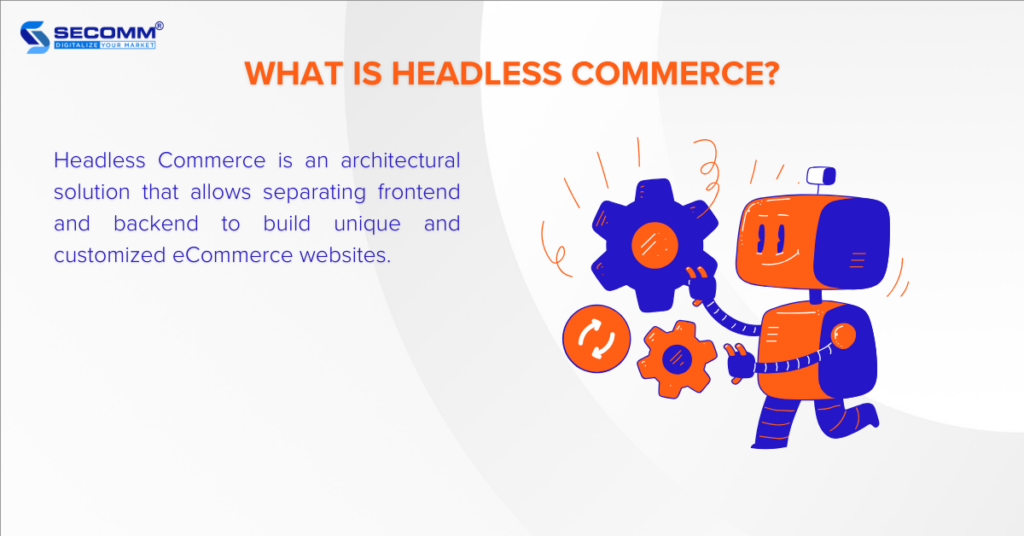
What is the difference between Headless Commerce and Monolithic Commerce?
Trước khi giải pháp Headless Commerce, hầu hết các website thương mại điện tử đều được xây dựng với kiến trúc Monolithic – tức là phần frontend và backend được liên kết chặt chẽ với nhau trong một hệ thống duy nhất. Đây là cách tiếp cận truyền thống và đơn giản, giúp doanh nghiệp dễ dàng xây dựng và quản lý website thương mại điện tử của mình.
However, Monolithic Commerce comes with several limitations, especially when you aim to develop and scale your eCommerce systems. Some common issues encountered when implementing Monolithic Commerce include:
- Limited Customizations: The tight integration between the frontend and backend in Monolithic Commerce imposes constraints when you want to redesign or modify features on your website. So, you have to customize both parts which leads to compatibility and performance issues.
- Limited Scalability: When an eCommerce website experiences a significant increase in the number of products, transactions, and traffic, you need to upgrade and expand the system to meet the growth requirements. The Monolithic architecture makes this process difficult and expensive, as you are required to update the entire system, potentially resulting in a temporary suspension of eCommerce website operations
- Lack of innovation and competition: In the digital age, you should update your eCommerce websites with new technological trends to innovate and enhance, aiming to attract and retain customers while gaining a competitive edge. However, the Monolithic Commerce model hinders this process, as any minor change can affect the entire system, potentially causing unintended errors or issues and requiring a slow and cautious approach.
In contrast to Monolithic Commerce, Headless architecture brings several benefits when developing eCommerce. Some of these include:
- Easy Customization: In the Headless Commerce model, you are free to use your preferred development technologies and tools to build a comprehensive eCommerce system from frontend to backend, aiming to deliver a unique and appealing shopping experience for customers. Plus, you can easily modify either the frontend or backend without affecting the other or the overall operation of the entire system.
- Easy Scalability: Headless Commerce provides you with a seamless way to scale your eCommerce website. You can effortlessly adjust or streamline integrations in the backend to meet demand or integrate with diverse sales channels, creating multiple frontends (websites, mobile apps, IoT) that operate seamlessly on a unified backend system through APIs. This flexibility allows you to reach a wider audience, boost conversion rates, and drive increased revenue.
- Boost Innovation & Competition: Going Headless allows you to swiftly and flexibly innovate and enhance your eCommerce websites. You can freely experiment with new features or integrate with diverse third-party systems without concerns about compatibility and performance issues. Moreover, you can integrate cutting-edge technologies like artificial intelligence (AI), machine learning (ML), and virtual reality (AR/VR) to deliver an optimized experience for customers.
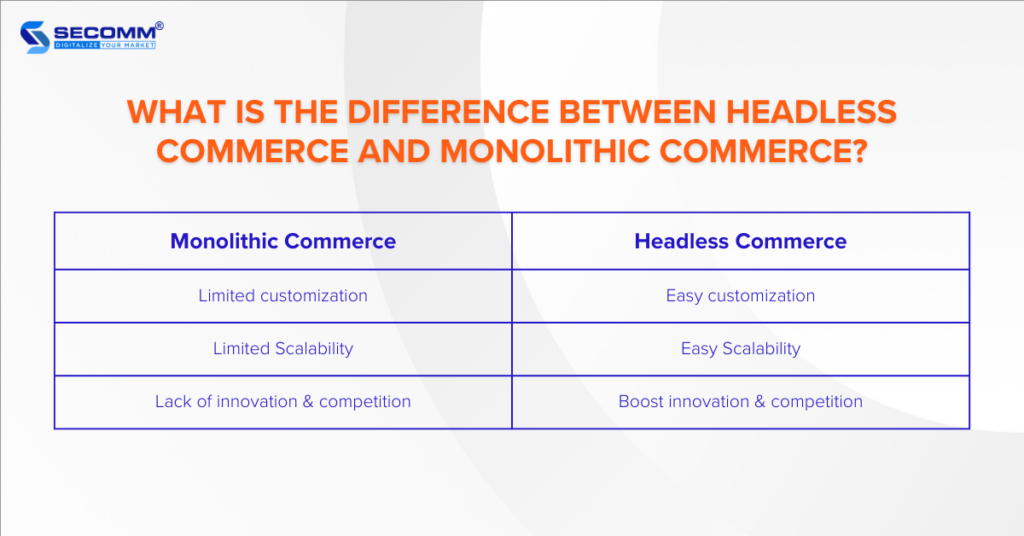
Top 5 Benefits of Headless Commerce
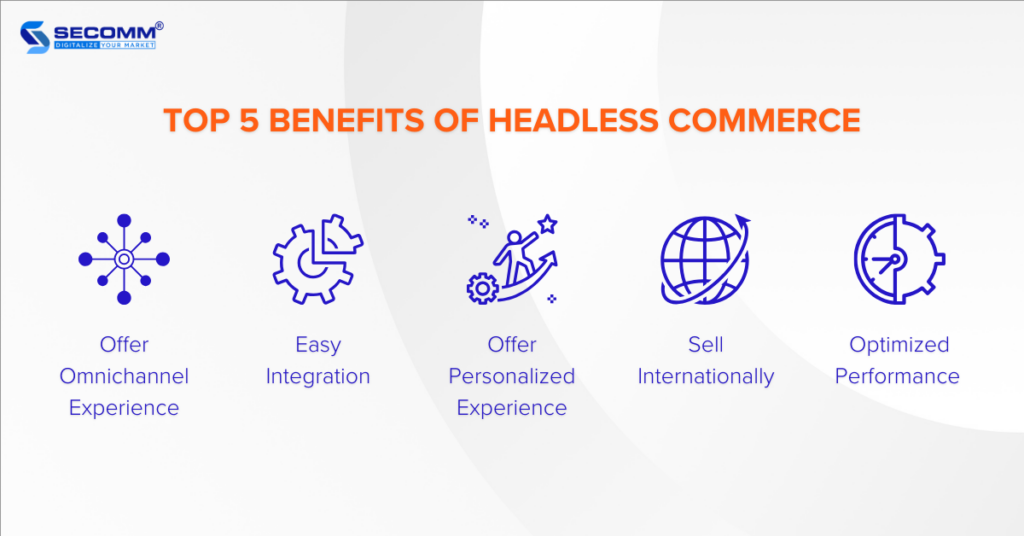
Offer Omnichannel Experience
The Headless Commerce model allows you to customize and create a unique user experience across various channels (website, mobile app, IoT). This not only avoids impacting the backend system but also helps you reach more potential customers and boost conversion capabilities.
Easy Integration
You can effortlessly integrate and merge various third-party systems (CRM, CMS, ERP, DXP) into the backend using APIs. This integration enhances the efficiency of managing and executing eCommerce activities, enabling you to leverage the superior capabilities of multiple services without concerns about website compatibility or performance issues.
Offer Personalized Experience
Through seamless integration with various systems, you can collect and consolidate customer data from various sources such as CRM, advertising campaigns, or data from previous shopping experiences.
Going Headless, you can create a customized interface based on customer data and personal information, displaying unique content, products, and messages for each customer based on their preferences, shopping behavior, and transaction history.
Sell Internationally
Deploying Headless Commerce enables you to expand your operations into international markets by adapting their activities to effectively cater to diverse markets. Specifically, you can customize the user interface, manage content, and offer distinct views for each customer segment in various markets.
Moreover, you can seamlessly integrate local options for payment, delivery, language, and currency to enhance the local customer experience.
Optimized Performance
In the Headless architecture, the frontend and backend operate independently through APIs, allowing businesses to optimize the performance of both parts. For example, you can enhance the navigation and page loading speed of frontends (website, mobile app, IoT) without heavily relying on the backend’s performance.
Similarly, you can optimize the backend to efficiently handle product requests, transactions, or inventory without impacting the page loading speed of the frontends
Does Headless Commerce suit all types of businesses?
Headless Commerce is a highly innovative eCommerce solution. However, that doesn’t mean this solution is suitable for every business. Therefore, before deciding to implement Headless for an eCommerce website, you need to consider the following factors:
- Business objectives: You need to clearly define your business objectives and determine whether Headless Commerce can help achieve those goals. If the objective is to establish a straightforward and efficient eCommerce website, the Monolithic architecture might be sufficient and a more fitting choice. However, if the goal involves delivering customers a distinctive and seamless shopping experience across diverse sales channels, going Headless is recommended..
- Budget & Resources: You should carefully assess your budget and resources when implementing Headless Commerce. Since deploying Headless requires utilizing eCommerce APIs to connect the frontend and backend, you will need an experienced and highly skilled technical team to design, develop, and maintain these APIs, as well as to handle complex customizations. You also need to allocate funds for API services, hosting, security, and the integrations in use. Without sufficient budget and resources, businesses may face difficulties and risks of failure when implementing this model.
- Deployment & Golive: The Headless architecture is quite complex, so it will take a considerable amount of time to build, customize, and perfect an eCommerce website, potentially extending the planned go-live time. To mitigate this risk, you should schedule a detailed deployment timeline for each task that needs to be completed. Plus, you need to regularly monitor and update the APIs, frontend, and backend to ensure the system operates smoothly. Therefore, if you require a quick website go-live and have minimal need for extensive system adjustments, it may not be necessary to implement Headless Commerce at this time.
Ready to go Headless?
Over time, Headless Commerce has played a crucial role in reshaping how businesses implement eCommerce. This model provides you with many benefits in terms of customization, scalability, and delivering a multi-channel experience for customers. However, before deciding to deploy Headless, you’ll need to consider issues related to business goals, budget and resources, development needs, and the go-live timeline.
When ready to implement Headless, you’ll choose top platforms supporting Headless Commerce. One of these platforms is Shopify, a renowned SaaS platform that has introduced several solutions for businesses to deploy Headless.
- Shopify Hydrogen + Oxygen: This superior solution includes the Hydrogen framework based on React and the Oxygen hosting. It helps quickly and efficiently deploy a Headless eCommerce website.
- Commerce Components: This groundbreaking tech stack is developed specifically for large enterprises deploying Headless Commerce or Composable Commerce. This solution allows you to combine independent components to customize and enhance the eCommerce experience.
With extensive technical expertise and high specialization in the eCommerce domain, SECOMM has successfully consulted and implemented Headless Commerce using one of Shopify’s three solutions for leading enterprises such as Vinamilk, Suzuverse, and more.
Contact SECOMM or call directly at the hotline (02871089908) to explore how we can support businesses in maximizing the potential of Headless Commerce and enhancing competitiveness in the eCommerce market.
 2
2

 4,558
4,558

 0
0

 1
1
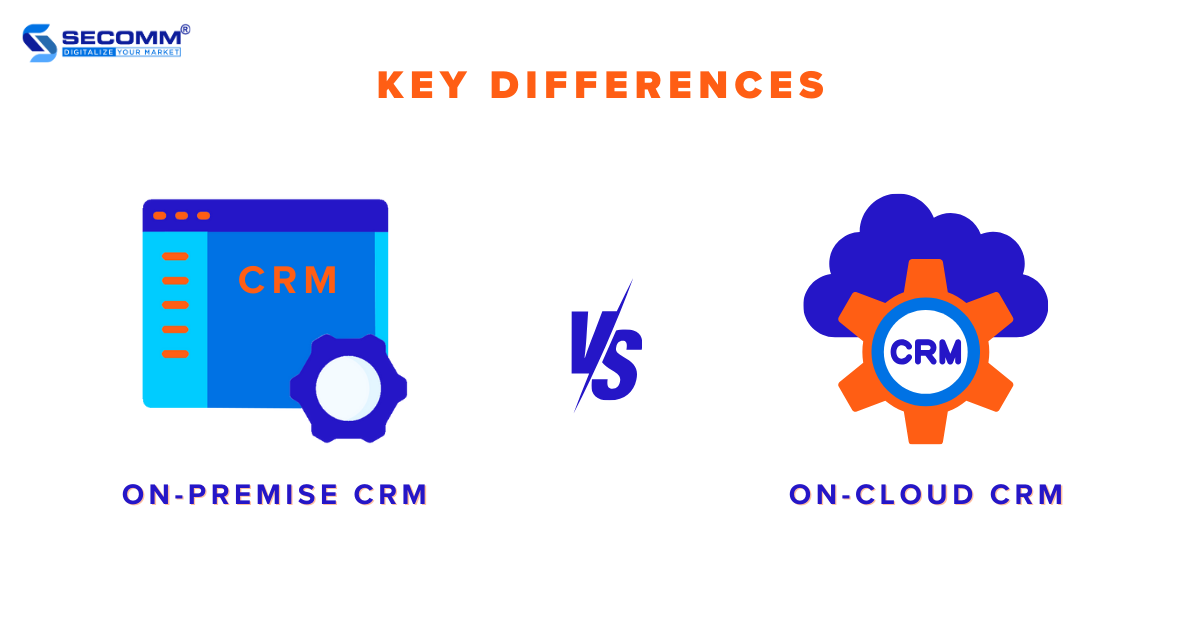
ON-PREMISE CRM VS ON-CLOUD CRM: KEY DIFFERENCES
When it comes to Customer Relationship Management (CRM) software, businesses often have two choices: On-premise CRM and On-cloud CRM. This article will focus on clarifying the key differences and pros and cons of each option.
Understanding the distinctions between On-premise and On-cloud CRM can help businesses make well-informed decisions, optimize customer relationship management, and succeed in today’s business landscape.
Related Reading: What is CRM? Top 5 benefits of using CRM software in 2023
On-Premise CRM Software
On-premise CRM is a type of CRM software installed and hosted on the servers and infrastructure owned by the business. When deploying On-premise CRM, the business takes responsibility for all aspects of the CRM system, including hardware, software, maintenance, security, and database management.
Pros
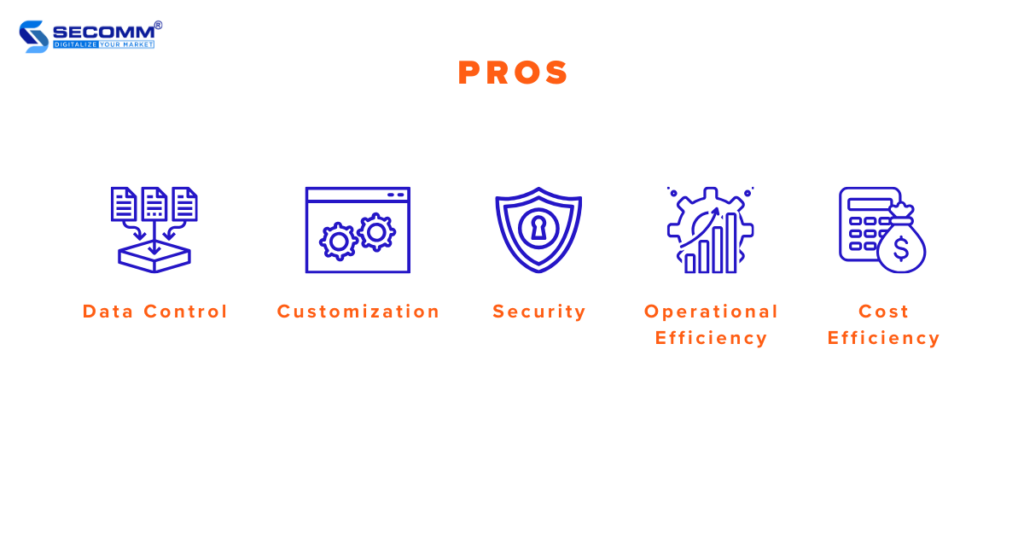
- Data Control: Businesses have complete control over their CRM data, which is particularly crucial for safeguarding sensitive and essential information.
- Customization: On-premise CRM systems frequently provide a high level of customization, allowing businesses to tailor the software to meet their specific needs and operational workflows.
- Security: With full data control, businesses can implement their security measures and protocols to ensure the protection of both customer and business data.
- Operational Efficiency: On-premise CRM software can offer robust operational efficiency and faster data access as it is stored and operated entirely on the internal servers and infrastructure of the business.
- Cost Efficiency: On-premise CRM requires businesses to pay for hardware and software licenses upfront. However, ongoing costs can be significantly lower than cloud-based CRM, making on-premise CRM cost-effective in the long run.
Cons
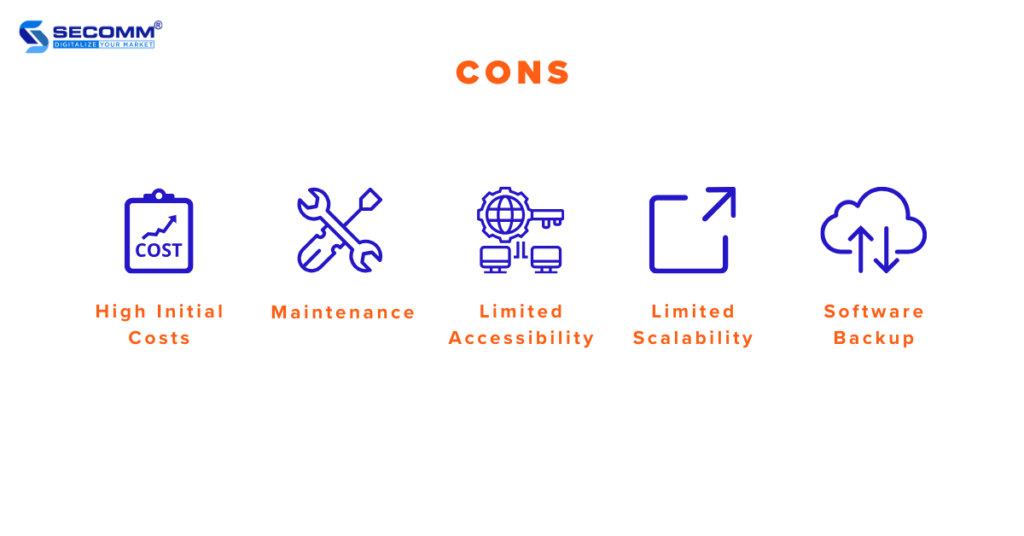
- High Initial Costs: Implementing on-premise CRM entails substantial initial payments for acquiring servers, obtaining software licenses, and establishing the necessary infrastructure. This considerable upfront investment might pose challenges for some businesses.
- Maintenance: Businesses have responsibility for all maintenance tasks, security measures, updates, and issue resolutions. This can consume a lot of resources and requires a highly skilled technical team.
- Limited Accessibility: On-premise CRM software is quite limited in terms of remote access, making this system less appealing to businesses with multiple branches in different locations.
- Limited Scalability: Scaling up the on-premise CRM system can be complex and incur significant costs for purchasing and configuring additional hardware and software.
- Software Backup: Businesses must deploy their own data backup solutions to ensure the availability of data in case the CRM system encounters unforeseen issues.
Some popular on-premise CRMs like Microsoft Dynamics, Oracle Siebel CRM,…
On-Cloud CRM Software
On-Cloud CRM is a form of customer relationship management software hosted on the remote servers of a third-party provider. With this software, businesses are relieved from the task of managing and maintaining fundamental infrastructure like servers and central databases, as those responsibilities are handled by the On-Cloud CRM provider.
Businesses can access the CRM system from anywhere with an internet connection through a web browser or mobile application.
Pros
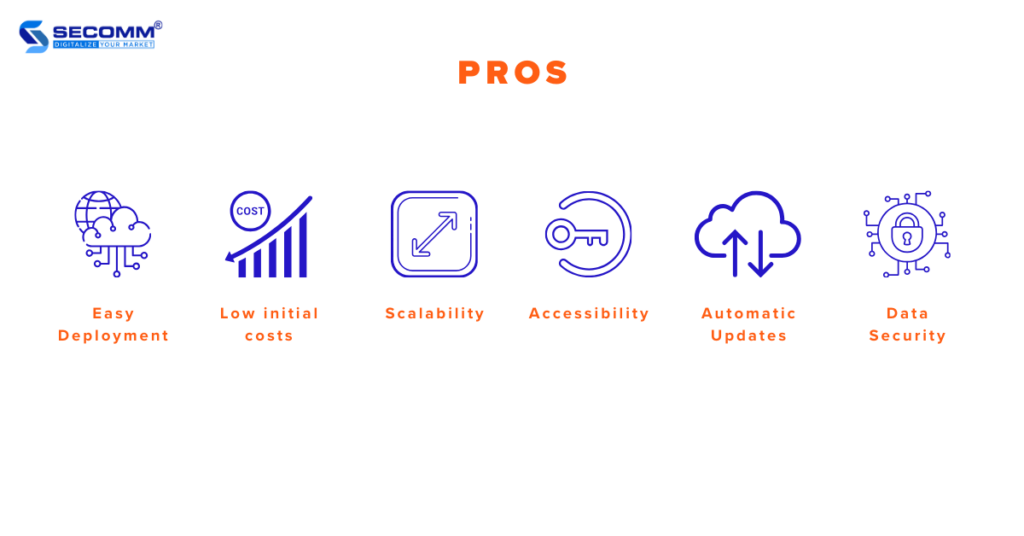
- Easy Deployment: On-cloud CRM systems are typically deployed quickly because they don’t require complex hardware setups or software installations.
- Low initial costs: Cloud CRM solutions often have lower upfront costs compared to on-premise CRM solutions because businesses don’t need to invest in servers and infrastructure.
- Scalability: Cloud CRM can easily scale to meet the growing number of users and changing business needs without the need for additional hardware investments.
- Accessibility: Cloud CRM users can access the system from anywhere with an internet connection, making this software appealing to businesses with multiple branches in different locations.
- Automatic Updates: On-cloud CRM providers are responsible for handling updates and maintenance, ensuring users quickly access the latest features and improvements.
- Data Security: On-cloud CRM providers are highly regarded for their ability to offer optimal security measures to protect customer data.
Cons
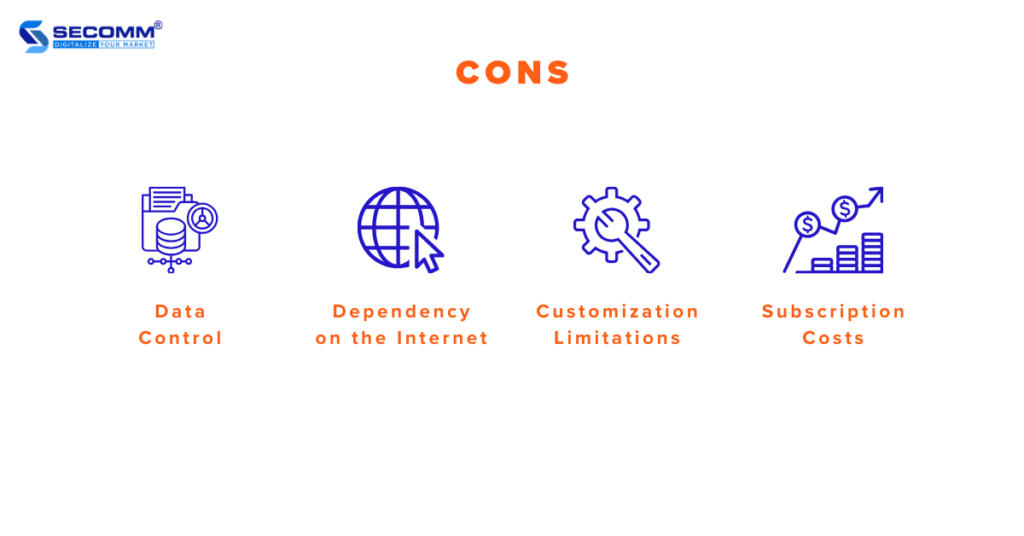
- Data Control: The entire data is stored on servers owned by the third-party provider. This raises concerns about data control and security, as well as risks from the provider’s end.
- Dependency on the Internet: Cloud CRM operations rely on Internet connectivity. If the connection is slow or interrupted, it may impact the overall system performance.
- Customization Limitations: While many cloud CRM solutions are highly configurable, compared to on-premise CRM solutions, they still have limitations in terms of customization.
- Subscription Costs: Using on-cloud CRM, businesses will incur ongoing monthly or annual usage fees. Initially, the upfront costs may be lower than on-premise CRM, but there are ongoing fees such as user quantity fees, customization fees, etc., which businesses will continuously have to pay throughout the deployment process. This leads to an increase in the total cost of using the cloud CRM system over time.
Some popular Cloud CRMs include Salesforce Sales Cloud, SAP Sales Cloud, Oracle CRM On Demand,…
Related Reading:
- Explore the 10 best CRM software for large enterprises Pt1
- Explore the 10 best CRM software for large enterprises Pt2
What is The Difference Between On-Premise and Cloud CRM?
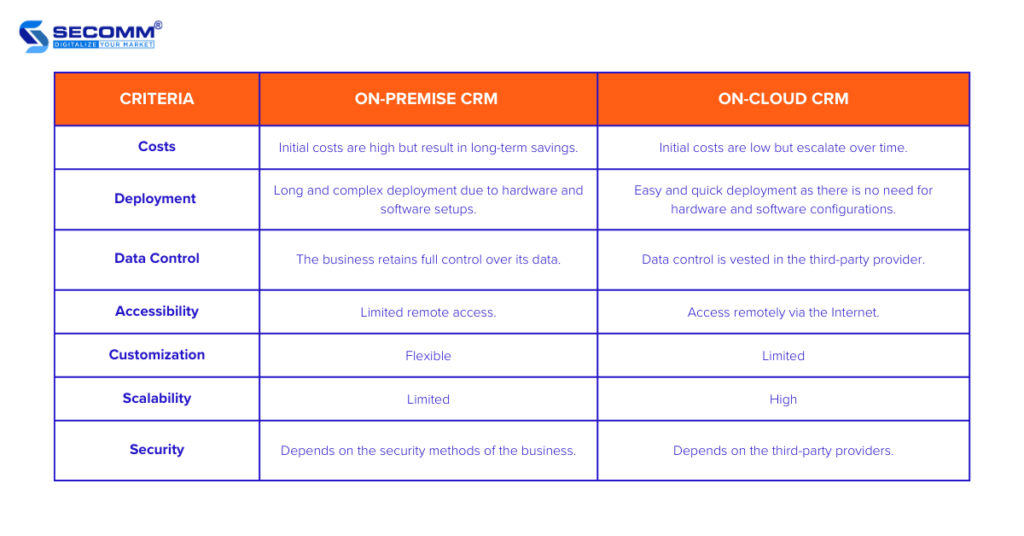
On-Premise CRM vs On-Cloud CRM: Which is The Better Choice?
The choice between On-premise and On-cloud CRM becomes a crucial decision in the strategy of deploying CRM. Each type comes with its own set of advantages. On-premise CRM offers high control and customization, while On-cloud CRM is convenient, flexible, and helps reduce the burden of infrastructure and initial costs.
The ultimate decision depends on the deployment needs, data control requirements, and budget. Nevertheless, both can serve as valuable tools for businesses to manage customer relationships and amplify operational efficiency.
Contact SECOMM or call the hotline at 02871089908 today to learn more about deploying and developing a comprehensive CRM system and determine the optimal choice between On-premise and On-cloud.
 2
2

 10,198
10,198

 0
0

 1
1
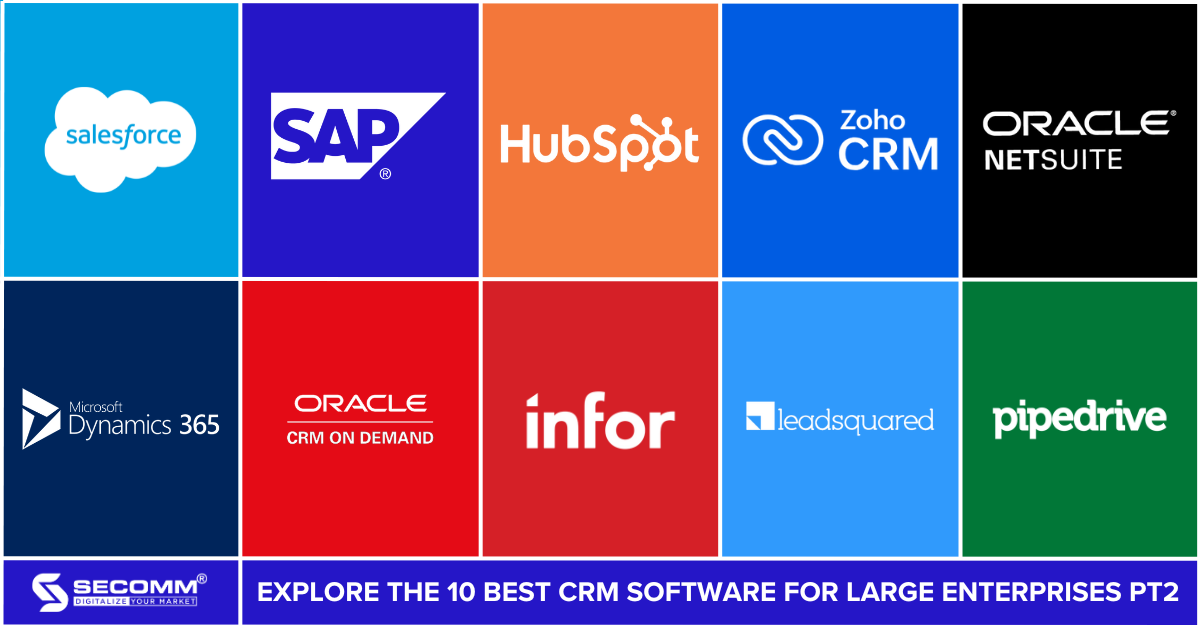
EXPLORE THE 10 BEST CRM SOFTWARE FOR LARGE ENTERPRISES PT2
The recent surge in prioritizing customer experience has significantly impacted the evolution of eCommerce. Therefore, choosing the right CRM among various CRM software solutions to effectively manage customer relationships is crucial.
Following Part 1, here are 5 other CRM software options for large enterprises worth considering.
Dynamic 365 Sales
Dynamics 365 Sales is a comprehensive Customer Relationship Management (CRM) solution developed by Microsoft. The software is designed to assist businesses in managing and streamlining customer interactions, enhancing the sales process’s efficiency.
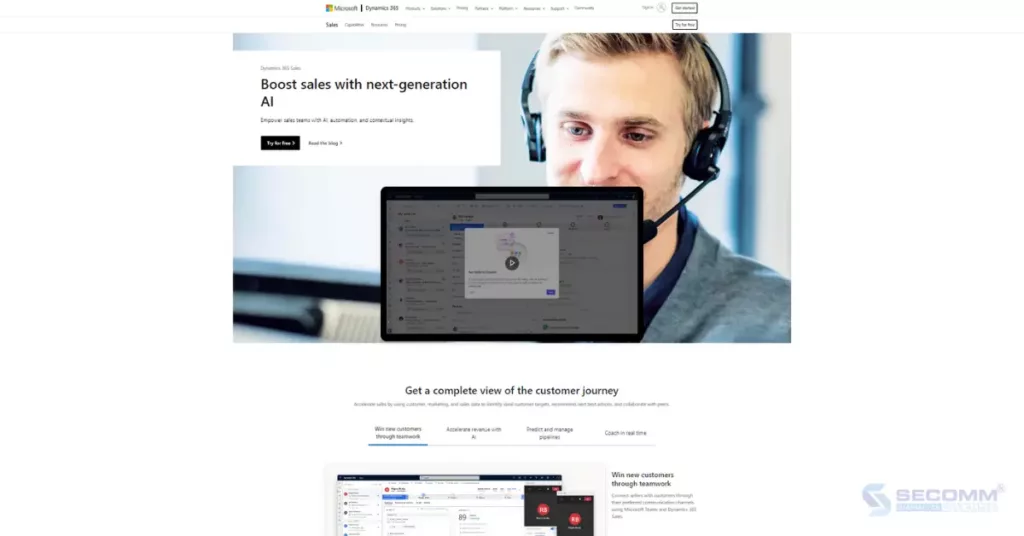
Its notable capability for scalability and flexible customization has made Dynamics 365 Sales one of the most suitable choices for the complex deployment needs of large enterprises.
Core features:
- Communication Management: Harness the power of Dynamics 365 and Microsoft Teams to enhance team collaboration effectiveness and interact more efficiently with customers.
- Revenue Acceleration: Optimize the sales process and revenue with suggested next actions proposed by Microsoft, helping businesses prioritize their sales activities.
- Predict & Manage Pipeline: Analyze individual and team sales processes to provide automatic in-depth insights and deliver the most accurate forecasts.
- Real-time Insight: Provide real-time insights from sales calls, including customer emotions, market competition, and more, enabling businesses to assess and guide their sales teams effectively.
Costs:
| Dynamics 365 Sales Professional | Dynamics 365 Sales Enterprise | Dynamics 365 Sales Premium | Microsoft Relationship Sales |
| $65/user/month | $95/user/month | $135/user/month | $162/user/month |
Pros:
- Seamless integration with other Microsoft products.
- Intuitive interface, easy to set up, and shares similarities with other Microsoft solutions.
- Collects customer data from multiple sources and stores it centrally in a single platform.
- High flexibility and scalability for customization.
Cons:
- Rigorous configuration, challenging to change after setup.
- For users unfamiliar with Microsoft products, the interface may be cluttered and challenging to navigate.
- Requires a high technical proficiency and a specific understanding of Microsoft products for deployment and customization.
- Some advanced features may necessitate additional module purchases
Oracle CRM On Demand
Oracle CRM On Demand is a cloud-based CRM designed to assist businesses in managing sales activities, marketing, and customer interactions, and providing in-depth analytical reporting. It is the SaaS version of Oracle’s renowned on-premise software, Siebel CRM. Businesses can use both of these software applications and link them through the ‘Oracle Application Integration Architecture’ and ‘Oracle Fusion Middleware’ software.
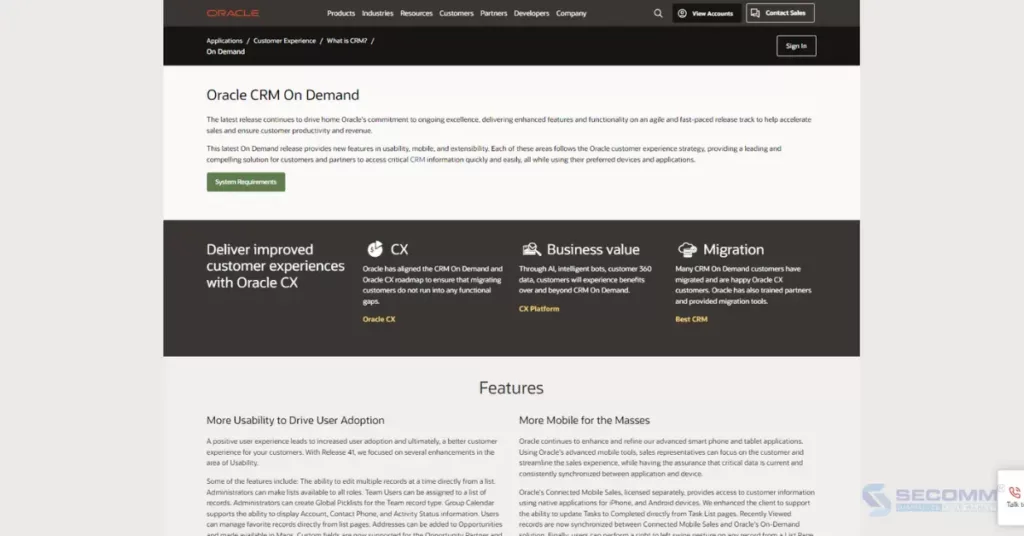
Core features:
- Browser & Cloud Support: The software is accessible on mobile browsers and various web browsers such as Chrome, Firefox, and Bing, enabling businesses to access customer data and manage all sales activities remotely.
- Workflow Automation: Create and automate sales, marketing, approval processes, and daily tasks for the team to enhance the overall efficiency of business operations.
- Analytics & Reporting: Additional factors are incorporated into reports, such as personalized content, and enhanced custom sales history, to provide in-depth insights that assist businesses in making better business decisions.
Costs: Oracle CRM On Demand doesn’t publicly disclose its pricing on the website. Therefore, businesses are advised to contact the provider directly for consultation and a price quote.
Pros:
- Intuitive interface with step-by-step setup and usage guidance.
- Flexible and highly customizable with extensive scalability.
- Seamless integration with other Oracle products and third-party applications.
- Provides in-depth reporting and analysis.
Cons:
- Requires internet access for use.
- The pricing for using Oracle CRM On Demand is not disclosed, making it challenging for businesses to calculate deployment budgets.
- While Oracle provides setup instructions, businesses still need technical expertise and a certain level of understanding of Oracle products for deployment and customization.
Related Reading: On-Premise CRM vs On-Cloud CRM: Key Differences
Infor CRM
Infor CRM is a cloud-based customer relationship management (CRM) software designed to assist large businesses in developing and maintaining customer relationships.
Infor CRM is known for its flexibility, scalability, and high configurability, offering a range of features to help businesses better understand their customers, personalize customer experiences, and enhance the effectiveness of sales operations.
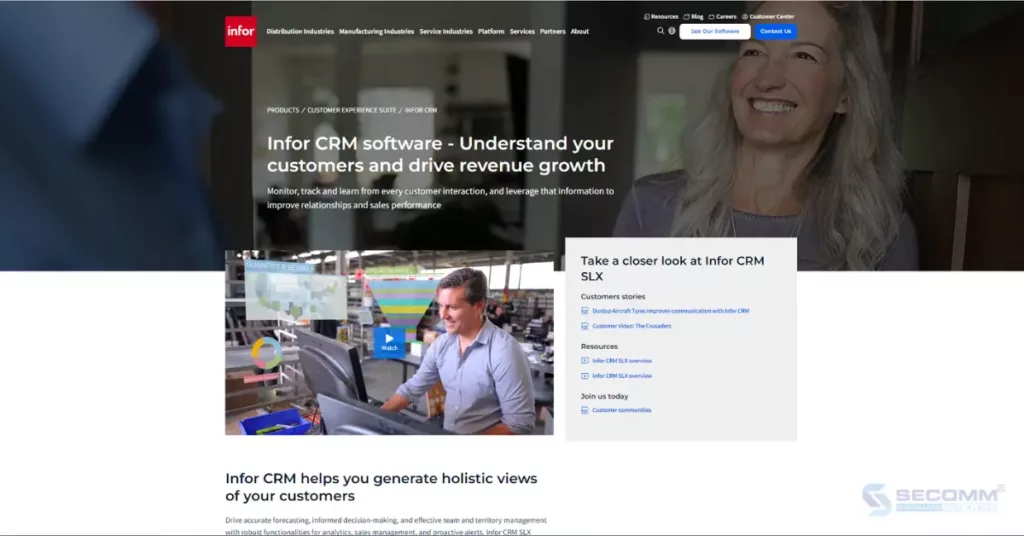
Core features:
- Customers 360º views: Provides businesses with a comprehensive overview of customer transaction history, preferences, and behavior.
- Reporting and Analytics: Infor CRM’s in-depth reporting and analytics offer crucial insights for making informed decisions.
- Email Integration: Seamlessly integrates with email platforms such as Outlook and Gmail to retrieve information directly from Infor CRM and send emails to customers at any time.
Costs: Infor CRM doesn’t publicly disclose its pricing on the website. Therefore, businesses are advised to contact the provider directly for consultation and a price quote.
Pros:
- Intuitive interface, easy to set up and use
- Seamless integration with other Infor solutions
- Smooth integration with third-party applications and services
- High flexibility and scalability for customization.
Cons:
- Requires internet connectivity
- The usage cost of Infor CRM is not publicly disclosed, making it challenging for businesses to estimate deployment budgets.
- Technical expertise and a certain level of understanding of Infor CRM are necessary for deployment and customization.
LeadSquared Sales + Mobile CRM
LeadSquared Sales + Mobile CRM is a cloud-based CRM solution that enables businesses to enhance sales productivity and manage relationships with customers and potential customers.
This CRM solution integrates the features of Sales CRM and Mobile CRM, allowing businesses to access customer data and perform essential sales tasks from anywhere, at any time.
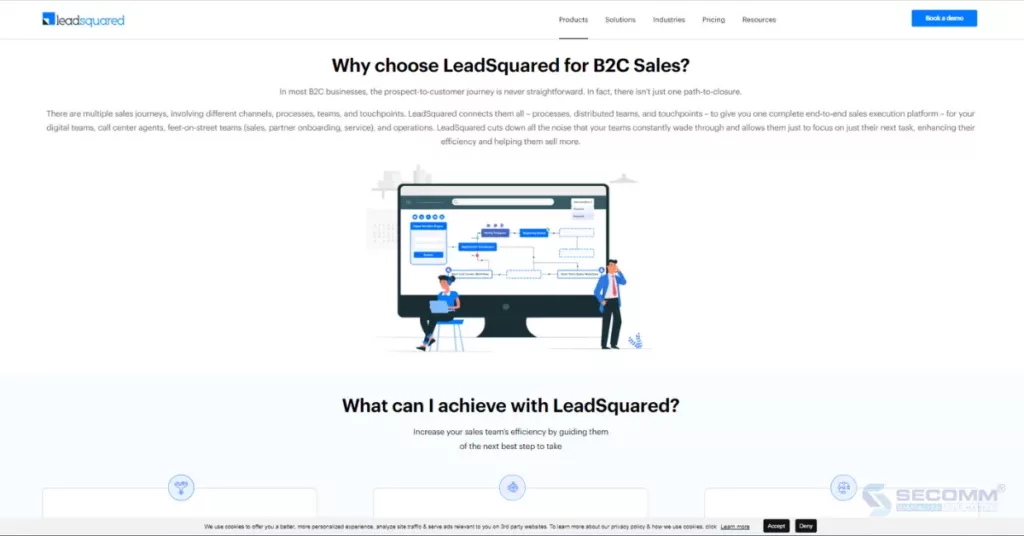
Core features:
- Lead Distribution: Evaluate transaction scale, customers, language preferences, and various other critical factors to distribute suitable potential customers to each sales team member.
- Sales Smartviews: Eliminate clutter and boost the productivity of the sales team by displaying tasks in order of priority.
- Mobility: Track and manage the remote activities of the sales team, including automatic check-in/check-out, automatic detection of incorrect check-in locations, automatic reminders for the next meeting, and expedited document sharing and uploading processes.
Costs:
| Lite | Pro | Super | Ultimate |
| $25/user/month | $50/user/month | $100/user/month | Custom |
Pros:
- Automates sales and marketing processes.
- Enables the search for potential customers from multiple channels, minimizing the risk of losing potential customers.
- Manages and nurtures potential customers for conversion with AI-built functionalities.
Cons:
- No free trial version is available.
- Requires technical expertise and understanding of LeadSquared for implementation.
- Occasionally encounters server-related issues or problems with internet connectivity.
- Compared to other CRM software, LeadSquared is somewhat limited in providing in-depth reports.
Pipedrive
Pipedrive is a popular CRM software solution used by businesses of all sizes and industries. In recent times, large enterprises have shown particular favor for Pipedrive CRM due to its advanced features that assist in managing sales opportunities and swiftly converting potential customers into clients.
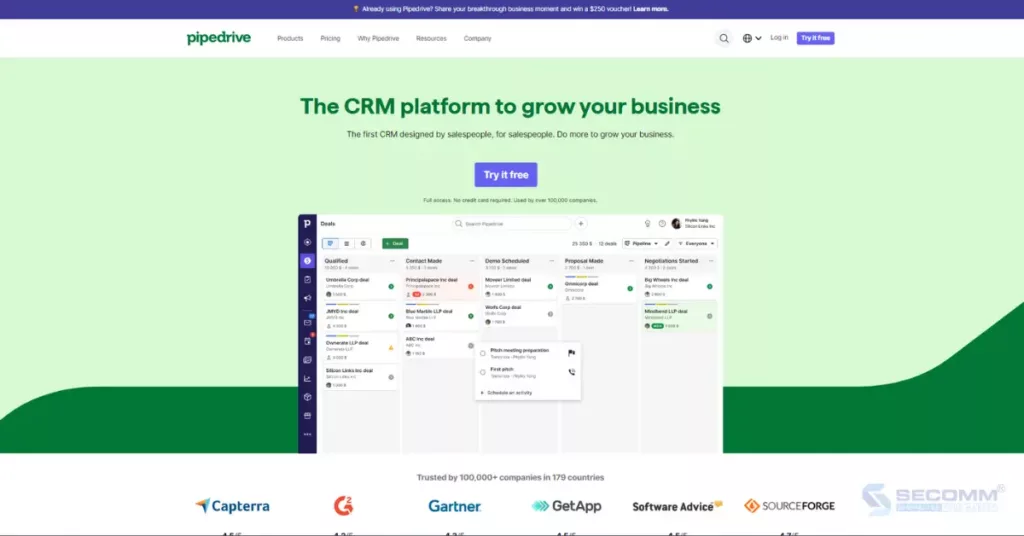
Core features:
- Customizable Sales Pipeline: Set up a customizable sales process with multiple stages to align with the existing sales cycle.
- Segment Leads: Filter, sort, and segment potential customers to create target customer lists for personalized interaction activities.
- Contact History: Track and manage the entire history of all calls, emails, meetings, and notes related to every transaction and contact.
- Revenue Forecasting: Predict transaction volume and revenue within the CRM system. Track and automatically calculate revenue as transactions are updated.
- Reporting & Dashboards: Receive detailed reports on sales activities and sales figures. Monitor progress and achievements in the dashboard.
Costs:
| Pricing plans | Essential | Advanced | Professional | Power | Enterprise |
| Billed Monthly | $15/user/month | $29/user/month | $59/user/month | $69/user/month | $99/user/month |
| Billed Yearly | $12.50/user/month | $24.90/user/month | $49.90/user/month | $59.90/user/month | $74.90/user/month |
Pros:
- Intuitive and user-friendly interface.
- 14-day free trial available.
- Automation of sales and marketing processes in most service packages.
- Unlimited customization of sales processes through API.
- Multilingual and multicurrency support.
Cons:
- Phone customer support is only available with premium packages.
- Pipedrive is somewhat limited in providing in-depth reports compared to other CRM software.
- Occasionally, emails sent from the Pipedrive system may encounter errors.
- Limited seamless integration with third-party apps and services.
Choose the best CRM software!
So, the article about the 10 CRM software systems part 1 + part 2 has come to a close with the hope that businesses will choose a platform suitable for their development needs.
By implementing a CRM solution, businesses can quickly build and develop relationships with customers while enhancing collaboration among internal departments.
Contact or call SECOMM’s Hotline directly at (02871089908) for advice and CRM implementation.
 2
2

 10,338
10,338

 0
0

 1
1
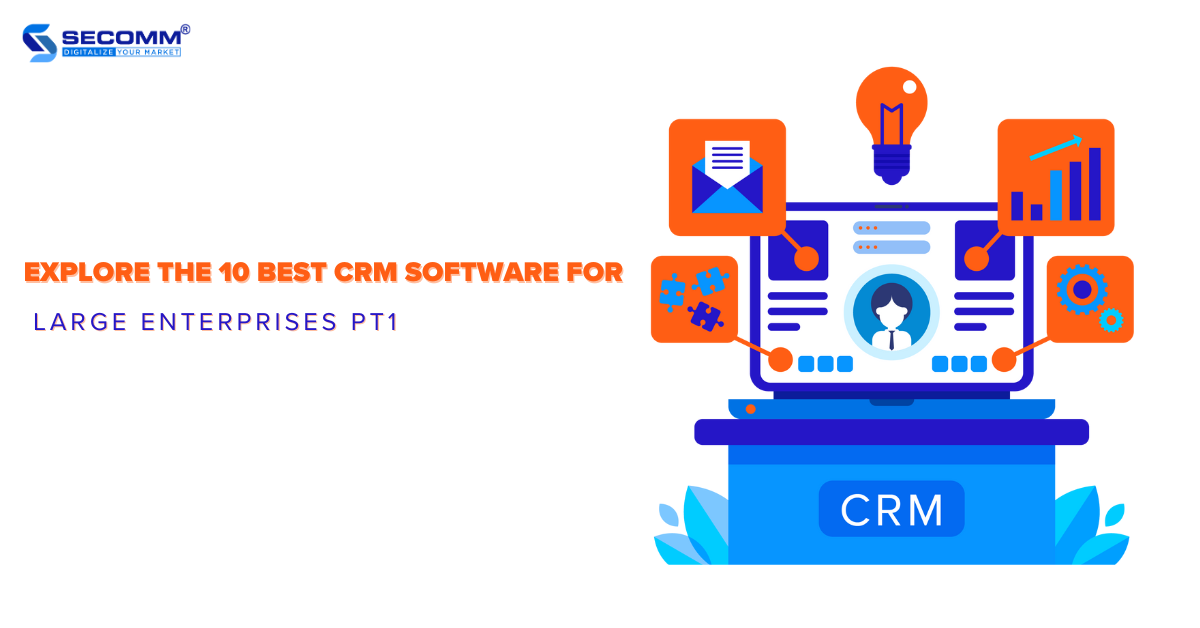
EXPLORE THE 10 BEST CRM SOFTWARE FOR LARGE ENTERPRISES PT1
The options for CRM solutions are expanding and becoming more diverse. In reality, some currently popular CRM software may lack the flexibility to meet the complex deployment requirements of large businesses.
Nevertheless, there are CRM software designed to offer a digital infrastructure, in-depth technical support, and exceptional features, granting significant customization freedom for large enterprises.
The article below focuses on providing important considerations when choosing CRM solutions and lists the 5 best enterprise CRM software.
5 Things to consider when choosing CRM software
Determine your need
The first important step before selecting CRM software is to clarify the needs and deployment expectations. You can review and assess the pros and cons of the current tools and management programs in use. Following this, the focus should be on the aspects requiring modification or enhancement, all while estimating the customization needs.
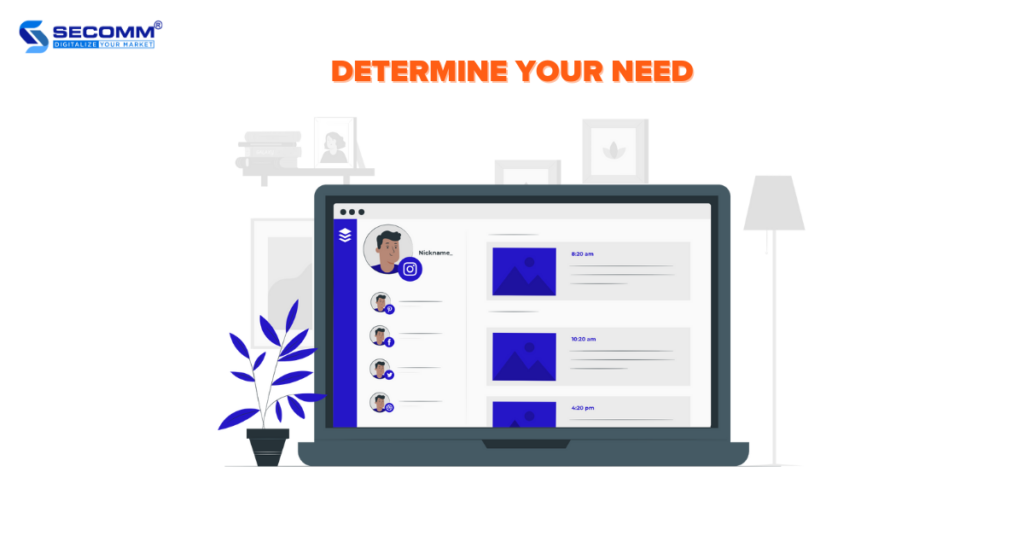
Select types of CRM software: On-premise CRM vs On-cloud CRM
Next, you need to the type of software to deploy, which may be either On-premise or On-cloud CRM software. These two software types come with key differences.
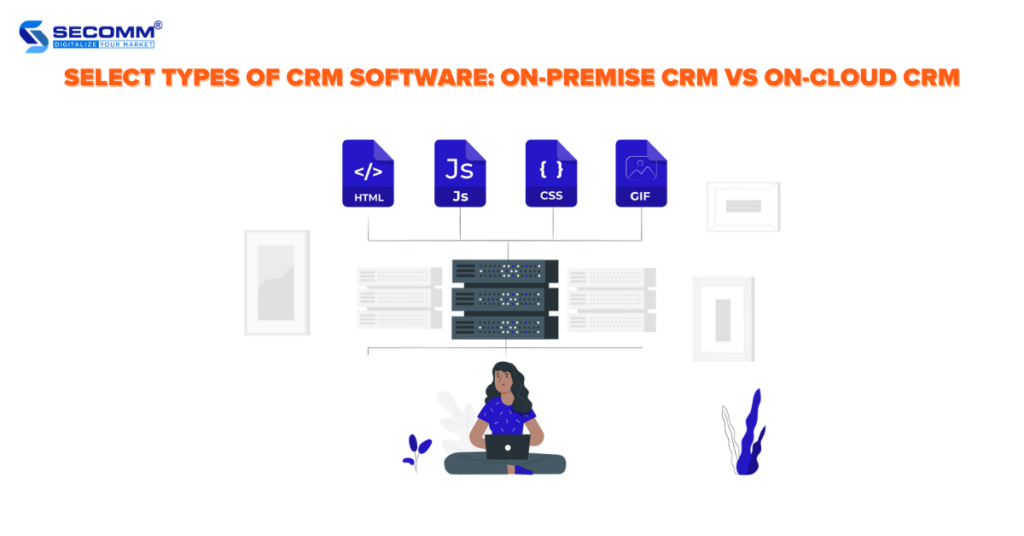
For On-cloud CRM, the entire data and software system are stored and managed by a third-party service provider, allowing you to access it through a web browser or mobile application.
Some advantages of On-cloud CRM include:
- Cost-effective usage
- Easy to use and accessible anytime, anywhere
- No need to perform maintenance, security, and software update processes
On the other hand, On-premise CRM stores and manages the entire data and software system locally on the company’s servers and infrastructure.
Some advantages of On-premise CRM include:
- Internal storage ensures security for vital information.
- You have complete control over the software, enabling you to customize the software updates.
- Not dependent on the internet to access and maintain the CRM system’s operations.
Related Reading: On-Premise CRM vs On-Cloud CRM: Key Differences
Check the accessibility
A user-friendly CRM software accessible to users of all skill levels contributes to expediting the deployment process effectively. Specifically, the software interface should be intuitive, easy to install, and allow for seamless import and export of any data type without requiring excessive assistance.
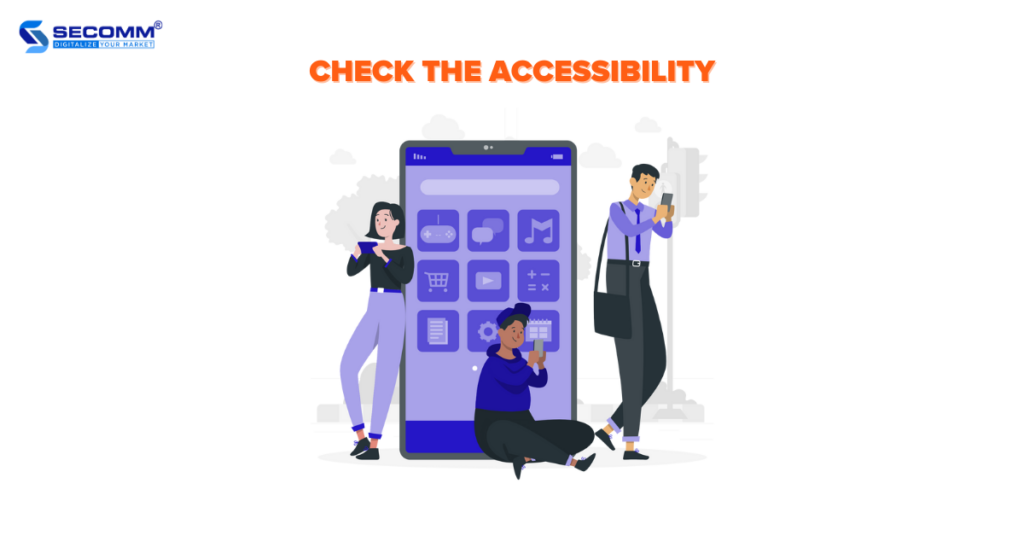
Moreover, businesses should opt for CRM software that is flexible enough to synchronize with their existing operational processes. Typically, the majority of CRM solutions nowadays offer a free trial period of three or four weeks. This timeframe is sufficient for businesses to understand the software’s functionality and assess whether it is the optimal choice for their deployment needs.
Evaluate the ability to customize
Customization is a vital feature of CRM software. Because each business has different models and scales, it’s essential to select CRM software that offers customization capabilities to match your business requirements and smoothly manage your sales processes.
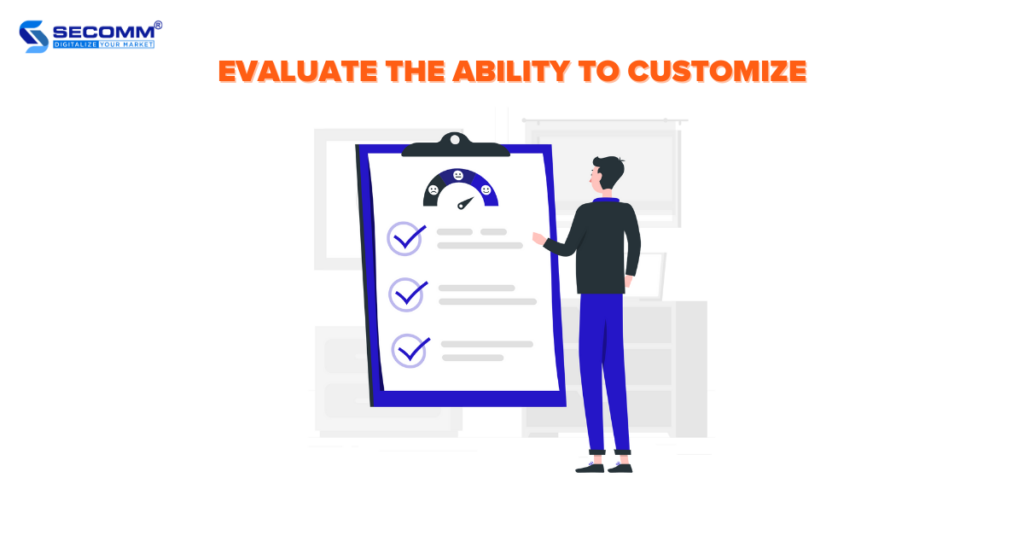
Most CRM software designed for large-scale businesses offers customization capabilities. Nevertheless, while CRM solutions with extensive customization features can facilitate flexible deployment to meet specific needs, they often come with a higher price point.
Pay attention to security issues
The most crucial information stored in CRM software is customer data. Therefore, when selecting a CRM solution, you need to prioritize security.
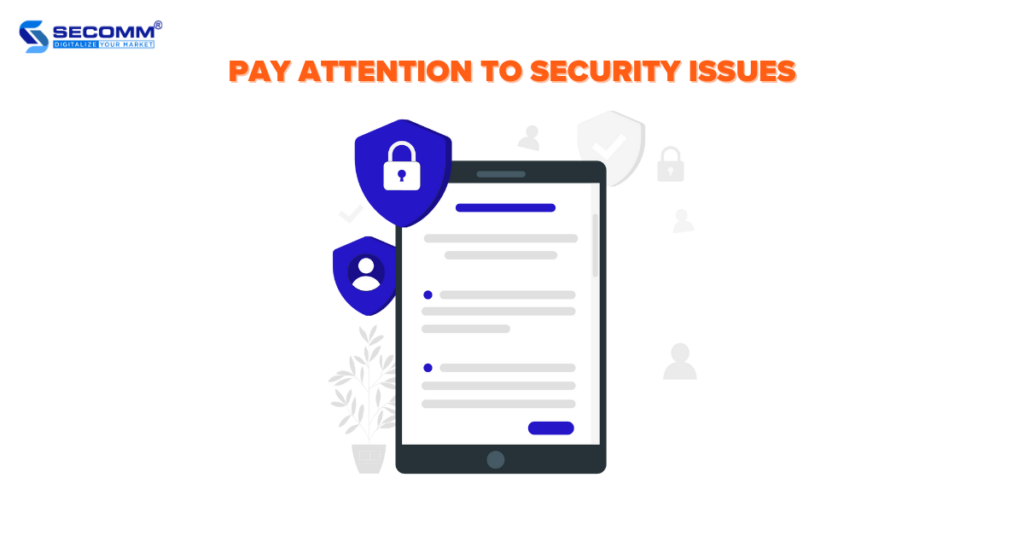
Currently, many CRM solutions are cloud-based, meaning customer data is encrypted and regularly backed up to enhance safety and security. However, you should thoroughly research the provider and understand how their data will be stored and secured in the database. This information is typically available on the CRM provider’s website.
5 best enterprise CRM software
According to G2‘s and rankings based on user satisfaction, here are the top 10 CRM software solutions best suited for large-scale enterprises.
Salesforce Sales Cloud
Salesforce Sales Cloud is a part of the renowned Salesforce CRM platform, developed to assist large enterprises in optimizing business operations and maintaining better customer relationships.
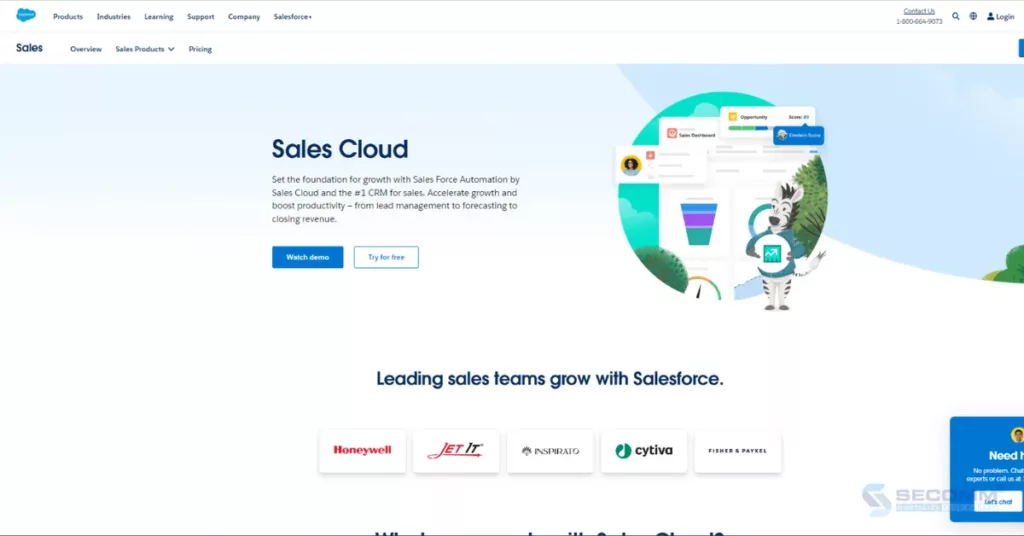
Core features:
- Opportunity Management: Provides details about transactions, including product information, deal stages, pricing, and competitors Allows sales personnel to access real-time information for each transaction.
- Marketing Automation: Automatically creates, deploys, and manages effective online marketing campaigns. Enables collaboration between sales and marketing teams to search, evaluate potential customers, and streamline the sales process.
- Lightning Voice: Allows making calls to customers directly within Salesforce with just a click. Sales representatives can view all contact information updated in real-time to be prepared for any customer conversation.
- Workflows and Approvals: Saves time and simplifies the approval of business requests by designing and automating sales processes with simple drag-and-drop actions. Approval requests include deal discounts, expense reports, purchase orders, etc.
- File Sync and Share: This enables the sales team to quickly search and share up-to-date and accurate content such as presentations, proposals, and contracts from anywhere, helping the business close more deals in less time.
- Reports and Dashboards: Easily create and customize dashboards and real-time data reports to support the decision-making process for the next business steps.
- Sales Forecasting: This enables viewing sales forecasts and specific adjustments suggested for each sales team.
Costs:
| Essentials | Professional | Enterprise | Unlimited |
| $25/user/month | $75/user/month | $150/user/month | $300/user/month |
| For small businesses with a maximum of 10 users. | For businesses of all sizes. | For large enterprises with deep customization needs. | For large enterprises with unlimited software usage and demanding support requirements. |
Pros:
- Enables a 360-degree view of the customer interaction journey
- Offers tools for automating business processes
- Includes a demo for every deployed feature
- High level of customization and scalability
- Superior data security system
Cons:
- Internet access is required to use the software.
- While Salesforce Sales Cloud offers extensive customization, you will face additional charges for adding features or utilities, leading to increased software usage costs.
- The platform provides advanced features, but for new users, navigating through all the features and options available on the dashboard may not be intuitive. You will need to invest significant time in training their teams to effectively utilize the software.
- Migrating data from existing systems to Salesforce Sales Cloud can be time-consuming and may require technical expertise. Businesses can contact the Salesforce consulting team for assistance in addressing this issue.
SAP Sales Cloud
Recognized as a top on-cloud CRM software for large enterprises, SAP Sales Cloud assists businesses in creating an internal collaborative environment, optimizing business processes, and fostering efficient interactions with customers.
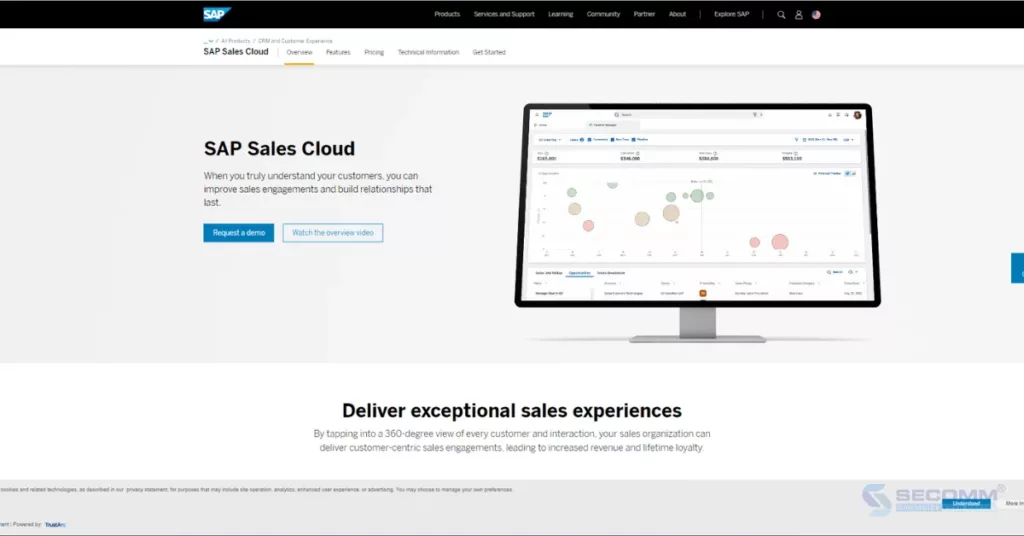
Core features:
- Omnichannel Engagement: Provides omnichannel interaction features to enhance customer engagement, streamline the sales process, and complete transactions.
- Email & Calendar Integration: Integrates with productivity tools like Microsoft Outlook and Google Gmail to automatically synchronize customer data and important information from the current system.
- Predictive Analytics & Machine Learning: Real-time scoring and prediction features help businesses identify potential customers, guide them through the sales process, and offer personalized recommendations for products, sales representatives, and pricing to optimize contract opportunities.
- Sales Performance: Offers detailed sales guidance to help businesses actualize their sales strategy while tracking progress and results with comprehensive information on each salesperson’s actions. Additionally, businesses can integrate with the SAP CX solution suite to boost business goals.
- Productivity & Personalization: Provides features that enhance the efficiency of the sales process, such as tagging, flagging, scheduling, and personalizing fields, reports, and custom fields for easy access and use by sales representatives.
- Back-office Integration & Connection: Integrates with SAP ERP and SAP CX solutions to leverage real-time, valuable information and details to understand sales cycles and seize transaction-closing opportunities.
Cost: SAP Sales Cloud doesn’t publicly disclose its pricing on the website. Therefore, businesses are advised to contact the provider directly for consultation and a price quote.
Pros:
- User-friendly interface that is easy to use.
- Seamless integration with other services in the SAP system, facilitating the sharing of information and data across departments within the business.
- Provide demos for each deployed feature.
- Offers advanced analytics capabilities for customer information and market trends to optimize sales strategies.
- High customization and scalability.
- Ensures the security, regular updates, and accuracy of customer-related information and data.
- Automates business processes.
Cons:
- The usage cost is not publicly disclosed, making it challenging for businesses to accurately estimate deployment expenses
- The seamless integration capability with other SAP services, while advantageous, can be a drawback as businesses become heavily dependent on the SAP system, leading to limitations if a few services from a different provider are used.
- Integrating SAP Sales Cloud with external services is not straightforward and requires significant expertise and resources.
- The high customization capability of SAP Sales Cloud demands technical proficiency and a certain level of understanding of SAP, making it time-consuming for new users to familiarize themselves with the platform.
HubSpot Sales Hub
When it comes to leading CRM providers, HubSpot is a very familiar name for most businesses. The HubSpot Sales Hub solution offers businesses outstanding features to build relationships with customers, manage the sales funnel effectively, and close more deals.
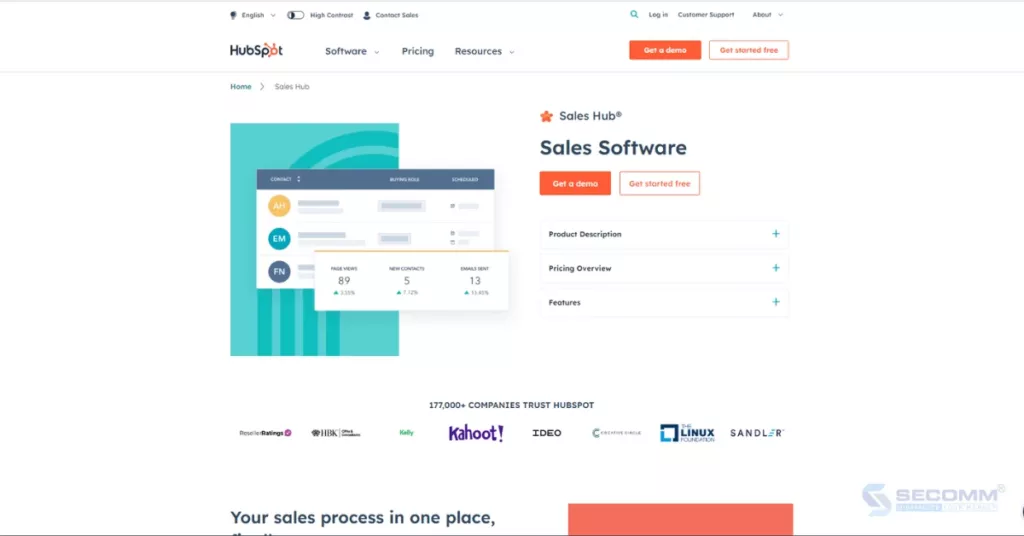
Core features:
- Sales Automation: Set up a series of automated and personalized tasks and emails to streamline the sales process and close deals.
- Conversation Intelligence: Utilize AI tools to record calls with customers to understand how each sales representative interacts with customers and provide timely evaluations and improvement guidance.
- Document Tracking: Support the sales team in creating and sharing sales content, while tracking which type of content customers open, view, or forward, and which content leads to deal closures
- Email Tracking: Use tools like Gmail, Outlook, and HubSpot to send tracked emails and receive notifications for any potential customer interaction with tracked emails.
- Call Tracking: Prioritize daily sales calls based on the HubSpot database. Automatically record call details for contacts in the CRM system.
- Pipeline Management: Create, customize, and control the sales process visually with the “Deal Pipeline Management” feature. On the “Sales Dashboard” page, you can view detailed sales activities, track customer movement through the funnel, and identify and address issues for each customer case to quickly close deals.
- Sales Analytics & Reporting: Choose from available reports or customize individual reports to monitor the progress and performance of the sales team with in-depth and accurate analytical data.
Costs:
| Free | Starter | Professional | Enterprise |
| 100% Free | $45/month | $450/month | $1200/month |
Pros:
- Provides 24/7 customer support via live chat, email, and hotline.
- Intuitive platform interface and user-friendly CRM features.
- Offers a demo for each deployed feature.
- Provides tools for automating business processes.
- The ‘tracking’ features are well-designed and systematically meet the requirements for monitoring and controlling the entire sales process.
Cons:
- Although HubSpot Sales Hub is designed to be user-friendly, the initial setup, customization, and management of the CRM system may require a significant amount of time.
- Internet access is required to access and use the software.
- The free trial version limits features and permissions, making it challenging for businesses to accurately assess the capabilities of this CRM system.
- Migrating data from existing systems to HubSpot Sales Hub can be time-consuming and may require technical expertise.
Zoho CRM
Zoho is a renowned CRM solution with a variety of features designed to suit businesses of all sizes, enabling them to build and manage customer relationships and optimize sales processes.
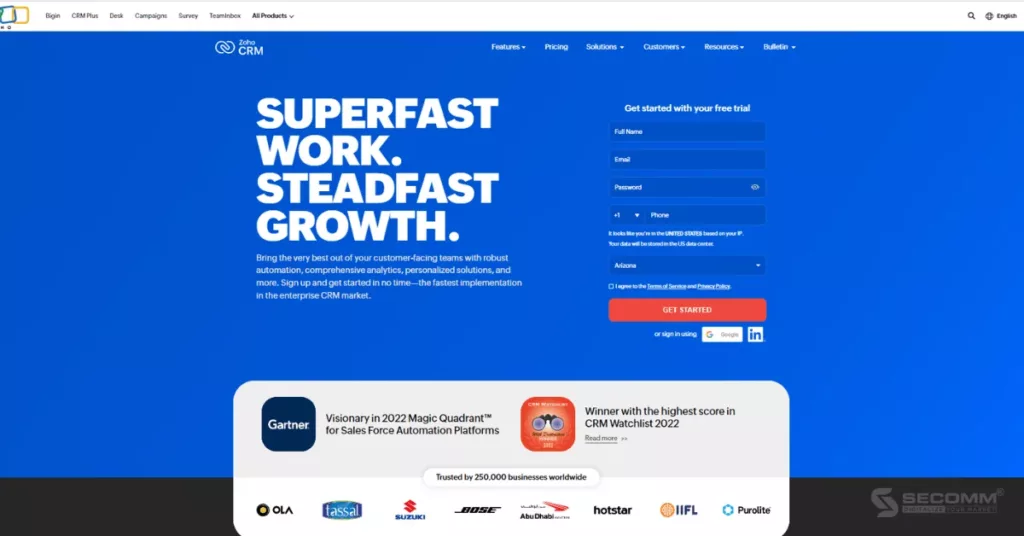
Core features:
- Sales Force Automation: Automates sales tasks such as scheduling sales appointments, sending follow-up emails, tracking leads, and updating sales opportunities.
- Marketing Automation: Provides tools to efficiently run marketing campaigns and deliver high-quality leads to the sales department.
- Performance Management: Streamlines business processes, and enhances sales capabilities with insights relevant to changing market trends.
- Product Customization: Use custom fields, buttons, layouts, link data, localize language and currency, and test before deployment.
- Omnichannel Management: Enables businesses to connect with customers across various channels while collecting essential data to support sales calls.
Costs:
| Pricing plans | Standard | Professional | Enterprise | Ultimate |
| Billed Monthly | $20/user/month | $35/user/month | $50/user/month | $65/user/month |
| Billed Yearly | $14/user/month | $23/user/month | $40/user/month | $52/user/month |
Pros:
- User interface is intuitive and easy to use.
- Allows integration with multiple applications and services to create a unified CRM system.
- Utilizes artificial intelligence to predict customer behavior and suggest relevant actions.
- High-level security features.
- Offers a 15-day free trial version.
Cons:
- Customer support service is not yet fully optimized.
- Customization process requires technical expertise and significant resources.
- The trial version limits many features, making it challenging to evaluate the platform’s capabilities.
NetSuite CRM
Another prominent CRM software for large enterprises is NetSuite CRM. This is a cloud-based CRM platform designed to help businesses manage interactions with current and potential customers, partners, and suppliers.
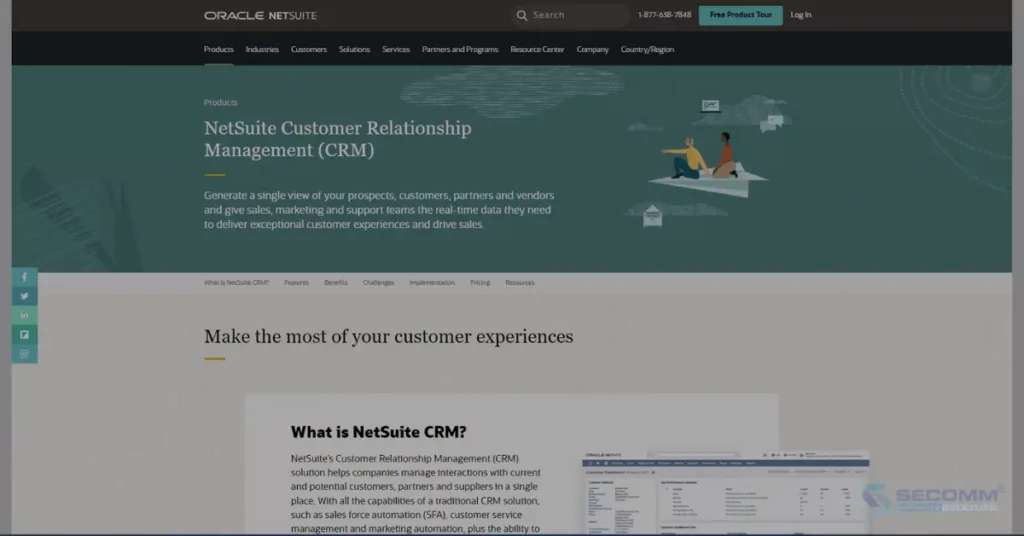
Core features:
- Sales Force Automation: Provides businesses with an integrated sales process, covering lead management, upselling, cross-selling, and quoting to sales forecasting, order management, order fulfillment, and commissions.
- Marketing Automation: Builds, deploys, and measures the effectiveness of marketing campaigns. Tracks potential customers and identifies the moment they are ready to make a purchase, transferring potential customer information to the sales department.
- Customer Service Management: Creates and automates the management process of customer cases, ensuring that customer inquiries are quickly addressed with the answers they need.
- Partner Relationship Management: Controls all aspects of the sales and marketing process between the business and its partners with real-time updated information.
Costs: NetSuite CRM doesn’t publicly disclose its pricing on the website. Therefore, businesses are advised to contact the provider directly for consultation and a price quote.
Pros:
- An all-in-one solution for various aspects of eCommerce such as sales, marketing, and customer service.
- Exceptional customization capabilities to meet the specific deployment needs of each business
Cons:
- The usage cost is not publicly disclosed, making it challenging for businesses to accurately estimate deployment costs.
- Businesses are required to pay the entire deployment cost upfront for the initial setups.
- Users must subscribe to an annual license, incurring additional fees before using this tool.
Related Reading: Explore the 10 best CRM software for large enterprises Pt2
The Bottom Line
Leveraging years of valuable experience supporting various businesses in the deployment of CRM solutions, SECOMM offers valuable insights to help businesses swiftly identify appropriate software and expedite the implementation process.
Contact or call directly to SECOMM’s hotline at 02871089908 for free consultation.
 2
2

 5,168
5,168

 0
0

 1
1
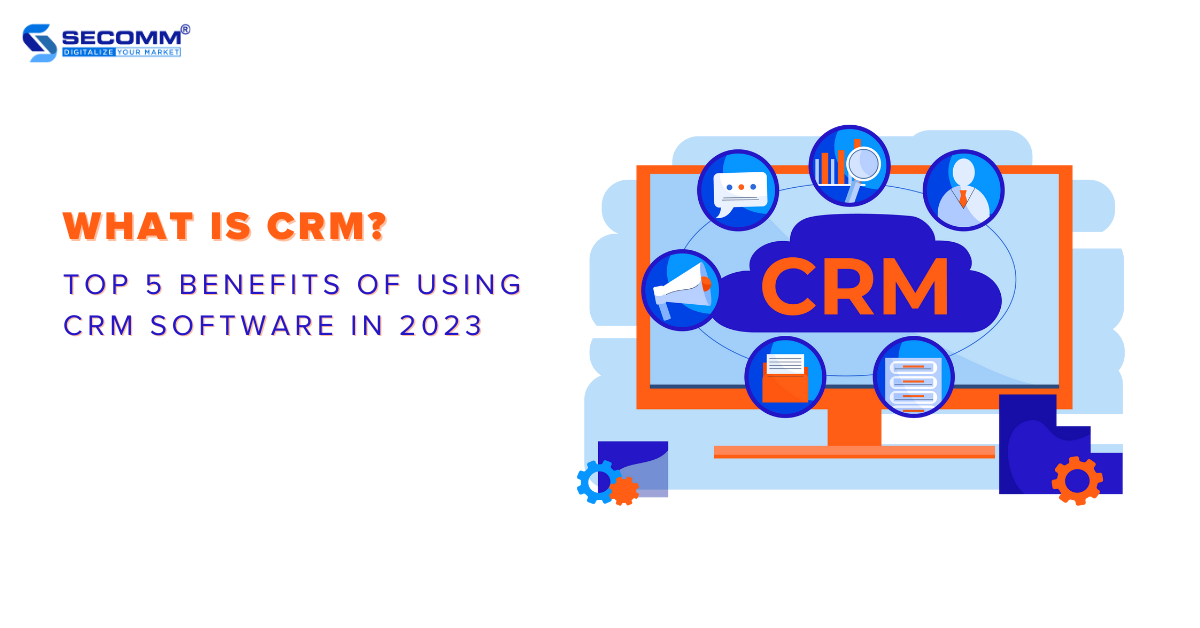
WHAT IS CRM? TOP 5 BENEFITS OF USING CRM SOFTWARE
According to Fortune Business Insight, the projected value of the global Customer Relationship Management (CRM) market for 2023 stands at $71.06 billion, with expectations to surge to around $157.53 billion by 2030, exhibiting a Compound Annual Growth Rate (CAGR) of 12%.
CRM, a software solution, delivers numerous advantages for both sellers and buyers. This tool empowers businesses to forge enduring, meaningful relationships, yielding substantial profits. Meanwhile, customers can enjoy personalized and high-quality experiences.
The following article delves into the detailed definition of CRM, common types of CRM software, core features, and the benefits when businesses use CRM solutions.
What is CRM (Customer Relationship Management)?
CRM or Customer Relationship Management is a software solution crafted to help businesses efficiently manage their relationships with both current customers and potential leads.
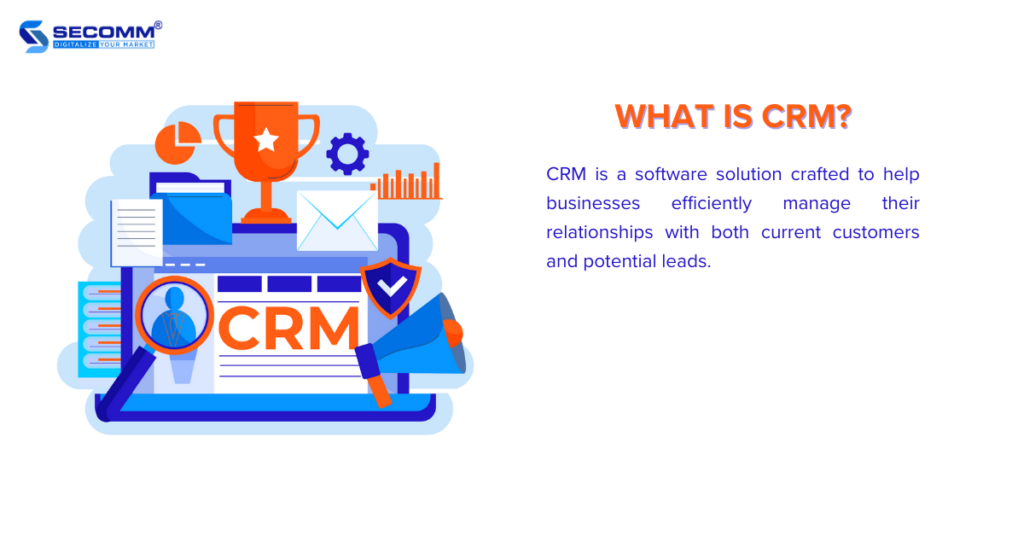
The CRM system is designed to carry out specific tasks, including:
- Gathering customer data from diverse sources and storing it in a centralized database.
- Automating repetitive processes in sales, marketing, and customer service.
- Guiding the management of customers and prospects throughout their purchasing journey.
- Identifying opportunities for up-selling and cross-selling.
- Improving collaboration efficiency within the internal operations of the business.
By utilizing CRM software, businesses can eliminate the need for using scattered spreadsheets and apps. This helps overcome limitations, offering robust features for performance analysis and gaining insights into customer interactions.
Types of CRM Software
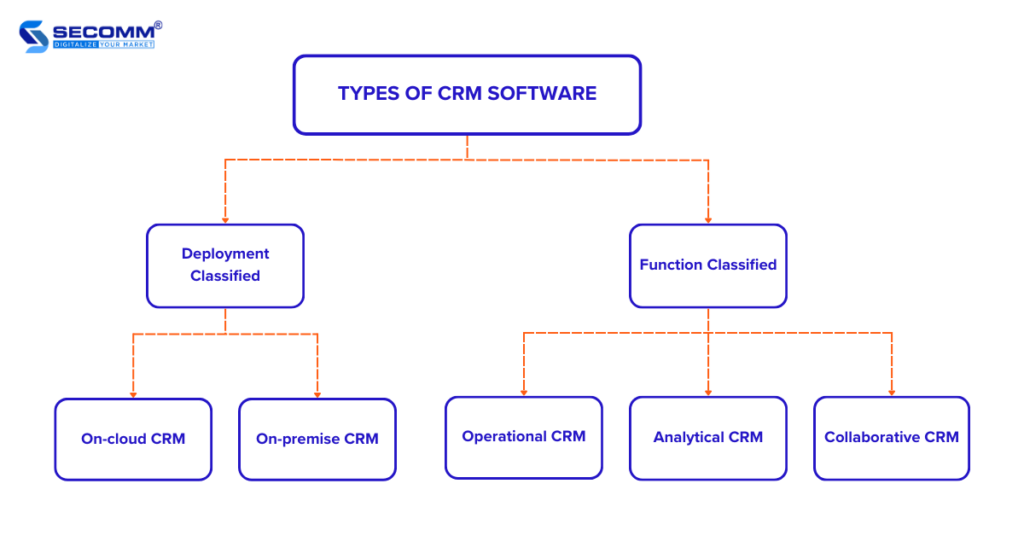
Deployment Classified
- On-premise CRM: This is typically employed to store essential internal data. Under the On-premise CRM model, businesses take responsibility for securing, maintaining, and updating the system.
- On-cloud CRM: It enables businesses to access the system remotely from any device with an internet connection. In this case, the CRM service provider takes on the responsibility for ensuring security, maintenance, and system updates.
Related Reading: On-premise CRM vs On-cloud CRM: Key Differences
Function Classified
- Operational CRM
These CRM systems are crafted to help businesses manage sales, marketing, and customer service activities. The main goal of CRM software is to generate a pool of new potential customers, nurture these leads, convert them into loyal customers, and retain them through effective marketing strategies and top-notch customer service.
- Analytical CRM
While the Operational CRM system helps businesses enhance customer attraction and retention, the Analytical CRM system allows businesses to understand how potential customers move through the sales funnel. These CRM solutions gather, store, and analyze customer data, delivering detailed insights into customer interactions with the business.
This facilitates businesses in assessing the effectiveness of marketing, sales, and customer care initiatives, allowing them to make necessary adjustments.
- Collaborative CRM
The main goal of Collaborative CRM software is to improve customer experience and streamline business processes by enabling communication and data sharing among internal departments and external stakeholders (suppliers, partners).
While operational and analytical CRM systems also allow for data sharing, collaborative CRM places a greater emphasis on enhancing the customer experience.
It is especially favored by businesses with extensive customer databases that necessitate tight collaboration between departments (sales, marketing, customer care) to ensure the optimal customer experience.
Top 6 Core CRM features
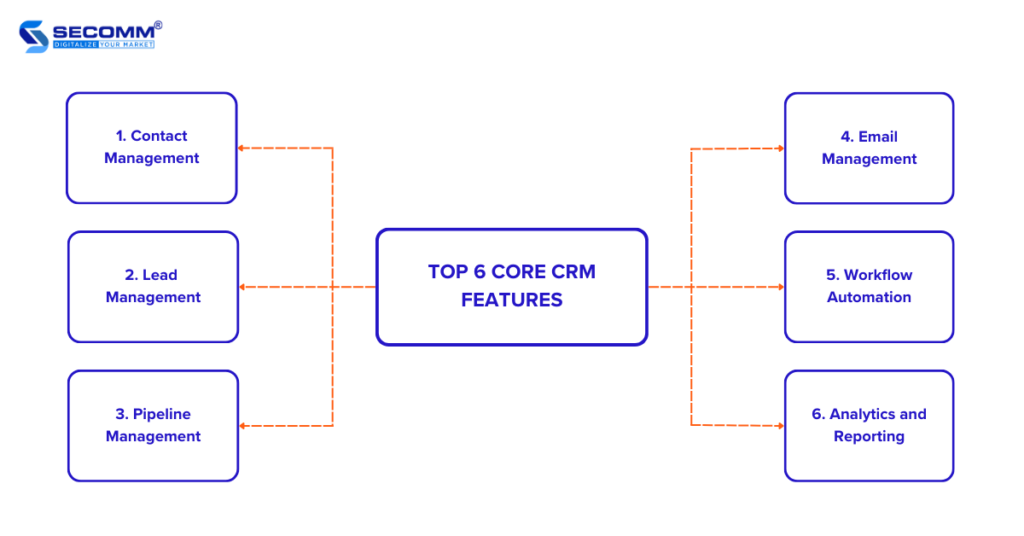
Contact Management
The first important feature to mention in CRM software is Contact Management. This feature allows businesses to store information related to customers and potential customers on the platform, ranging from their names, phone numbers, email addresses, and job details to more in-depth data such as interaction history and how each customer interacts with the business.
Lead Management
Lead Management is one of the core CRM features. This feature supports marketing and sales efforts by:
- Attracting potential customers from various sources.
- Organizing data related to potential customers.
- Segmenting potential customers based on criteria.
- Creating a scoring framework to assess conversion potential.
- Automating personalized interactions to foster relationships.
Pipeline Management
The Pipeline Management feature provides businesses with a visual overview of potential customers and existing transactions. Deals are separated into different stages of the pipeline. This helps sales representatives understand the status of each potential customer and aids them in deciding which leads to pursue.
Email Management
Utilizing the Email Management feature, businesses can seamlessly integrate their email functionality with CRM software, facilitating the sending and receiving of emails directly within the CRM system interface.
This streamlined approach saves time, eliminating the need to navigate between various tabs for email communication and ensuring no missed opportunities to engage with potential customers.
Workflow Automation
The next crucial feature in CRM solutions is Workflow Automation, which comprises three fundamental aspects: Marketing Automation, Sales Automation, and Customer Service Automation.
Marketing Automation
The ‘Marketing Automation’ feature helps businesses simplify the marketing process by designing trigger elements for specific actions of customers and potential customers, such as:
- Sending a welcome email to potential customers when they sign up for an account.
- Sending a survey email after they have used a product for a certain period (e.g., 90 days).
- Providing customers with information about related products to what they have purchased or sending discount codes for products left in their shopping carts.
In summary, the automated marketing process in the CRM system utilizes the “if-then” logic to automatically trigger interactive activities after customers or potential leads perform specific actions.
Sales Automation
Similar to ‘Marketing Automation,’ the ‘Sales Automation’ feature also uses trigger elements to help sales representatives automatically provide purposeful interactions with customers at specific points in the sales process.
Additionally, Sales Automation assists sales representatives in scoring and managing potential customers, while automatically generating sales forecast reports, enabling businesses to make informed decisions.
Examples of sales automation process:
- Invite potential customers to subscribe to the newsletter when they first visit the website.
- Automatically send a follow-up email if they go silent (for example, 36 hours) after receiving a product quote.
- Automatically assign potential customers to different sales representatives.
Customer Service Automation
‘Customer service automation’ in CRM solutions refers to the use of automation technologies to enhance and optimize the customer service experience.
This may include using chatbots for online support, sending automatic notifications and updates to customers, automating the handling of basic customer requests and inquiries, and various other activities to save time and streamline workflows.
Analytics and Reporting
The ‘Analytics & Reporting’ feature in CRM solutions plays a crucial role in analyzing data and generating reports to help businesses gain a deeper understanding of their business performance, customer interactions, and market trends.
This is an important tool that enables businesses to make decisions based on accurate data, improve customer interactions, and optimize business strategies.
Top 5 CRM Software Benefits
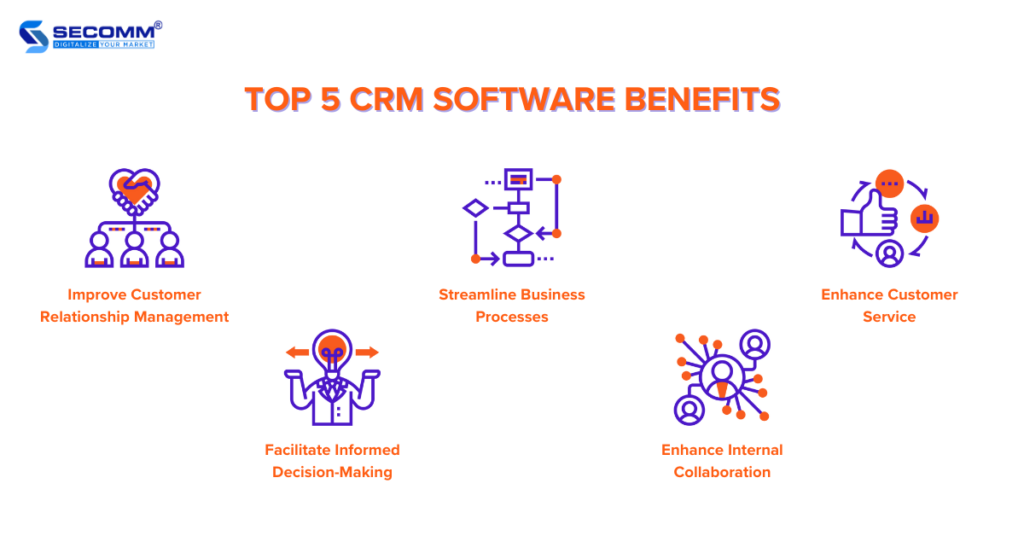
Improve Customer Relationship Management
CRM software plays a pivotal role in enabling businesses to gather and store comprehensive information about customers, including interaction history and personal details. This helps understand customers and creates a personalized interaction experience, from providing better services to developing appropriate outreach strategies.
Streamline Business Processes
CRM systems help automate many aspects of the business process, such as sales management, marketing, and customer interaction tracking. This results in increased work efficiency, minimizes errors and enhances the ability to interact effectively with customers.
Enhance Customer Service
CRM platforms provide tools such as automated chatbots and customer support systems, facilitating the swift resolution of customer requests and inquiries. This enhances the customer experience, builds trust, and increases the chances of establishing long-term relationships
Facilitate Informed Decision-Making
The CRM software’s data analysis features contribute to a more profound comprehension of customer behavior, business performance, and emerging market trends. This empowers businesses to make informed decisions and anticipate future developments.
Enhance Internal Collaboration
CRM software facilitates tight collaboration among different departments within a business, working together on the platform. This encourages the exchange of information and internal interactions, ultimately enhancing data consistency, feedback capabilities, and accurate responsiveness to customer needs.
Boost Your Customer Engagement through CRM Solutions!
There’s no doubt that CRM software offers incredible benefits to businesses. From efficiently managing customer relationships to optimizing business processes and providing the best customer experience. CRM is not just a tool but a viable strategy that helps businesses build and maintain relationships with their customers.
Over the years, SECOMM has been accompanying many clients in developing CRM solutions. We have observed that in a competitive business landscape, choosing the appropriate CRM software is as crucial as understanding customers and implementing CRM strategies.
Contact SECOMM or call the hotline at (+84)28 7108 9908 for a free consultation.
 2
2

 5,518
5,518

 0
0

 1
1
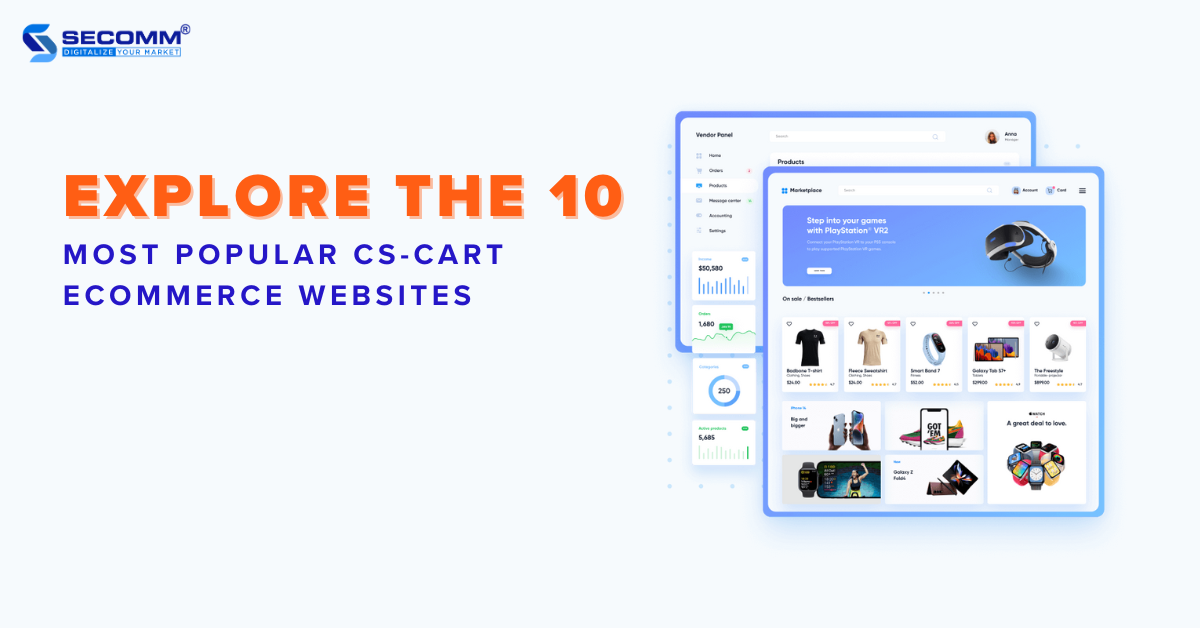
EXPLORE THE 10 MOST POPULAR CS-CART ECOMMERCE WEBSITES
CS-Cart is a versatile eCommerce platform, available in both open-source and SaaS models. Established in 2005 under Simbirsk Technologies Ltd., it has garnered trust from medium-sized and large businesses. Its reputation is built on robust customization options, numerous features, and supplementary utilities within its ecosystem.
Listed below are brands that have built their CS-Cart eCommerce websites.
House of CB
House of CB is a leading women’s fashion brand in London, United Kingdom. Renowned for its meticulously crafted collections tailored for significant events, the brand was established by Conna Walker at the age of 17, backed by a £3,000 loan from her father.

Faced with initial capital constraints, House of CB strategically leverages eCommerce to engage with its potential customers. Over time, the brand has graced the wardrobes of numerous Hollywood luminaries, including Beyonce, Gigi Hadid, Lady Gaga, Jennifer Lopez, and the Kardashians.
- Website: https://www.houseofcb.com/
- Industry: Fashion
- Traffic: 1.8M/month (7/2023)
- Ranking: #28,116 (Worldwide), #12,982 (UK)
Maxbhi
Maxbhi is an eCommerce venture operated by Elcotek India Private Limited in India. The CS-Cart website is dedicated to offering a wide range of accessories for electronic devices, including mobile phones, tablets, laptops, and more, specifically within the Indian market.
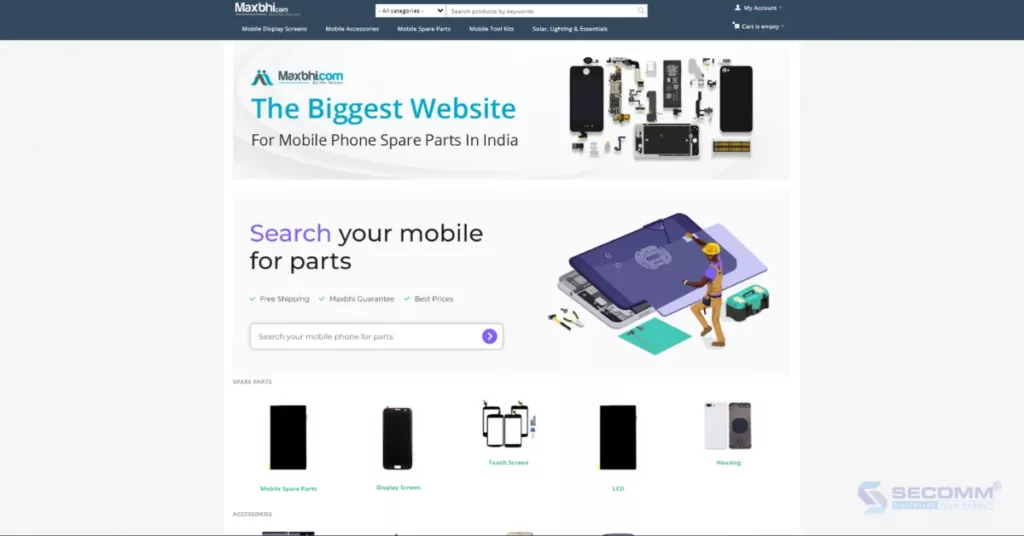
Launched in 2004 in Ghaziabad, India, this CS-Cart eCommerce website has grown to become one of the largest and most enduring online stores for phone accessories in the country.
- Website: http://maxbhi.com/
- Industry: Consumer electronics
- Traffic: 1.7M/month (7/2023)
- Ranking: #32,992 (Worldwide), #2,410 (India)
Harvey Norman
Harvey Norman is a leading retailer in New Zealand, offering a diverse range of products including computers, electronics, furniture, bedding, and household appliances from renowned global brands.
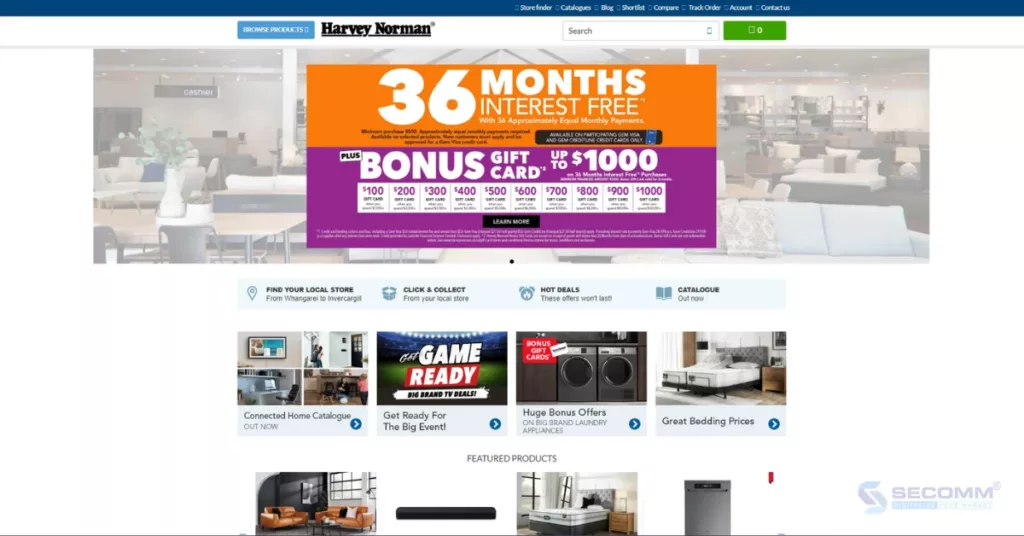
This initiative is part of the franchise system operated by Harvey Norman Holdings Limited, a publicly listed company on the Australian Securities Exchange Limited. The company’s main activities encompass retail, franchise operations, real estate, and digital enterprises.
- Website: https://www.harveynorman.co.nz/
- Industry: Retail
- Traffic: 1.4M/month (7/2023)
- Ranking: #40,692 (Worldwide), #115 (New Zealand)
Enter
Enter stands out as one of Moldova’s major retailers in the consumer electronics sector. Boasting a network of 25 traditional stores across the country, Enter focuses on delivering a wide range of electronic devices, including mobile phones, tech accessories, home appliances, and more.
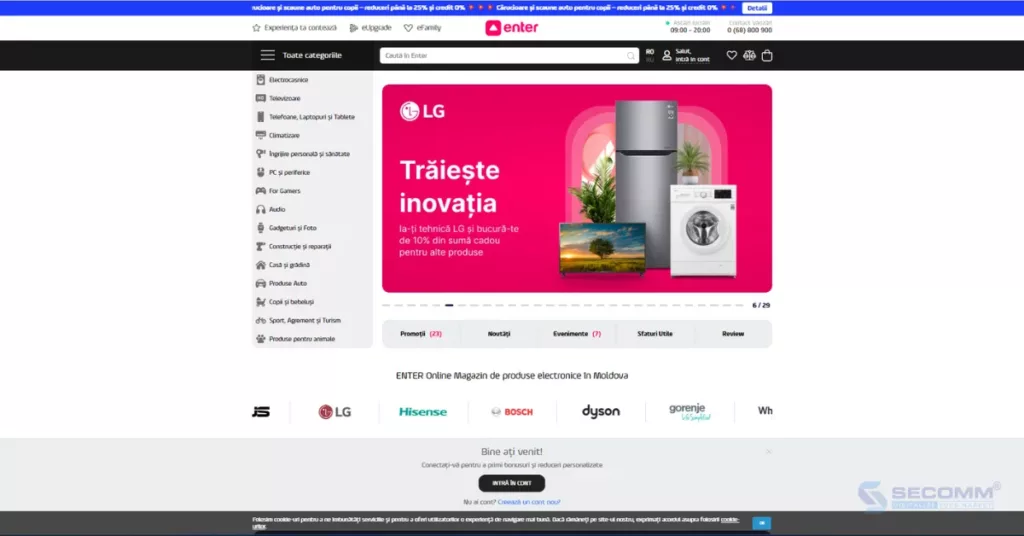
Moreover, Enter has established itself as a trusted authorized dealer for renowned brands such as Apple, Samsung, Xiaomi, Dyson, Lenovo, LG, and others. With future plans in mind, the company aims to further expand its brick-and-mortar stores and enhance its eCommerce website for an even more convenient shopping experience for customers
- Website: https://enter.online/
- Industry: Retail
- Traffic: 705.9K/month (7/2023)
- Ranking: #76,885 (Worldwide), #73 (Moldova)
Mobilier1
Mobilier1 is a Romanian CS-Cart eCommerce website specializing in the furniture industry. With over a decade of experience, the company remains focused on manufacturing and selling furniture within the eCommerce market. Mobilier1 consistently earns praise for the high quality of its products and services, providing competitive pricing compared to other market players.
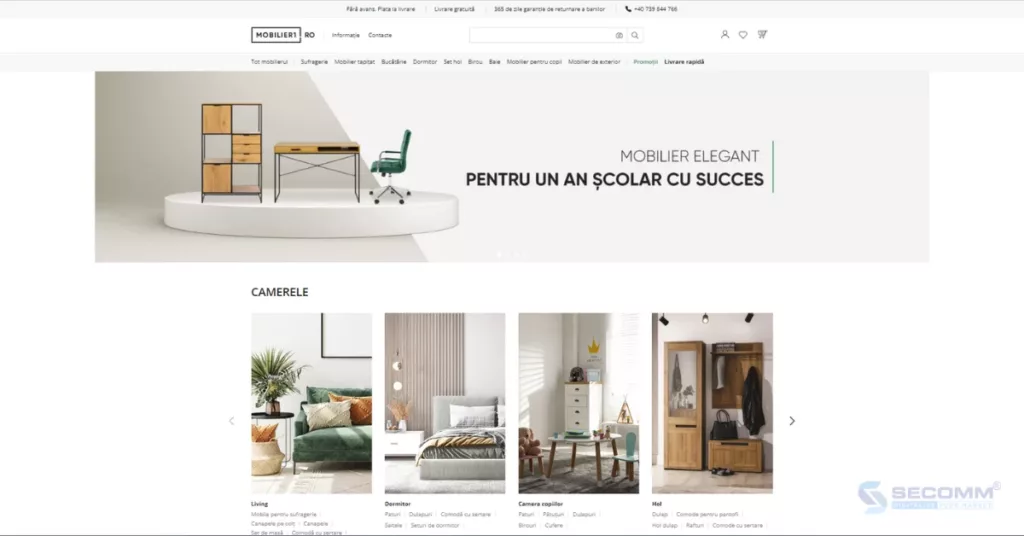
Furthermore, Mobilier1 offers additional services such as nationwide free delivery and a 365-day return policy, ensuring a seamless experience for its customers.
- Website: http://mobilier1.ro/
- Industry: Furniture
- Traffic: 365.5K/month (7/2023)
- Ranking: #142,635 (Worldwide), #726 (Romania)
Butor1
Butor1 is a Hungarian business specializing in the distribution of furniture and interior accessories. Over the past decade, the company has formed direct partnerships with renowned furniture manufacturers to offer customers products at reasonable prices.
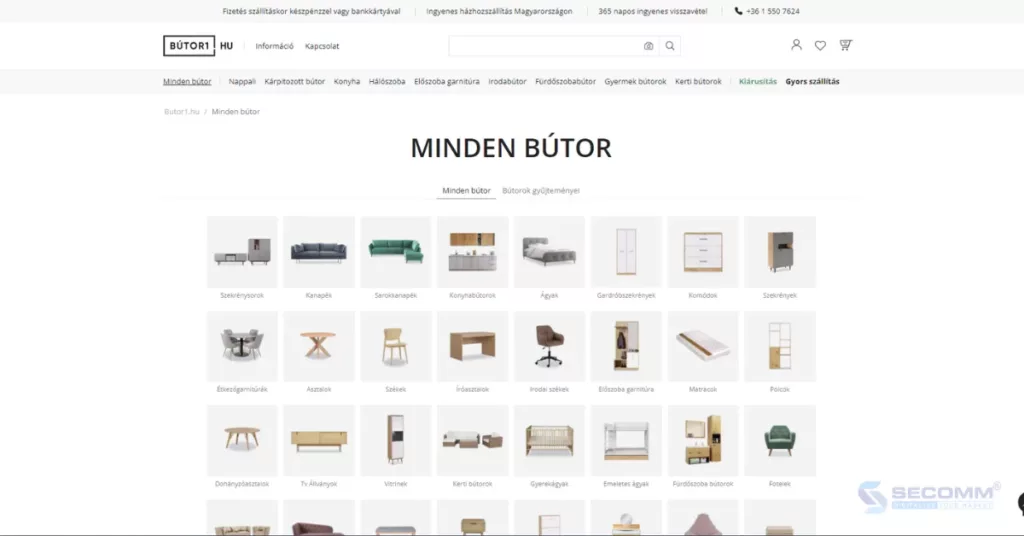
Recently, Butor1 has taken a step further by combining CS-Cart eCommerce website operations with sustainable practices, pledging to plant a tree for each successfully placed order, demonstrating its commitment to environmental responsibility.
- Website: https://www.butor1.hu/
- Industry: Furniture
- Traffic: 340.0K/month (7/2023)
- Ranking: #140,320 (Worldwide), #733 (Hungary)
Siriust
Siriust is a CS-Cart eCommerce website under the umbrella of Profi, a leading retail chain in Russia. Specializing in tech accessories like smartphones, laptops, wireless devices, and repair tools, Siriust boasts a catalog of over 16,000 products.
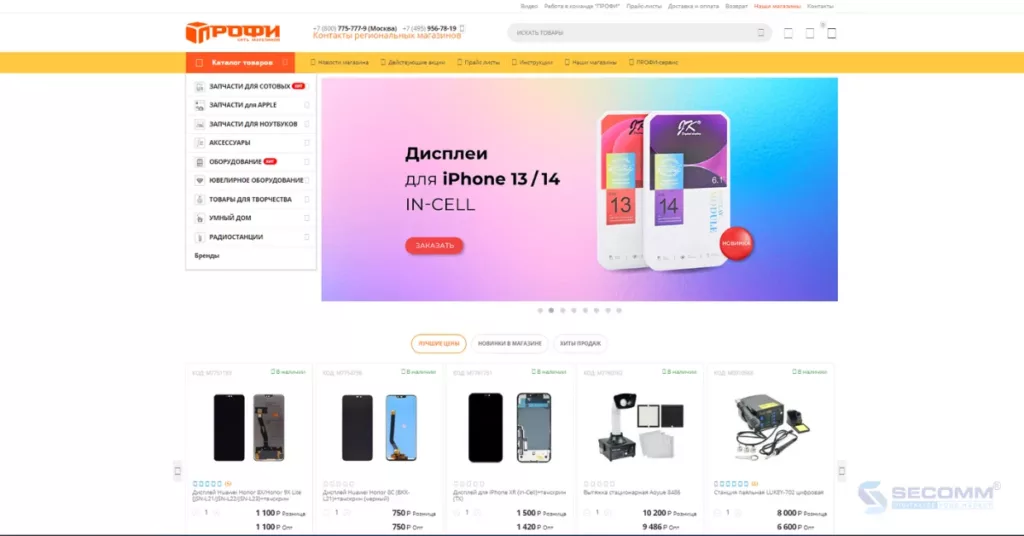
With 50 physical stores in major Russian cities, the company has strategically introduced a CS-Cart website, enabling customers to conveniently make online purchases and pick up their orders from the nearest store.
- Website: http://siriust.ru/
- Industry: Consumer electronics
- Traffic: 318.4K/month (7/2023)
- Ranking: #151,245 (Worldwide), #7,774 (Russia)
Topsto
Topsto is an online store serving customers in both B2B and B2C sectors in the Crimea region, Ukraine. With an expansive product catalog comprising over 280,000 items, Topsto’s CS-Cart website gained favor among customers for its varied product range, affordable pricing, and swift delivery services across the Crimea region.
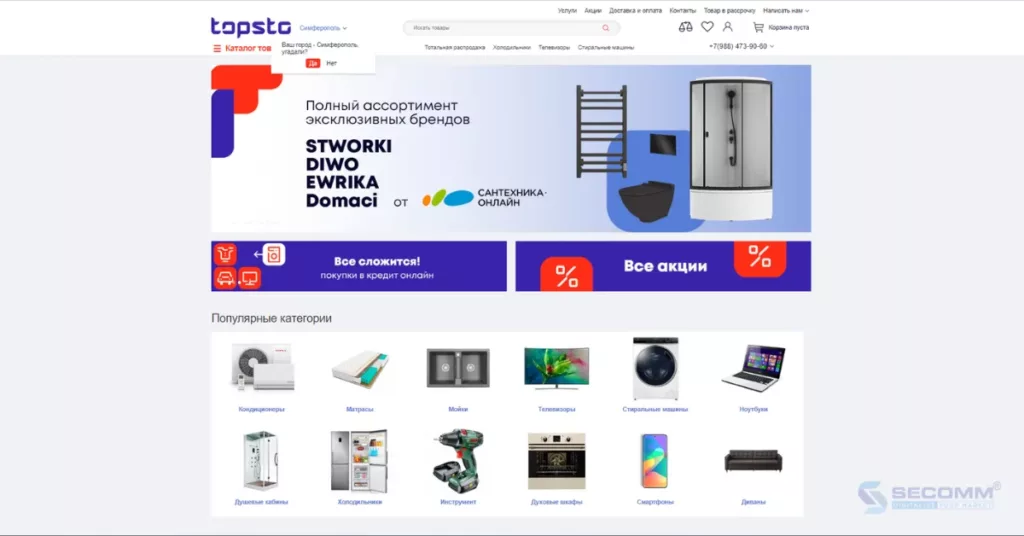
- Website: https://topsto-crimea.ru/
- Industry: Retail
- Traffic: 220.8K/month (7/2023)
- Ranking: #167,337 (Worldwide), #4,166 (Ukraine)
Ucuzkitapal
UcuzKitapal is a Turkish online book retail business with a loyal customer base of over 85,000. The store offers a vast collection of books covering diverse genres, including education, literature, economics, self-development, and more.
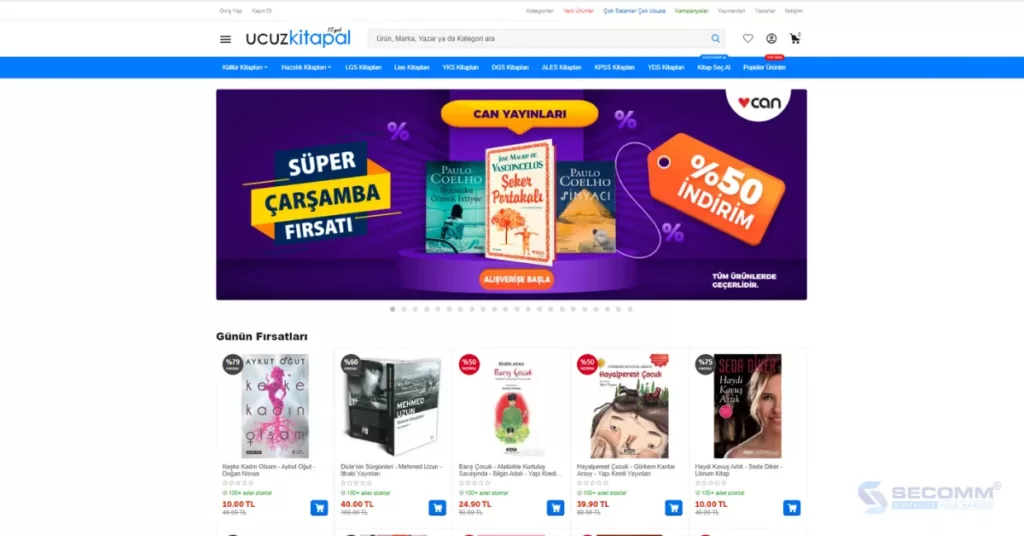
Through the early adoption of a CS-Cart eCommerce website, the business consistently satisfies book-buying needs with highly competitive prices, swift delivery, and attractive offers.
- Website: https://www.ucuzkitapal.com/
- Industry: Online book retail
- Traffic: 146.8K/month (7/2023)
- Ranking: #227,028 (Worldwide), #5,881 (Turkey)
Riviera Couleurs
Riviera Vaudoise is a paint and coating business established 40 years ago in the “Riviera Vaudoise” region in western Switzerland. Renowned for its picturesque landscapes, traditional villages, rose gardens, and idyllic lakeside views, the region provides an exquisite backdrop.
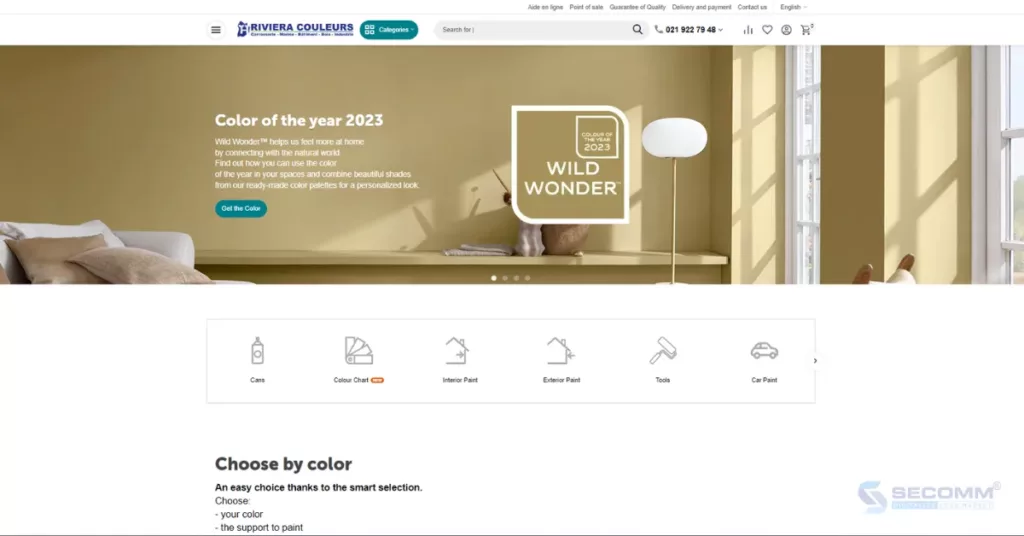
Over the years, Riviera Vaudoise has evolved into the premier destination for oil-based paints in the area, catering to diverse needs such as automotive, residential, and wood applications.
Currently, the company has built its CS-Cart website to extend its business footprint into the realm of eCommerce, aiming to connect with a broader audience of potential customers throughout Switzerland.
- Website: https://www.magasindepeinture.ch/
- Industry: paint and coating
- Traffic: 41.1K/month (7/2023)
- Ranking: #1,367,213 (Worldwide), #272,883 (Switzerland)
Here are 10 CS-Cart eCommerce websites that have not only successfully developed their online presence but have also achieved notable success in their respective industries. This triumph serves as inspiration for other businesses looking for effective solutions to elevate their operations and enhance competitiveness in the market.
Drawing on substantial experience in implementing eCommerce solutions for clients across diverse countries, SECOMM comprehends the challenges and hurdles businesses encounter during the deployment process.
Contact SECOMM today or call the hotline at 02871089908 for a free consultation.
 2
2

 7,445
7,445

 0
0

 1
1
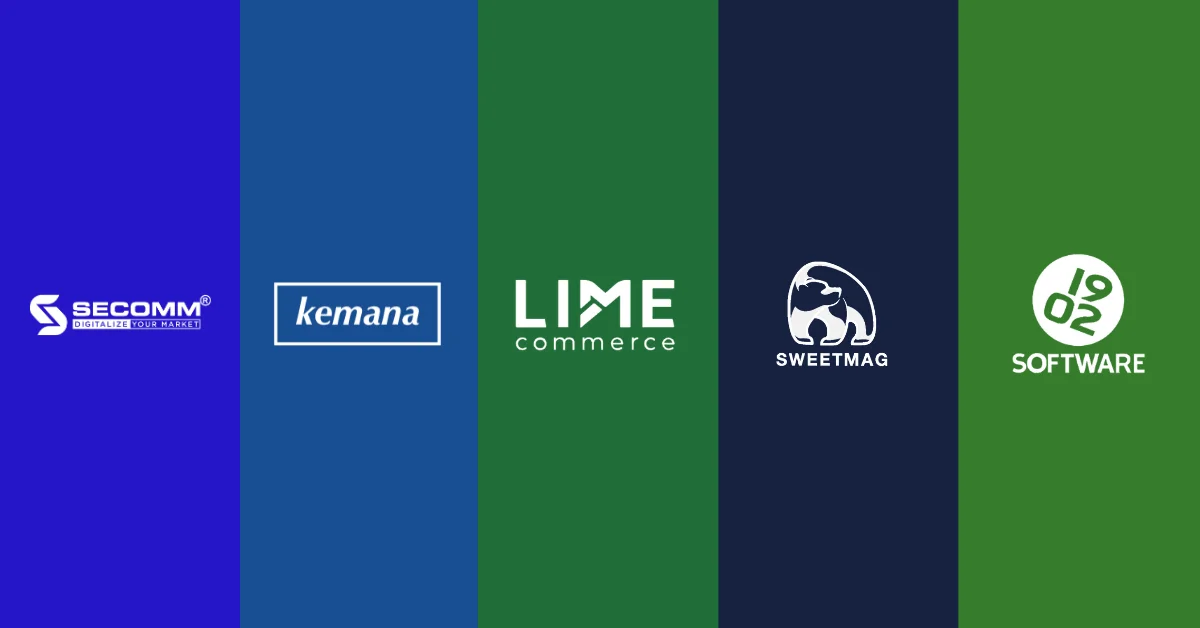
TOP 5 MAGENTO DEVELOPERS IN SOUTH EAST ASIA (SEA)
The eCommerce landscape in SEA is experiencing robust growth, with a CAGR of 11.43%. The anticipated total revenue for 2023 is projected to reach USD 109 billion, as reported by Statista. Moreover, there are over 2000 eCommerce websites built on the Magento platform within this market.
For most Magento deployment projects, collaboration with experienced developers on this platform is crucial. This partnership ensures joint planning, design, and development of customized websites tailored to the specific requirements of each business.
This article will delve into why Magento remains the preferred platform for eCommerce website development and spotlight the top 5 Magento developers in the SEA region, including Kemana (Indonesia), Lime Commerce (Indonesia), SECOMM (Vietnam), Sweetmag (Malaysia), and 1902 Software (Philippines).
What is Magento?
Magento is an open-source eCommerce platform built using the PHP programming language and the Zend Framework. In 2018, Adobe officially acquired Magento and rebranded it as Adobe Commerce, aiming to integrate this platform into Adobe’s suite of digital solutions.
This merger has enhanced Magento’s capabilities and provided businesses with a more comprehensive eCommerce solution powered by Adobe.
Magento has two main versions: Magento Open Source – a free version (formerly known as Magento Community Edition) and the paid version called Adobe Commerce (formerly Magento Commerce).
The paid version offers users two options: on-premise and on-cloud, with numerous upgraded features and enhancements to meet higher demands for customization and scalability.
Why do brands choose Magento?
Customization & Scalability
Being an open-source platform, Magento provides businesses with the flexibility to access and modify source code, functionalities, themes, and extensions. Moreover, Magento can efficiently handle up to 500,000 daily visits and imposes no restrictions on annual sales volumes.
According to BuiltWith, there are currently over 144,000 active Magento websites including several global brands experiencing significant traffic, such as:
- Samsung – 1 billion/month (USA)
- Walmart – 394 million/month (USA)
- Nike – 141 million/month (USA)
- Adidas – 29.2 million/month (USA)
- Levi’s – 10.6 million/month (USA)
Notably, some high-traffic eCommerce websites in the Southeast Asian market are also using Magento, such as:
- Didongviet – 4.4 million/month (Vietnam)
- Abenson – 1 million/month (Philippines)
- Klik Indomaret – 3.8 million/month (Indonesia)
These leading brands leverage the Magento platform to execute complex customizations for their eCommerce systems, enhancing their capabilities in handling high traffic, extensive product catalogs, and substantial sales volumes. Therefore, for any business seeking a highly customizable and scalable eCommerce platform, Magento is likely the first name that comes to mind.
Headless Commerce
Headless Commerce is an eCommerce trend with 80% of businesses planning to adopt this approach within the next two years, according to Salesforce’s “State of Commerce” report.
For the demands of Headless architecture, the open-source Magento platform stands out as an optimal choice. Unlike traditional Magento architecture, Headless Magento utilizes GraphQL API to support various frontend designs for different devices and screens. This setup is optimized and integrated into the existing backend system to deliver a seamless omnichannel experience.
Moreover, Adobe offers enterprises an advanced suite to enhance the efficiency of Headless Commerce operations. This suite includes Adobe Experience Manager (Content Management), Adobe Analytics (In-depth analytics reporting), and Adobe Marketo Engage (Marketing automation).
PWA Studio
According to Emergen Research, the global Progressive Web App (PWA) market is expected to reach 10.44 billion USD by 2027. Therefore, it’s not surprising that many businesses are turning to Magento’s PWA Studio features. This toolkit facilitates the rapid development, launch, and maintenance of PWAs.
Moreover, businesses adopting Headless Commerce can seamlessly integrate with PWA Studio to customize frontend designs. PWAs are often combined with Headless architecture to create Headless PWAs, replacing conventional frontends with PWA storefronts to enhance website performance.
Moreover, Magento PWA utilizes Service Worker technology for device caching, significantly boosting page load speeds by 2 to 3 times.
Magento Global Community
Magento boasts a thriving and engaged community comprising developers, designers, and users. This community consistently generates modules, themes, plugins, and integrated add-ons for the Magento platform.
Moreover, there are many Magento developers in the market, making it easy for businesses to find a suitable partner.
In addition, prominent forums like Reddit, Quora, Substack, Slack Groups, and online conferences provide platforms for Magento users to exchange knowledge and experiences.
Hence, beyond direct support from collaborative partners, these forums serve as invaluable resources whenever businesses face challenges or require assistance throughout the Magento deployment journey.
Top 5 Magento Developers in SEA
Magento is designed to meet almost every need when it comes to creating professional and custom eCommerce websites.
However, not all businesses have the technical expertise and understanding of Magento to start and successfully implement this platform. This is why many businesses seek to collaborate with Magento developers to bring their ideas and business goals to life.
Below are 5 Magento agencies in South East Asia, boasting exceptional experience and expertise.
SECOMM (Vietnam)
SECOMM is known as a provider of comprehensive and specialized eCommerce solutions tailored to each business model and requirement.
Established in 2014, SECOMM has successfully collaborated on and developed Magento eCommerce websites for numerous major clients spanning from Australia, Singapore, Hong Kong to Vietnam, including LaybyLand, Changi Airport Group, My Market, Annam Group, and Vinamilk.
Going beyond Magento website development collaborations, SECOMM and its clients strategically outline sustainable short and long-term development plans, ensuring continued leadership in the targeted markets.
With vast experience in executing over 300 custom Magento website development projects for clients worldwide, SECOMM has firmly established itself as a premier professional Magento developer in Vietnam.
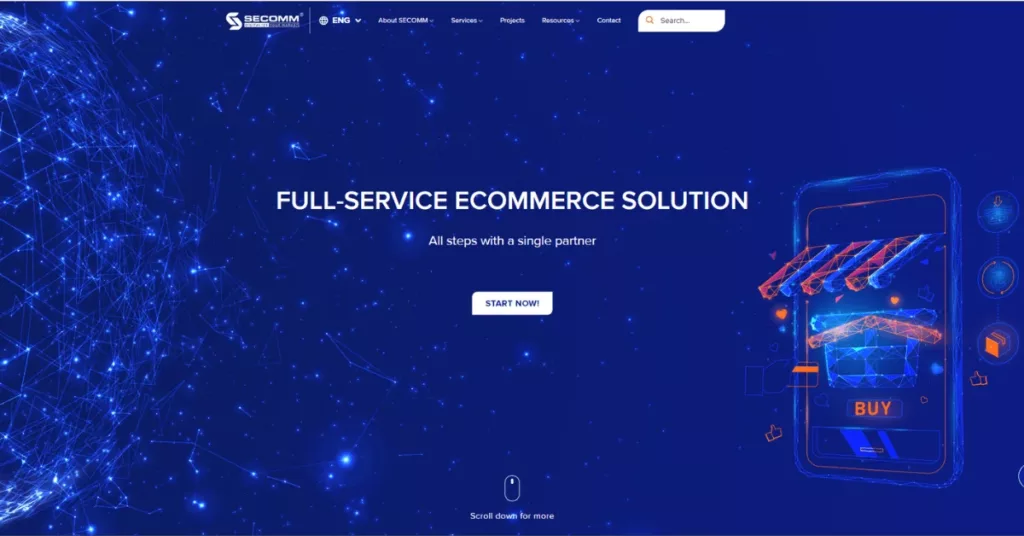
Kemana Technology (Indonesia)
Established in 2011, Kemana Technology is a private company consisting of a team of experts with over a decade of experience in the eCommerce industry. Recognized as an official Silver partner of Adobe, Kemana stands out as a leading Magento developer in the broader APAC region and specifically in Indonesia.
When it comes to eCommerce website development services, Magento is the core technology solution that the company suggests to its clients.
Moreover, Kemana leverages Magento’s exceptional customization capabilities to deliver Omnichannel deployment solutions for retailers, offering two primary services: Click & Collect (Pick Up In-store) and Ship From Store.
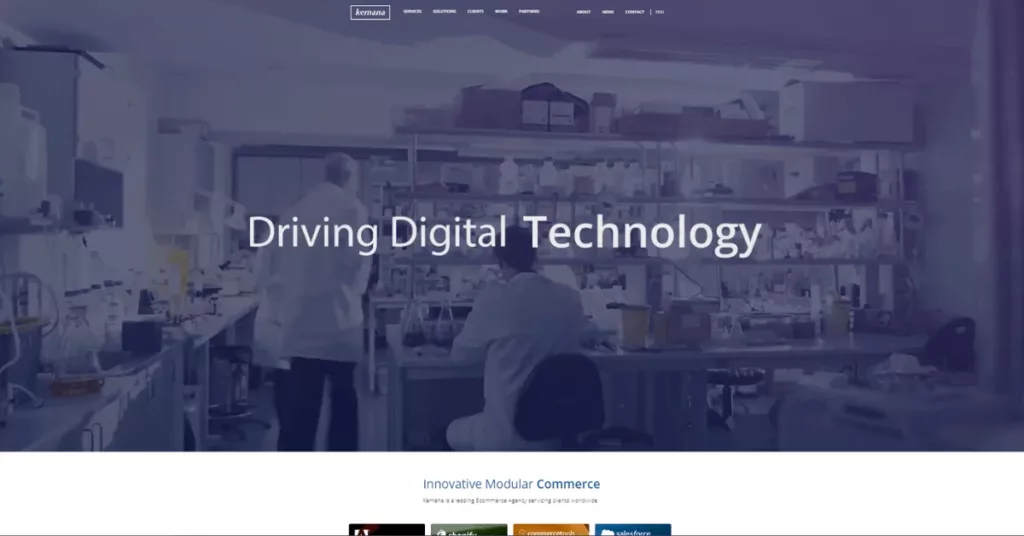
Lime Commerce (Indonesia)
Similar to Kemana Technology, Lime Commerce is also among the top Magento developers in Indonesia. Established in 2014, the company holds the Bronze partnership status in the Adobe Solution Partner Program. Lime Commerce provides personalized solutions tailored to meet the deployment needs of each customer segment.
As a dedicated eCommerce development company focusing on Magento, Lime Commerce offers a range of comprehensive services and solutions related to the Magento platform.
This includes custom design and development of Magento eCommerce websites, system maintenance and updates, optimization of website performance and security, and implementation of various crucial integrations.
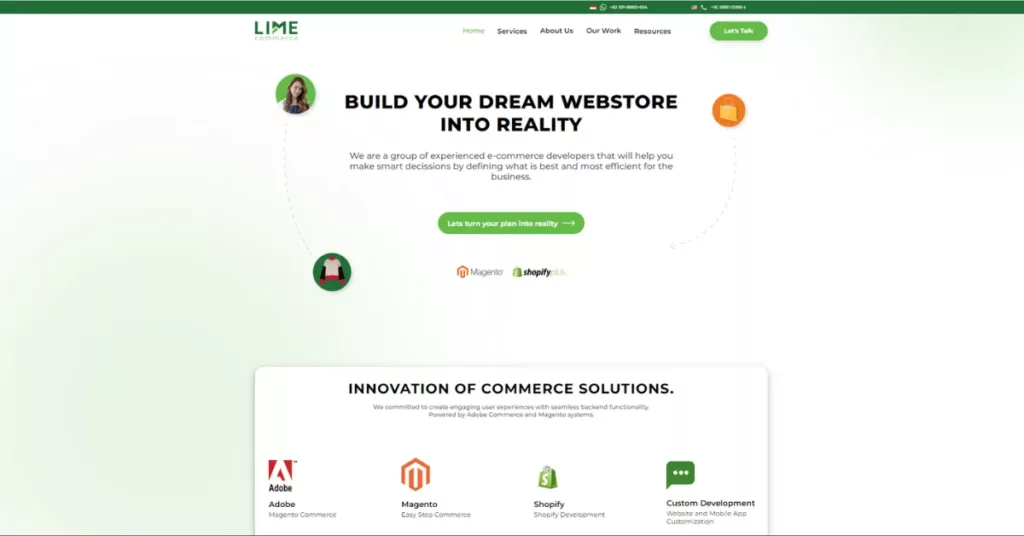
Sweetmag Solutions (Malaysia)
Established in 2008, Sweetmag Solutions has distinguished itself as a premier provider of Magento website development solutions in Malaysia, offering a range of associated web services. Over the years, Sweetmag has achieved Bronze-level partnership status in the Adobe Solution Partner program.
Sweetmag provides a seasoned team to build Magento eCommerce websites to meet specific requirements and objectives related to customer experience and conversion.
Through collaborations with prominent brands like Padini, Innisfree Malaysia, Parkson Online, and Caring Pharmacy, the company has firmly established its position in the Malaysian eCommerce market.
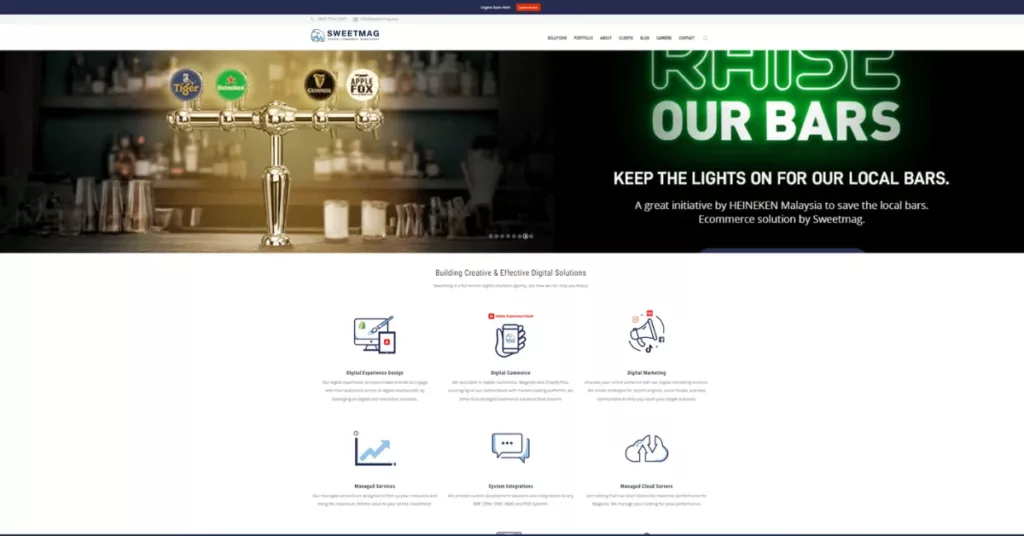
1902 Software (Philippines)
Founded and operated since 1998 by Danish programmer Peter, 1902 Software has evolved into a prominent software development and eCommerce solutions company in the Philippines. Their key services include AI development, eCommerce solutions, custom software development, and innovative design, all of which contribute to their notable reputation.
In the realm of eCommerce development, the company excels in delivering solutions for creating powerful, flexible, and scalable Magento websites. With a track record of successful projects, 1902 Software has earned positive reviews from satisfied clients.
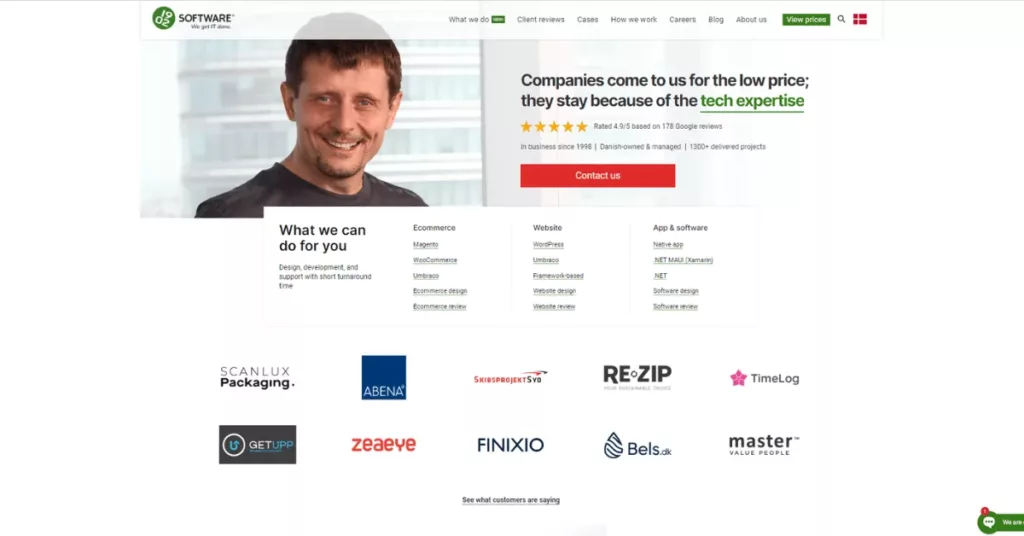
Start Your eCommerce Journey with Magento Today!
The effectiveness and popularity of Magento are demonstrated by the numerous businesses, spanning from medium-sized enterprises to large corporations, that have successfully implemented and operated their eCommerce websites on this platform. Moreover, the global Magento developer community is extensive, and the Southeast Asian region is no exception, featuring top-notch specialists with high technical expertise and extensive experience in Magento, as mentioned in the article.
Contact or call SECOMM’s hotline at (+84)28 7108 9908 to build your Magento eCommerce website today!
 2
2

 5,478
5,478

 0
0

 1
1
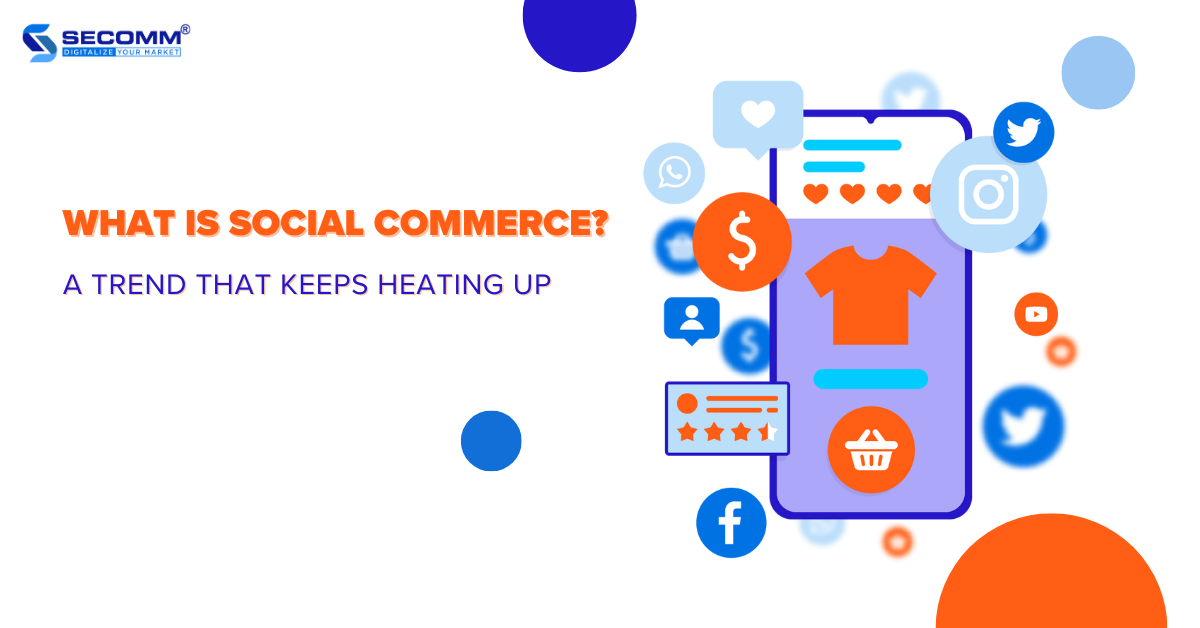
WHAT IS SOCIAL COMMERCE? A TREND THAT KEEPS HEATING UP
As per Statista’s data, Social Commerce worldwide generated 992 billion USD in revenue in 2022, with projections indicating a potential surge to 2.9 trillion USD by 2026. This positions Social Commerce as a highly valued and potential trend in the future of eCommerce.
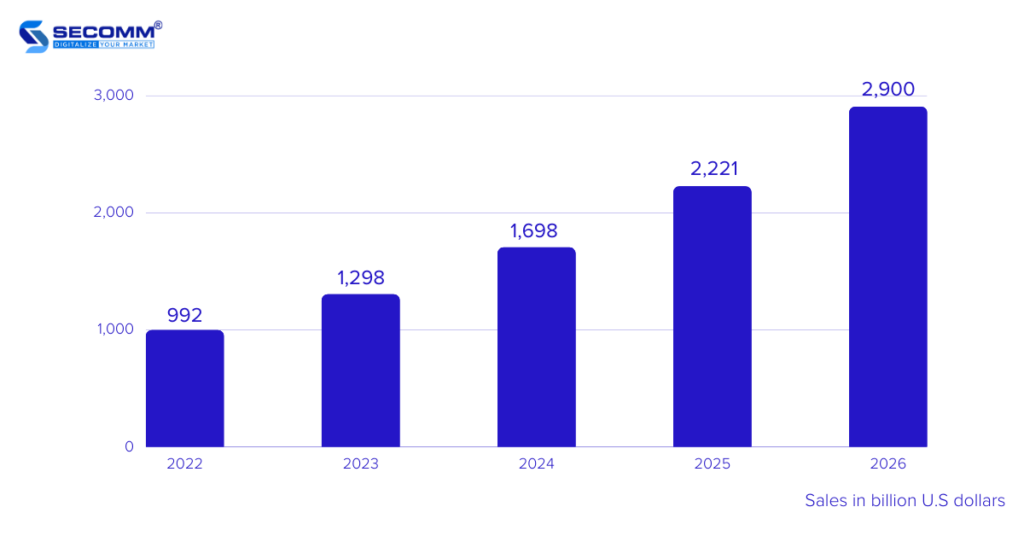
What is Social Commerce?
Social Commerce is a term that combines two key concepts: “Social” and “Commerce”.
It represents a business model that seamlessly integrates social media and eCommerce, aiming to create a shopping experience that is more interactive and connected for customers.
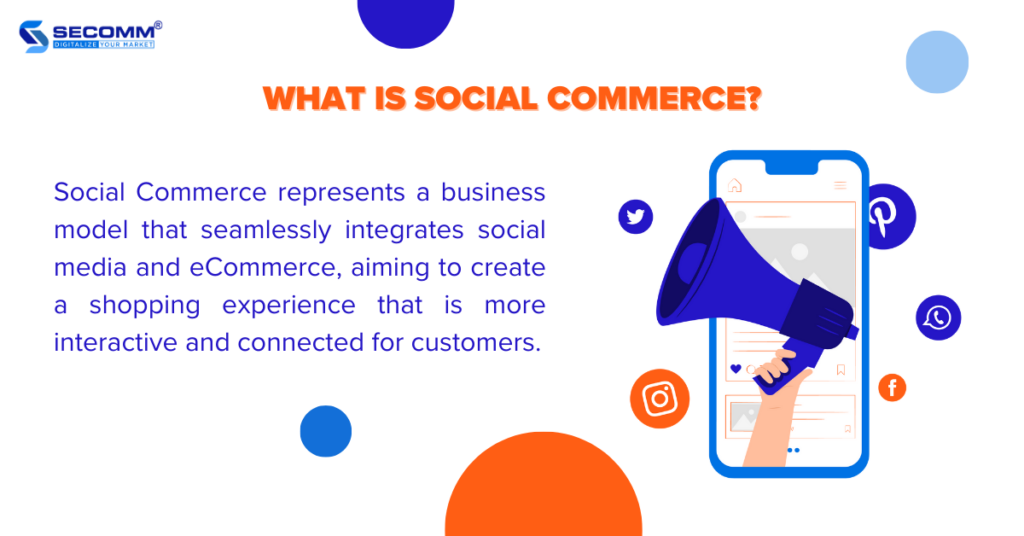
Social Commerce enables users to view and purchase products directly through social media platforms such as Facebook, Instagram, TikTok, etc.
This approach allows customers to delve into product details, read reviews, engage with comments from other users, and even make direct purchases through business posts, advertisements, or social platform storefronts.
The Social Commerce model often comes with interactive features, product-sharing capabilities, and personalized product recommendations.
Social Commerce takes advantage of the widespread popularity and extensive user base on social media platforms to naturally amplify the reach and influence of products and brands.
How does Social Commerce work?
Social Commerce vs eCommerce
Social Commerce and eCommerce are two distinct online business models, yet they share the common goal of online commerce. Here are the differences between these two models:
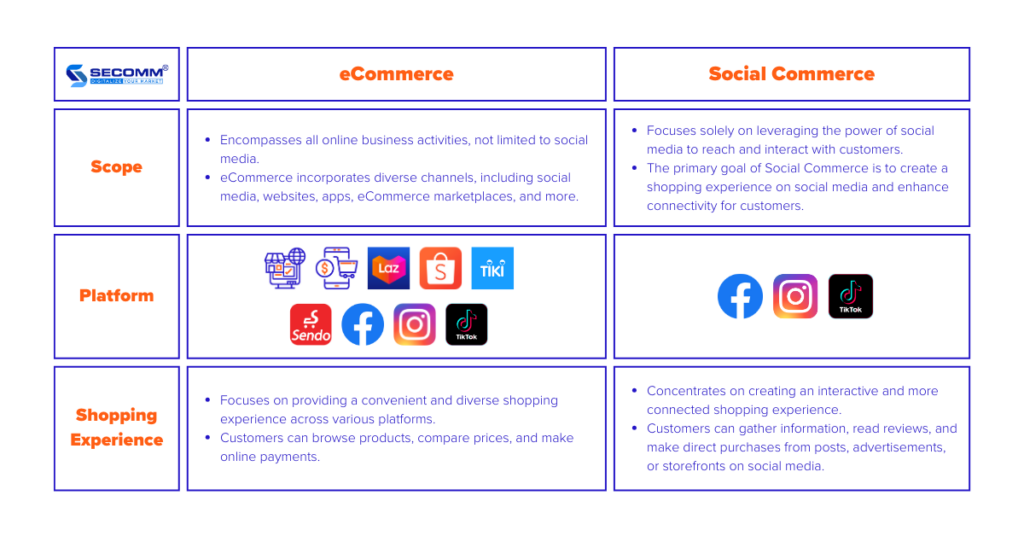
Types of Social Commerce
There are various popular types of social commerce, and the choice depends entirely on the scope and objectives of each business. Here are some common types of social commerce:
- Influencer Marketing: This marketing form leverages the influence of users with large social media followings. Businesses collaborate with celebrities or influential individuals to promote their products and brands.
- Affiliate Marketing: In this strategy, businesses empower influential individuals to promote or review their products/services in social media posts by embedding links, and incentivizing sales. In return, these affiliate partners earn a percentage of the revenue generated from those links.
- Social Media Advertising: This type of social commerce centers around using social media platforms as advertising spaces. Businesses can run ads on platforms like Facebook, Instagram, Pinterest, TikTok, etc., to reach their target audience.
- User-Generated Content (UGC): By encouraging customers to share their experiences using products or services on social media platforms, businesses aim to build trust among both current and potential buyers.
- Live Streaming: Hosting live streaming sessions on platforms like TikTok, YouTube, or Twitch allows viewers to interact directly with the business. This involves introducing products/services, fielding questions, and receiving user feedback during the broadcast, ultimately boosting online interaction and sales.
Benefits of Social Commerce
Enhance brand identity
Social Commerce facilitates businesses in reaching millions of users across various social media platforms, particularly globally popular ones like TikTok, Facebook, Instagram, and Pinterest.
This approach not only boosts brand awareness but also promotes businesses’ products and services to the extensive user base on these platforms, creating organic traction through user sharing and interaction.
The renowned sportswear brand Nike has successfully implemented Social Commerce by leveraging engaging posts, videos, and advertisements on social media platforms such as Facebook, Instagram, and Twitter.
The brand consistently runs advertising campaigns encouraging users to share their product experiences. Through user-generated posts and the strategic use of specific hashtags, Nike has sparked natural virality, resulting in an increased level of brand recognition.

Optimize the shopping experience
A key feature of social commerce is its focus on creating a seamless online shopping experience for users, simplifying the transition from product browsing to actual purchases. Customers can buy directly from posts, advertisements, or online stores on social media platforms.
This not only streamlines the shopping process but also enables businesses to optimize customer experiences, save time, and boost the eCommerce sales volume for the brands.
The cosmetics brand L’Oréal has created various TikTok channels for each target market in its beauty chain, such as lorealparis (global), lorealparisusa (U.S. market), lorealparis_vn (Vietnamese market), lorealparisid_shop (Indonesian market), lorealparisth_store (Thai market), and so on.
This approach not only allows the brand to reach the right target audience but also takes advantage of TikTok Shop, enabling customers to purchase products directly through L’Oréal’s TikTok channel.
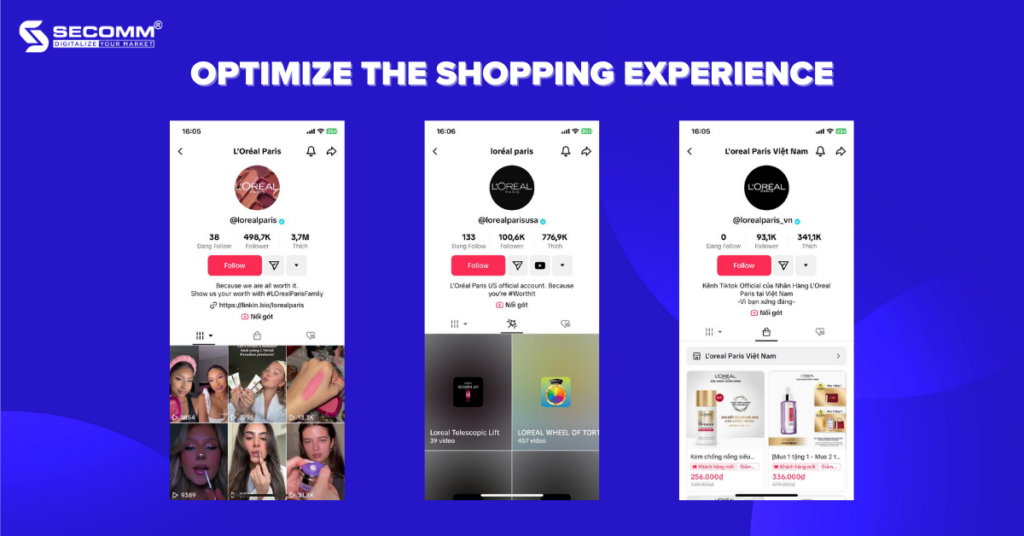
Monitor & measure performance
Presently, social media platforms offer comprehensive analytics and data measurement tools for businesses. For instance, Instagram Insights provides demographic information such as gender, age groups, and geographic locations.
Facebook Audience Insights goes a step further in collecting detailed data about a business’s target audience, while TikTok Pixel allows tracking vital metrics like clicks, views, and conversion rates, and assessing the effectiveness of advertising campaigns.
Leveraging these data sources assists businesses in creating more efficient social commerce campaigns compared to traditional retail operations. A noteworthy example of the successful implementation of Social Commerce with optimized tracking and measurement is Fashion Nova.
This prominent American fashion brand specializes in offering women’s clothing and accessories. Fashion Nova’s Instagram posts often incorporate sharing and user tracking features, enhancing the dissemination of information about products and the brand.
Furthermore, Fashion Nova utilizes Instagram’s measurement features and analytical tools to evaluate the effectiveness of the brand’s marketing and advertising campaigns.
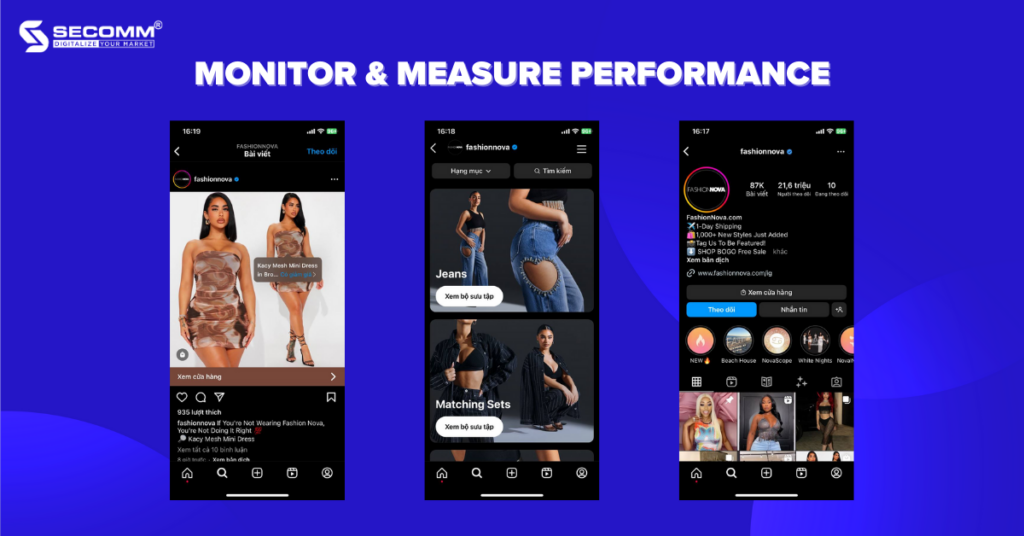
Boost engagement & customer service
Embracing social commerce enables businesses to seamlessly engage in direct interactions with customers and gather their feedback regarding the brand or product through posts, direct conversations, comment responses, and messages.
This facilitates quick customer support, addresses inquiries promptly, fosters satisfaction and fortifies customer relationships. Moreover, based on this valuable customer feedback, businesses can refine their products/services to align with customer expectations.
Tarte Cosmetics, a renowned cosmetics brand specializing in makeup and skincare products, has effectively utilized social media platforms such as Instagram, Facebook, and Twitter to implement social commerce. The brand consistently engages with customers across social media channels.
The administrative team promptly responds to user comments and messages, addressing inquiries and offering technical support. This approach builds trust and satisfaction among customers, actively strengthening positive customer relationships.
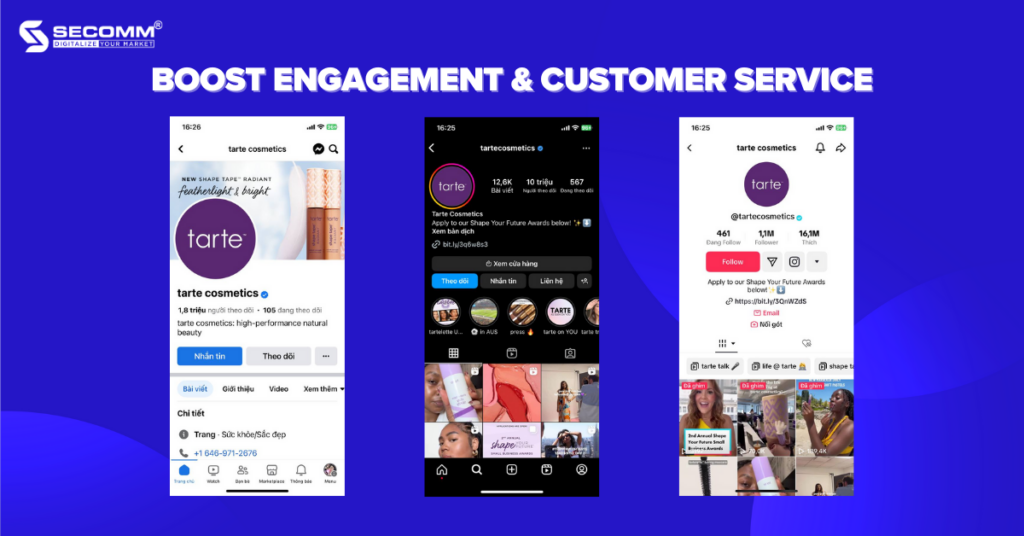
The Bottom Line
Here are insights, advantages, and examples of businesses effectively embracing Social Commerce. Depending on each business’s strategy, administrators can blend social media and eCommerce to engage customers and establish a brand in the current digital era.
Related Reading: eCommerce: Inbound Marketing vs Outbound Marketing
Contact SECOMM or directly call the hotline at 02871089908 today for complimentary guidance on implementing eCommerce Marketing overall and Social Commerce specifically.
 2
2

 6,058
6,058

 0
0

 1
1
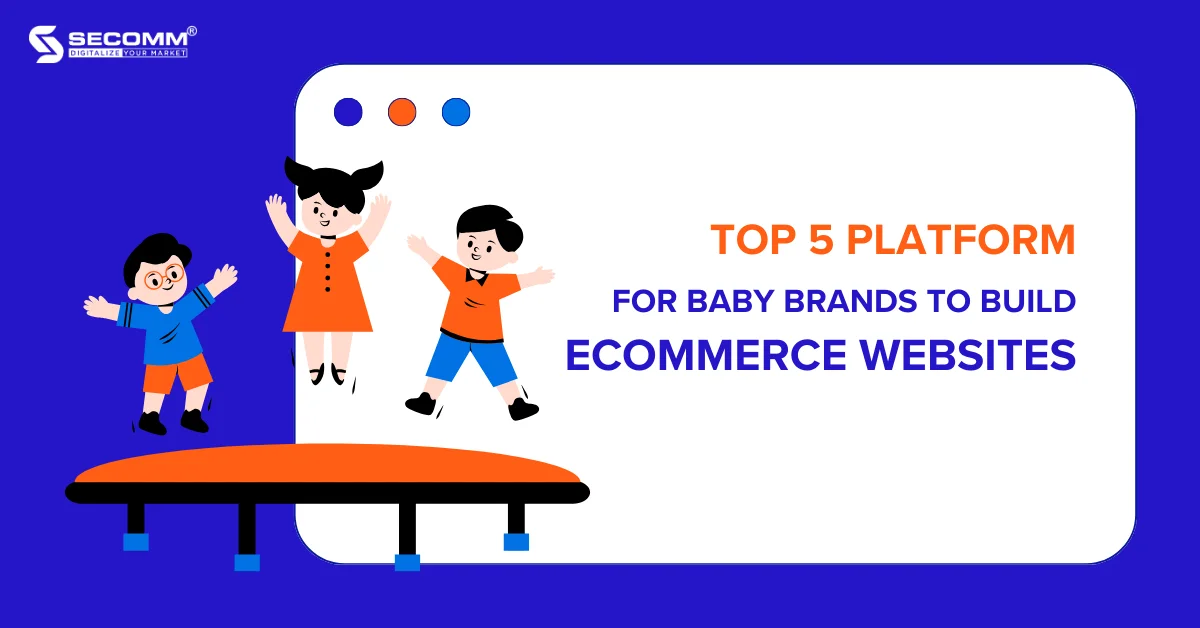
TOP 5 PLATFORMS FOR BABY BRANDS TO BUILD ECOMMERCE WEBSITES
The first step in the strategy for building and developing an eCommerce website, a crucial consideration for business owners in various sectors, is selecting an eCommerce platform that aligns with their business requirements.
The Baby eCommerce industry is no exception to this rule. So, what is the ideal choice? The following article outlines and clarifies the pros and cons of the top five eCommerce platforms for the development of Baby eCommerce websites.
Magento
Magento (now owned by Adobe), is an open-source eCommerce platform that grants businesses full authority to develop and manage their online store
For large enterprises in the Baby eCommerce industry with complex requirements for building and developing eCommerce websites, Magento’s high degree of customization and scalability, along with its wealth of outstanding features and extensions, can effectively cater to their needs. However, to fully leverage Magento’s capabilities, businesses should invest in both a specific budget and a requisite level of technical expertise.
Currently, Magento offers two primary versions:
- Magento Open Source: a free version
- Adobe Commerce: a paid version with two options, on-premise and on-cloud.
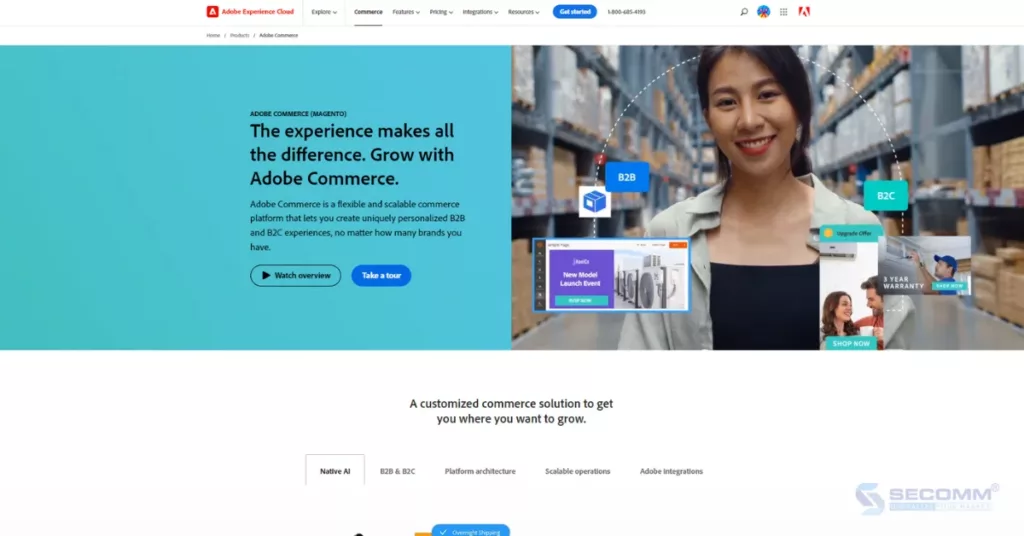
Key Features:
- Multi-brand solution: Supports multiple languages, currencies, and stores for various business models (B2B, B2C, B2B2C, D2C).
- MSI – Multi-source inventory: Enables the shipment of a single order with multiple products from different warehouses while ensuring delivery times.
- Headless eCommerce: Utilizes the separation between Frontend and Backend for easy customization and website development.
- B2B feature: Provides support for B2B customers, including category sharing, creating business accounts, quick ordering, and customer group creation.
- PWA – Progressive Web App: A mobile application built on web technology, easily discoverable and downloadable from a web browser.
Pros:
- Feature-rich system from basic to advanced, tailored to specific industry needs.
- High customization and scalability compared to SaaS platforms.
- No limits on sales volume.
- Wide range of extensions.
- High security.
Cons:
- High implementation costs.
- Lengthy implementation time, ranging from 6 months to 1 year.
- Requires a certain level of technical expertise and understanding of Magento.
Pricing:
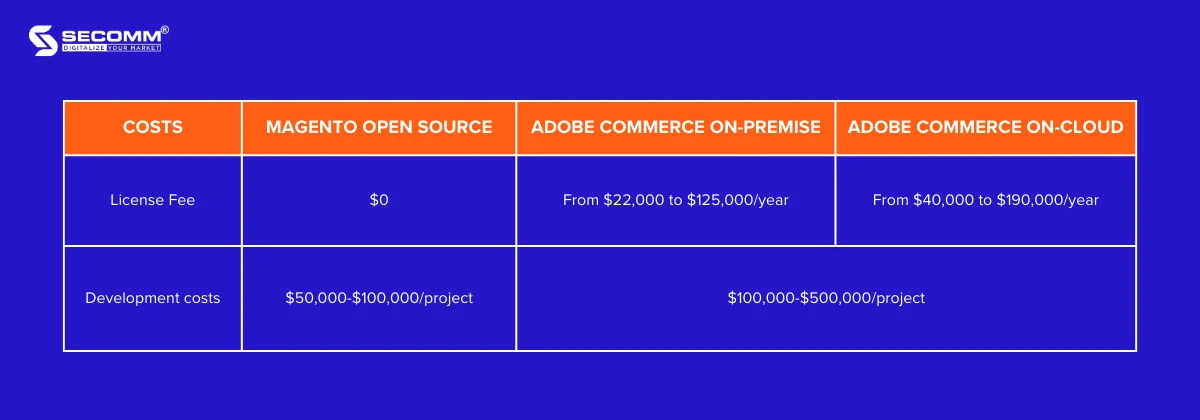
Brands built their Baby eCommerce websites on Magento including Kids Plaza VN, Bibo Mart, Children Salon, Mothercare VN, Aden+Anais, Hornby, v.v
Salesforce Commerce Cloud (SFCC)
Salesforce Commerce Cloud (SFCC) is a cloud-based Software as a Service (SaaS) solution that helps businesses build their eCommerce websites. This platform enables businesses to integrate all their sales channels, delivering a seamless shopping experience for customers.
SFCC offers two key solutions:
- Salesforce B2C Commerce Cloud: A solution for building websites and enhancing the overall shopping experience for retail customers.
- Salesforce B2B Commerce Cloud: A solution for building websites and providing a shopping experience for customers engaging in large-volume transactions.
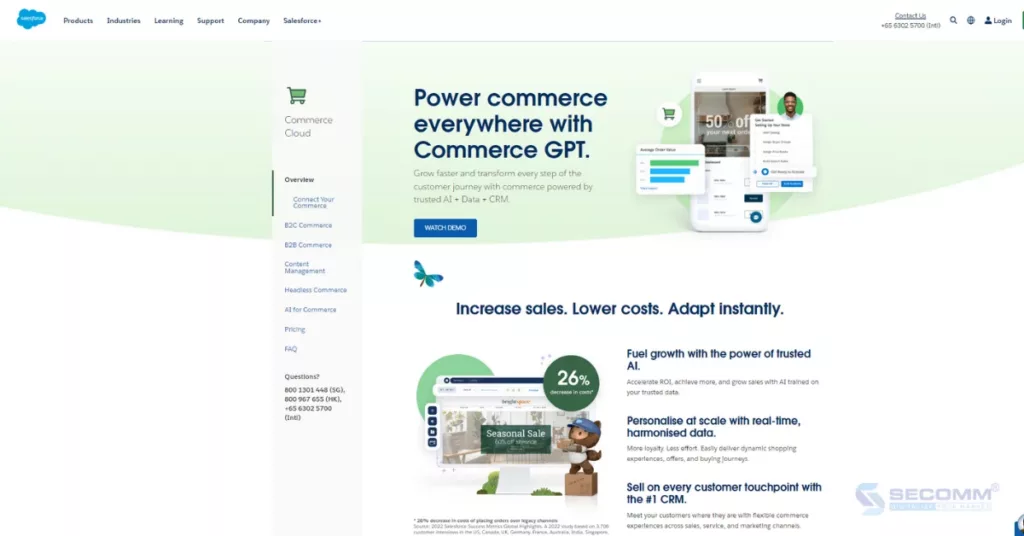
Key Features:
- AI Einstein: Offers personalized search and product recommendations with Einstein Product/Search Recommendations. Provides personalized experiences across all channels with Einstein Recommendations API. Gathers customer insights to boost revenue with Einstein Commerce Insights.
- Headless Commerce: Build headless e-commerce websites and enhance user experiences using SFCC’s Open Commerce API or any developer’s preferred APIs.
- Marketing & Merchandising: Supports design, scheduling, and automated marketing campaigns, optimize SEO to increase traffic, and manages multi-store, multi-language, and multi-currency capabilities from a centralized dashboard.
- Omnichannel: Enables multi-channel sales and provides a consistent customer experience.
- Localization: Allows businesses to create multiple separate websites with different languages, currencies, and strategies for specific target markets.
Pros:
- User-friendly interface.
- Strong support from AI tools during implementation.
- Diverse tools and features.
- Automation of order processing and promotional campaigns.
- Exceptional analytics and reporting capabilities to capture customer insights.
- High security.
- 24/7 customer support service.
Cons:
- The license fee is not publicly disclosed, making it challenging to estimate exact expenses.
- Limited seamless integration with third parties.
- Limited customization and scalability. For high customization needs, businesses may incur additional costs.
- Being a SaaS platform, it carries inherent risks from the provider, and data access limitations cannot be entirely avoided.
Pricing
For Salesforce B2C Commerce Cloud, businesses are offered three solution packages: Starter, Growth, and Plus, and they need to contact Salesforce for specific consultations and pricing.
For Salesforce B2B Commerce Cloud, businesses should get in touch with Salesforce for specific price levels and implementation details.
The cost of developing an eCommerce website using the SFCC platform can range from $2,000 to $500,000, depending on each business’s requirements.
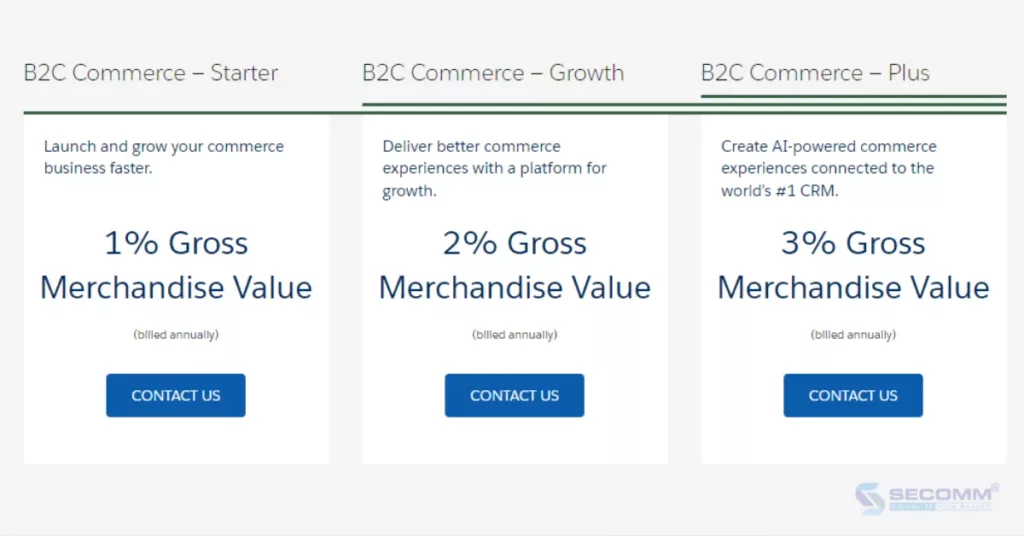
Some Baby brands that have developed eCommerce websites on the Salesforce Commerce Cloud platform include Carter’s, Hanna Andersson, OshKosh B’gosh, Chicco, Crayola, Toys “R” Us, Melissa & Doug, and more.
Shopify
Shopify is a SaaS platform known for its diverse features and themes that cater to businesses of various industries and scales, facilitating the rapid and effective development of eCommerce websites.
Shopify offers three standard solution packages (Basic, Shopify, Advanced), tailored for small and medium-sized businesses. Meanwhile, the Shopify Plus solution is aimed at medium to large businesses with elevated development and customization requirements.
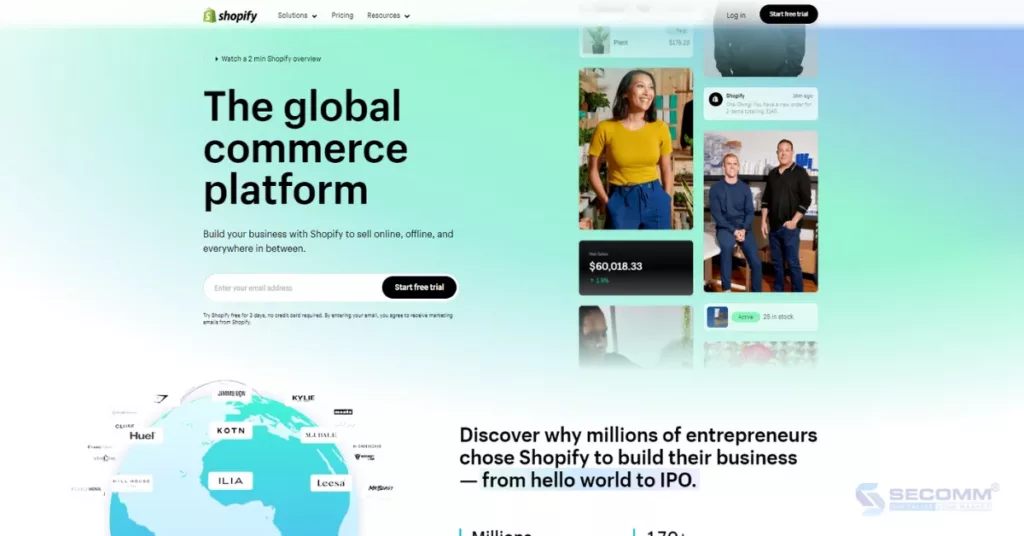
Key Features:
- Shopify POS: This feature is available in all solution packages and allows seamless integration of point-of-sale from online to offline, supporting order and inventory management across retail locations, online stores, and other active sales channels.
- eCommerce automation: Automates marketing processes and order execution. Available in the Shopify and Advanced packages, while Shopify Plus businesses have Shopify Flow and LaunchPad.
- Shopify Hydrogen: Allows Shopify Plus and standard Shopify businesses to build custom storefronts using the React-based Hydrogen framework, which can then be directly integrated with the Oxygen in-house hosting. This is Shopify’s new solution for businesses building and developing Headless websites.
- Abandoned cart recovery: Automatically sends email with discount codes to customers in cases of cart abandonment during the checkout process, leaving the website with products in the cart but unpaid, or viewing products without adding them to the cart.
- International commerce: Supports multiple languages, multiple stores, and multiple currencies. However, tax calculation at checkout is only available for the Advanced and Shopify Plus packages.
Pros:
- User-friendly interface.
- Reasonable initial costs.
- Diverse integrated apps and themes.
- 24/7 customer support service.
- Support both online and offline sales.
- High security.
- Ideal platform for opening dropshipping stores. Some Baby dropship stores using Shopify include Posh Peanut, Baby Boxco, Happiest Baby, and more.
Cons:
- Costs increase over time.
- Limited customization and scalability when compared to open-source platforms.
- Limited blogging features and content management capabilities.
- Restrictions on free themes.
- Risks associated with the provider and data access limitations.
Pricing
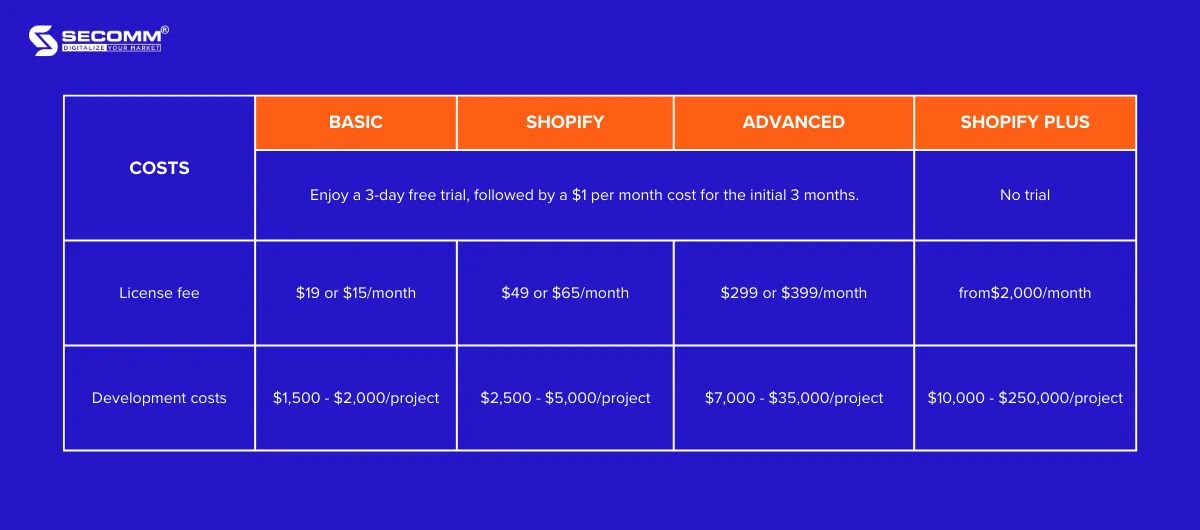
Shopify serves as the choice not only for Baby dropshipping stores but also for numerous well-known Baby brands that have used this platform to build their online store, including HATCH Collection, Motherhood Maternity, 4moms, Maclaren, Manhattan Toy, Tegu, and many others.
BigCommerce
BigCommerce is another platform worth considering for Baby eCommerce businesses due to its ease of use and its ability to cater to the eCommerce website-building requirements of businesses across various scales and industries.
Furthermore, BigCommerce is recognized as a SaaS platform that includes a wide array of features within its solution packages (Standard, Plus, Pro, Enterprise) aimed at fostering eCommerce growth.
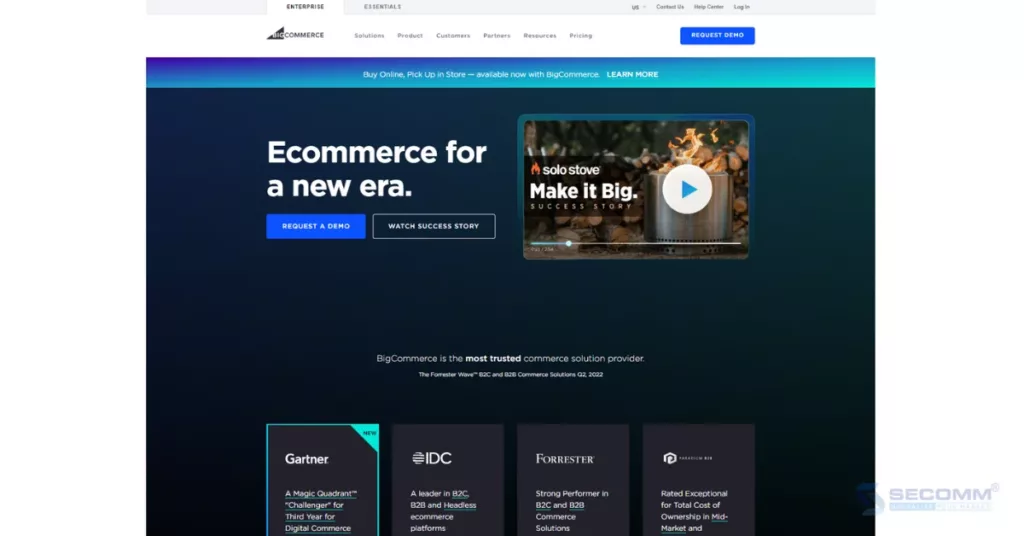
Key Features:
- Built-in blog: Enhances SEO rankings and provides an engaging content experience through a blog.
- Professional reporting tool: Offers professional analytics and reporting tools that help businesses evaluate operational performance for informed adjustments.
- Real-time shipping quotes: Provides real-time, accurate shipping cost estimates from various carriers.
- Google customer reviews: Allows businesses to collect and display customer reviews on Google from those who have purchased their products.
- BigCommerce mobile app: Monitor performance, track and update orders, and manage customer journeys with the BigCommerce mobile app. The app is available for direct download from the App Store or Google Play.
Pros:
- User-friendly interface.
- Richly integrated features.
- Diverse solution packages with reasonable usage costs.
- Offers 65 popular worldwide payment solutions with integrated transactions fee-free.
- A variety of themes and extensions tailored for the Baby industry.
- High security.
Cons:
- Sales volume limits.
- Increasing implementation costs over time.
- Limited customization capabilities.
- Provider risks and data access limitations.
Pricing

Brands built their eCommerce websites with BigCommerce: Le Petit Kids, Scentos, Nature’s One, Kids Furniture Warehouse, See Kai Run, Feltman Brothers, v.v
Shift4Shop
Shift4Shop is a SaaS eCommerce platform that equips businesses with the essential tools and features to build and customize eCommerce websites. It presents a range of free and premium themes suitable for marketing Maternity and baby products.
Shift4Shop provides three paid plans (Basic, Plus, Pro) and one free plan, subject to a minimum monthly revenue of $500, designed for U.S. sellers under the End-to-End category.
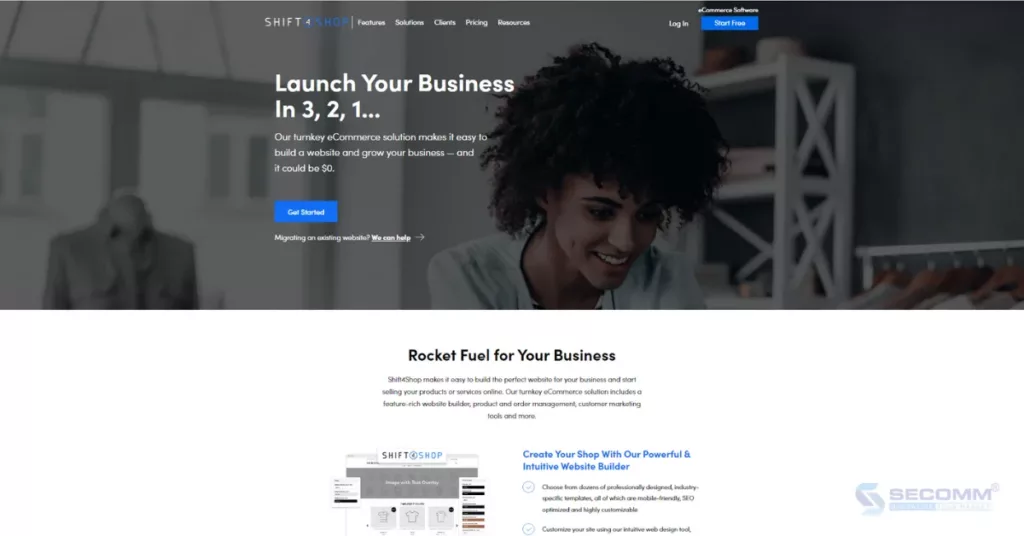
Key Features:
- Built-in tools: Integrated tools for blogging, SEO optimization, social media integration, etc., aid businesses in enhancing the effectiveness of their marketing strategies.
- RMA system: This feature simplifies the product return and refund process.
- Shopping cart: Allows customers to quickly view and customize their shopping carts. Customers can also choose one-page or three-page checkout options.
Pros:
- User-friendly interface
- Various integrated features
- Reasonable initial cost
- No transaction fees
- 24/7 technical support service
Cons:
- Limited customization and expansion capabilities
- Increasing deployment costs over time, even for the End-to-End package
- Volume limits for paid plans
- Limited and basic selection of free themes
- Vendor risks and data access concerns
Pricing
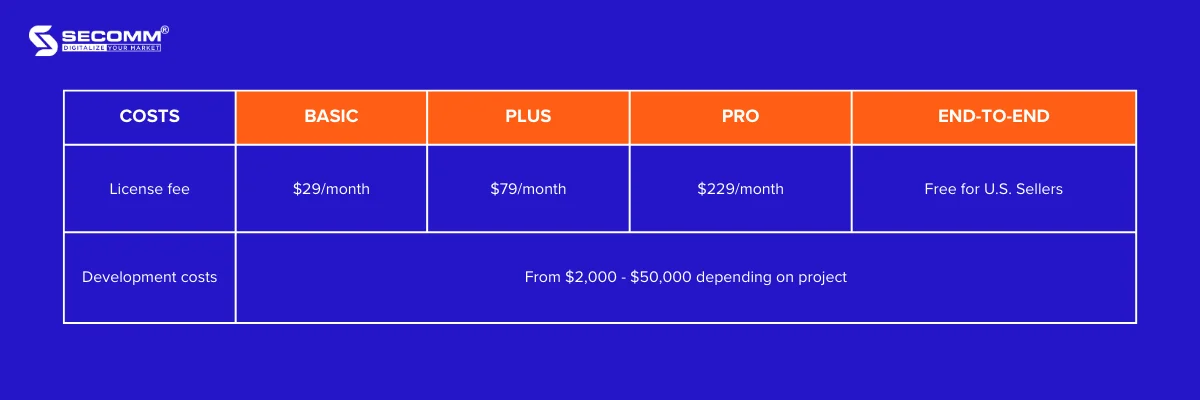
Brands built their Baby website with Shift4Shop: eLeMeNO-Pee, Sugar Babies, Nicki’s Diapers, Enfant Style, Ideal Baby & Kids, v.v
The above are the top 5 platforms that have been preferred by the majority of Baby businesses for establishing their eCommerce websites.
After years of eCommerce implementation across various countries, SECOMM has accumulated invaluable insights to expedite the process of website development and growth for Baby businesses.
Get in touch or directly call SECOMM‘s hotline at (02871089908) for immediate guidance on platform selection and eCommerce implementation today
 2
2

 9,375
9,375

 0
0

 1
1
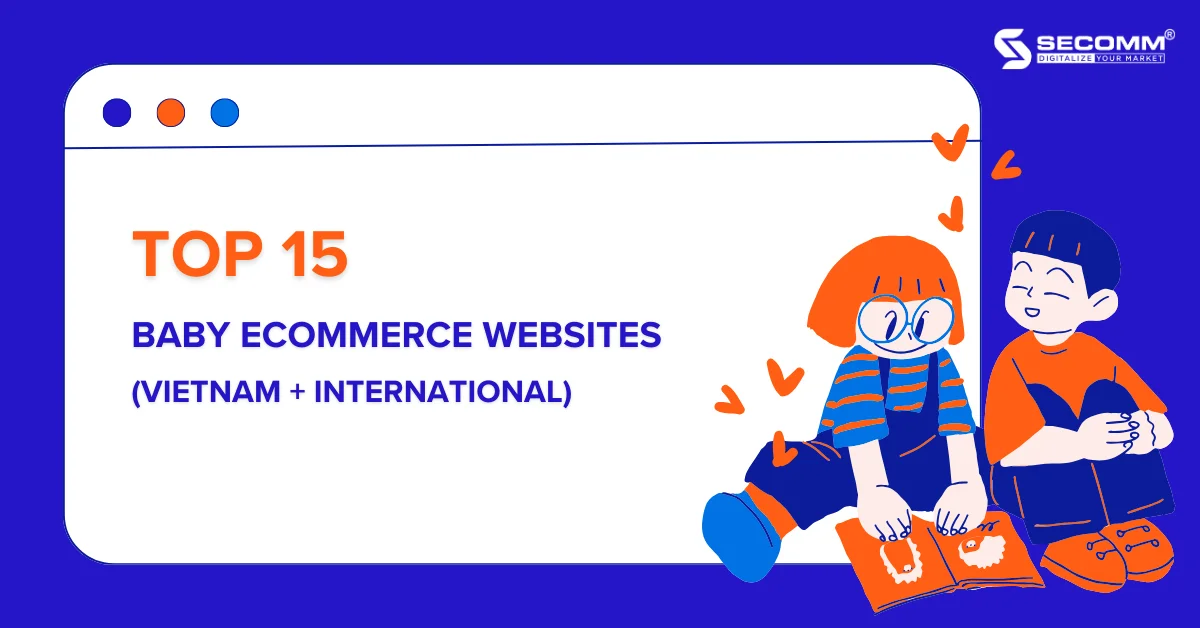
TOP 15 BABY ECOMMERCE WEBSITE (VIETNAM + INTERNATIONAL)
The global business landscape has faced significant challenges due to the Covid-19 pandemic. In response to this, many businesses across various sectors, particularly in the Baby industry, have prioritized the implementation of eCommerce strategies to connect with online customers and drive sales. Furthermore, to align with the broader economic trends, these retailers have transitioned from traditional business models to robust eCommerce operations to ensure growth and market expansion.
The following list showcases 15 successful Baby brands in Vietnam and around the world that have effectively adopted eCommerce websites, thus facilitating the swift participation of numerous other businesses.
Ava Kids
Ava Kids is the Baby eCommerce website of The Gioi Di Dong Corporation, offering a range of enticing online shopping benefits to customers. These include a 1-month return policy, complimentary shipping, special discounts for new customers, a rewards program, and informative guides for maternal and child health care.
Having been in operation for over a year, Ava Kids’ eCommerce website now enjoys over 2.1 million monthly visitors and has expanded its offline store network from 5 to 66 outlets.
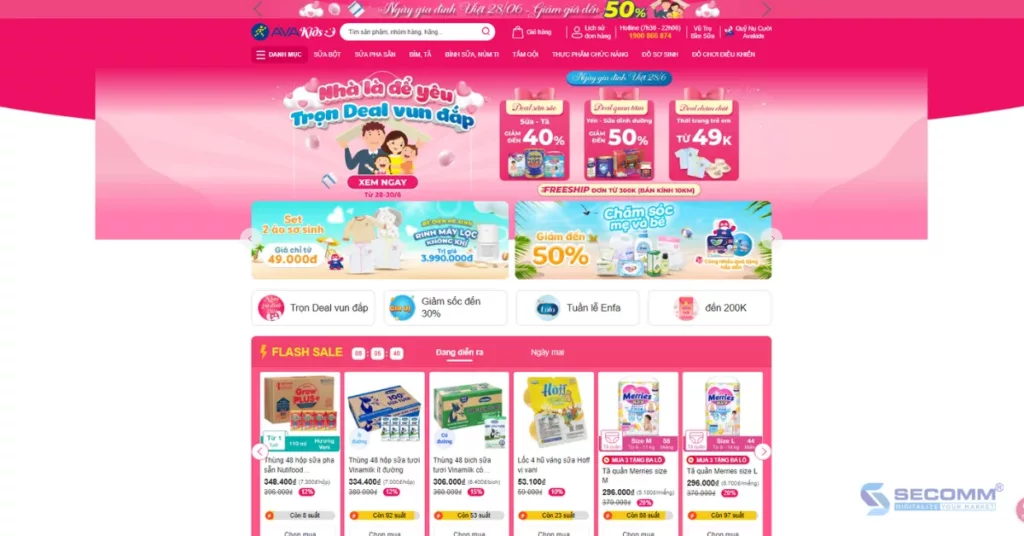
- Website: https://www.avakids.com/
- Platform: PHP language
- Traffic: 2.1M/month
- Ranking: 560 (Vietnam) & 30,546 (Worldwide)
Con Cưng
Established in 2011, Con Cung has grown to become Vietnam’s leading retail chain specializing in products for expectant mothers and babies, boasting over 700 stores across the country.
In recent years, Con Cung has made significant strides in developing its eCommerce website, catering to the online shopping demands of its customers. This expansion has enabled them to provide a rich shopping experience with a wide range of enticing offers, flexible payment methods, and 1-hour delivery services.
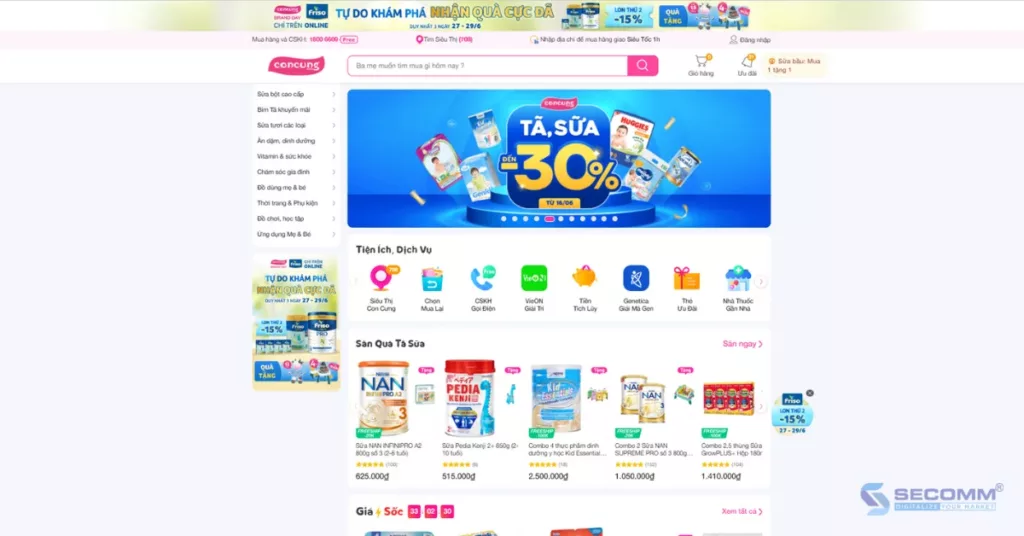
- Website: https://concung.com/
- Platform: PHP language
- Traffic: 1.3M/month
- Ranking: 891 (Vietnam) & 48,776 (Worldwide)
Kids Plaza
Founded in 2009, Kids Plaza is a major player in the eCommerce competition for the Baby industry. Kids Plaza has built an eCommerce website on the Magento platform to efficiently manage a vast and diverse product catalog. The brand consistently runs enticing promotional campaigns, offering gift-with-purchase deals, flash sales, buy-5-get-1-free offers, and a loyalty points system for redeemable rewards. These efforts have significantly driven up website traffic during promotional events, making Magento’s customization and scalability features indispensable for handling sudden surges in visitor numbers. On average, the website garners approximately 1 million visits per month.
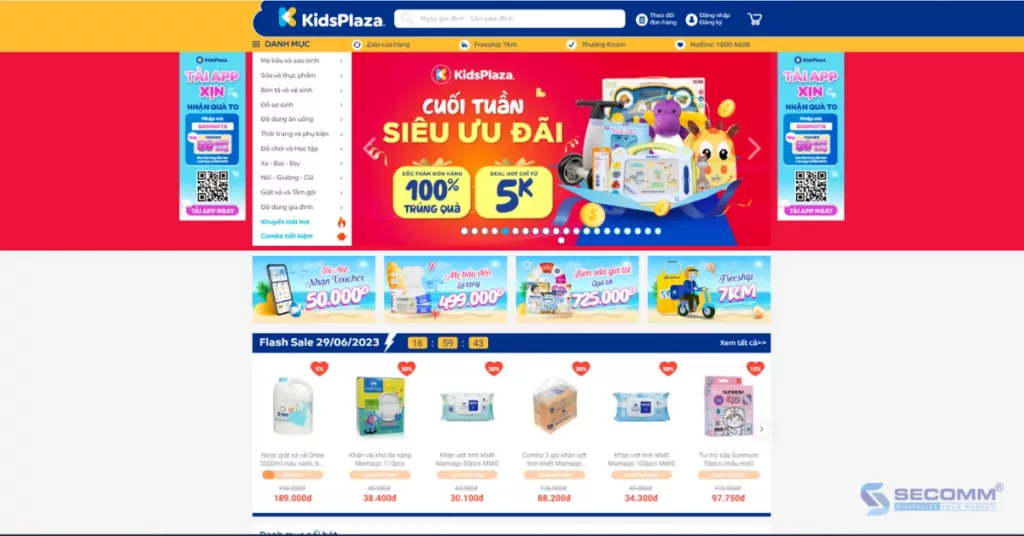
- Website: https://www.kidsplaza.vn/
- Platform: Magento
- Traffic: 1M/month
- Ranking: 1,316 (Vietnam) & 67,544 (Worldwide)
Bibo Mart
Founded in 2006, Bibo Mart, a retail chain dedicated to serving expectant mothers and babies, offers a diverse range of products, including maternity clothing, diapers, formula, and strollers. Just like its competitors, Bibo Mart is a strong contender in the eCommerce race.
To enhance the customer shopping experience, Bibo Mart opted for Magento Enterprise Edition (aka Adobe Commerce) to develop a custom eCommerce website. This platform enables the implementation of attractive promotions and a Loyalty Program. Presently, the website enjoys more than 500,000 monthly visitors.
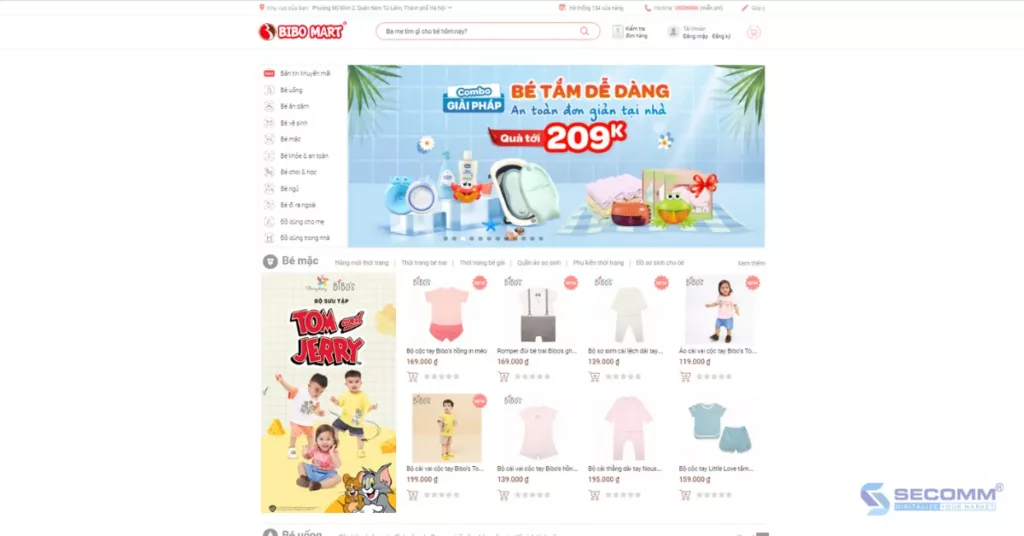
- Website: https://bibomart.com.vn/
- Platform: Magento Enterprise Edition (Adobe Commerce)
- Traffic: 518K/month
- Ranking: 2,216 (Vietnam) & 109,496 (Worldwide)
Shop Trẻ Thơ
Shop Trẻ Thơ stands as a well-known brand in the Maternity & Baby sector. The company is dedicated to establishing and advancing its eCommerce website alongside its network of 22 physical stores. This strategic move is aimed at staying in sync with the online shopping trend and securing a competitive edge in the realm of eCommerce.
Beyond a diverse product catalog, Shop Trẻ Thơ offers various enticing incentives to encourage online shopping, such as Buy 1 Get 1, cost-saving combos, gifts with purchase, discounts for new customers, and more. Currently, the website maintains a stable traffic of over 100,000 visitors per month.
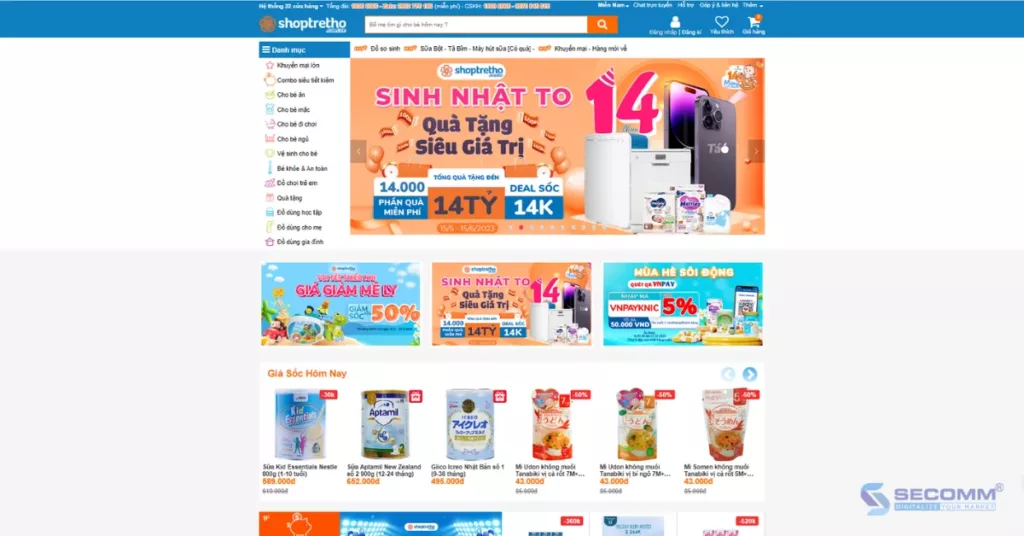
- Website: https://shoptretho.com.vn/
- Platform: PHP language
- Traffic: 133K/month
- Ranking: 9,242 (Vietnam) & 431,259 (Worldwide)
Tuticare
Tuticare is considered a prominent brand in the Maternity & Baby industry with a chain of 55 stores across Vietnam. Tuticare’s products undergo stringent checks, from their origins to their quality, providing a sense of assurance to mothers during their shopping experience.
The company has started an eCommerce website to provide customers with an optimized online shopping experience, along with various attractive programs and offers like a Tuti Gift Card, a subscription for diapers and milk, and more. Additionally, Tuticare offers diverse payment options, including eWallets and buy now pay later.
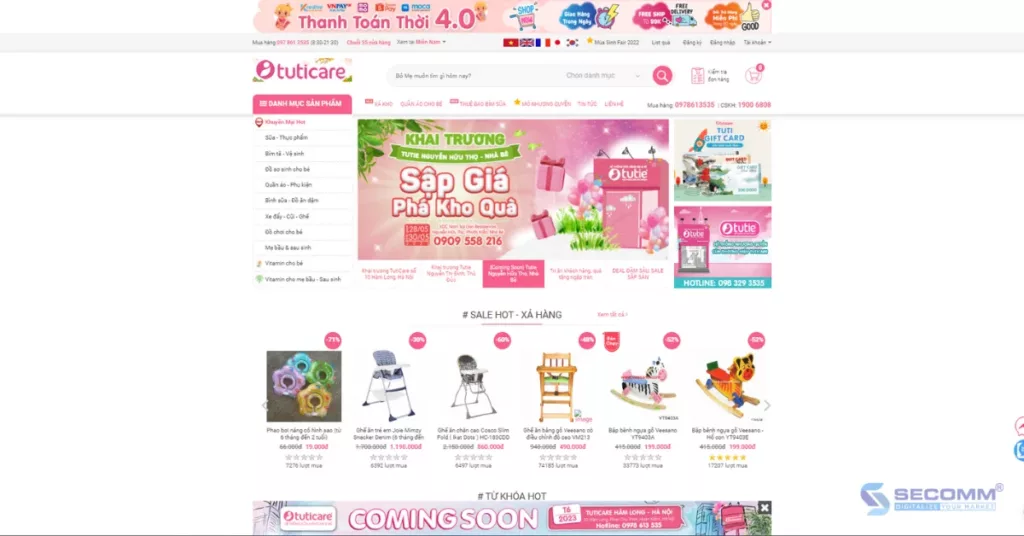
- Website: https://www.tuticare.com/
- Platform: PHP language
- Traffic: 113.7K/month
- Ranking: 9,304 (Vietnam) & 435,124 (Worldwide)
Mothercare
Mothercare, a brand focused on Baby products from the United Kingdom, offers a diverse range of fashion and essential items for expectant mothers and children of various age groups. Despite its recent inception, Mothercare has rapidly garnered attention, primarily due to its commitment to providing high-quality products at affordable prices.
The Mothercare website is strategically developed using the Magento platform, effectively catering to the online shopping preferences of their customers. Beyond attractive promotional programs, the Mothercare website also provides valuable insights on caring for newborns and young children through its dedicated blog section.
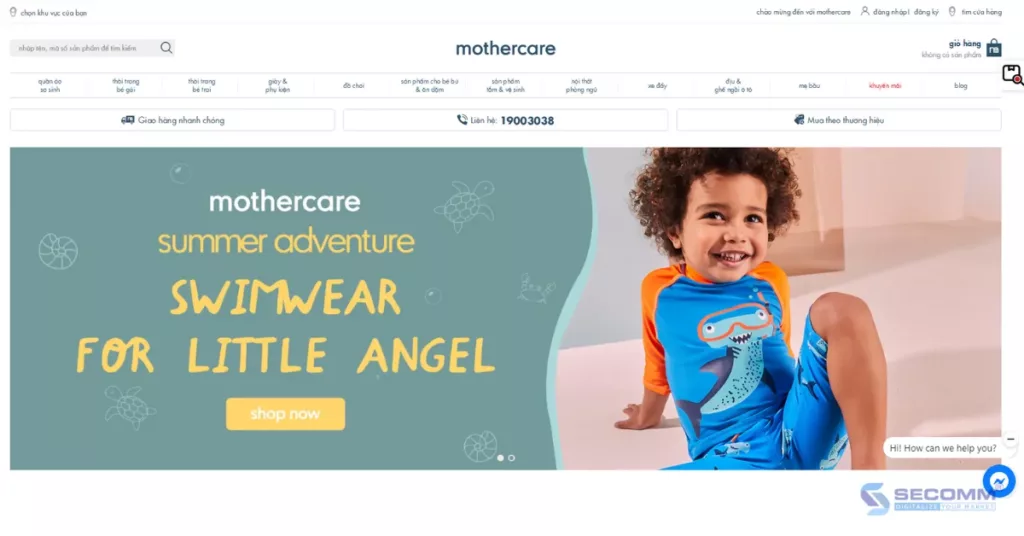
- Website: https://www.mothercare.com.vn/
- Platform: Magento
- Traffic: 28.8K/month
- Ranking: 14,558 (Vietnam) & 669,019 (Worldwide)
Soc & Brothers
Soc & Brothers is a rising name in the Baby eCommerce market, offering a diverse range of products for expectant mothers and children, including clothing, formula, diapers, strollers, and toys. The company has built an eCommerce website using Haravan and receives approximately 28,000 monthly visitors. Moreover, Soc & Brothers has implemented a Loyalty Program with three tiers: Silver, Gold, and Diamond, which can be utilized for purchases and point accumulation both at their offline retail stores and various online channels.
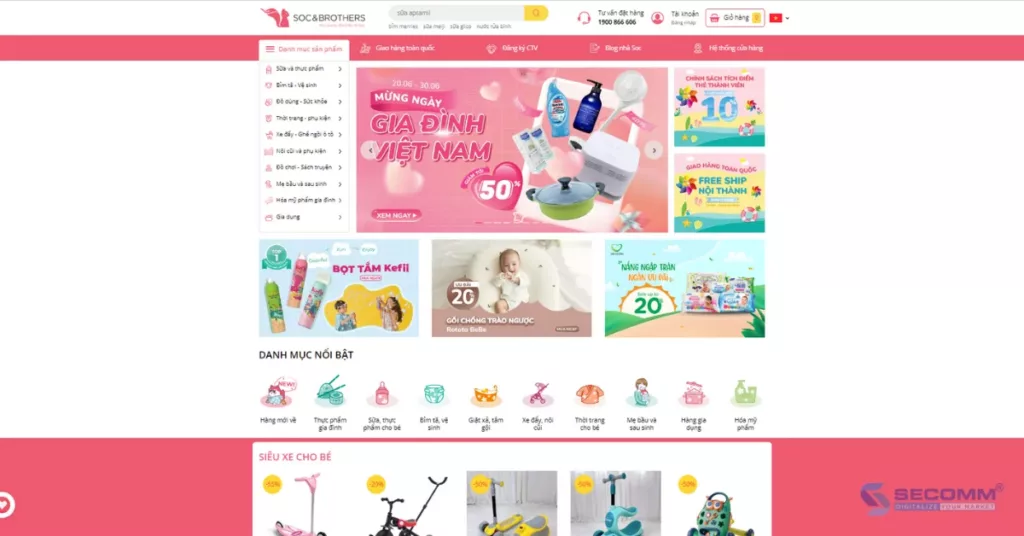
- Website: https://www.snbshop.vn/
- Platform: Haravan
- Traffic: 28.1K/month
- Ranking: 46,426 (Vietnam) & 1,950,408 (Worldwide)
Carter’s
Carter’s is a well-known children’s clothing brand in the North American region. Carter’s offers a wide range of products suitable for children of all ages, heights, and weights. Their website is built on Salesforce Commerce Cloud and features a primary color scheme of blue and white, emphasizing minimalism and cuteness. Currently, the website receives about 8.4 million monthly visits. Moreover, customers can purchase physical or eGift cards through the website, which can be customized in terms of design, value, and personal messages.
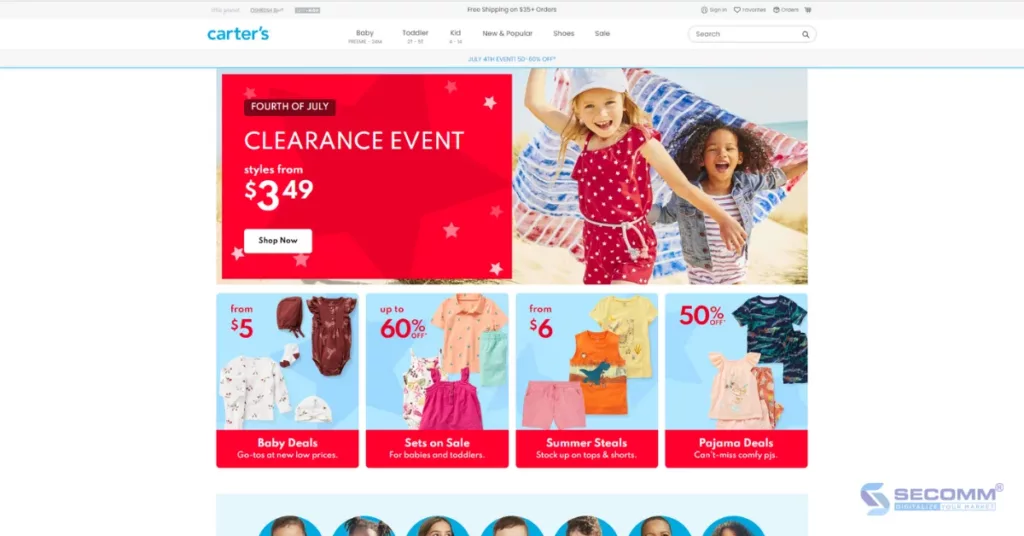
- Website: https://www.carters.com/
- Platform: Salesforce Commerce Cloud
- Traffic: 8.4M/month
- Ranking: 1,127 (USA) & 5,584 (Worldwide)
Hanna Andersson
Hanna Andersson is a well-known Swedish brand that specializes in children’s clothing, offering beautiful designs and a wide range of styles, sizes, and types of clothing, from everyday wear to sleepwear and swimwear. Hanna Andersson’s eCommerce website is built and developed using the Salesforce Commerce Cloud platform and garners more than 1.4 million monthly visitors. Hanna provides a personalized shopping experience by inviting its customers to participate in clothing selection consultations, parenting advice, and direct communication for new customers.
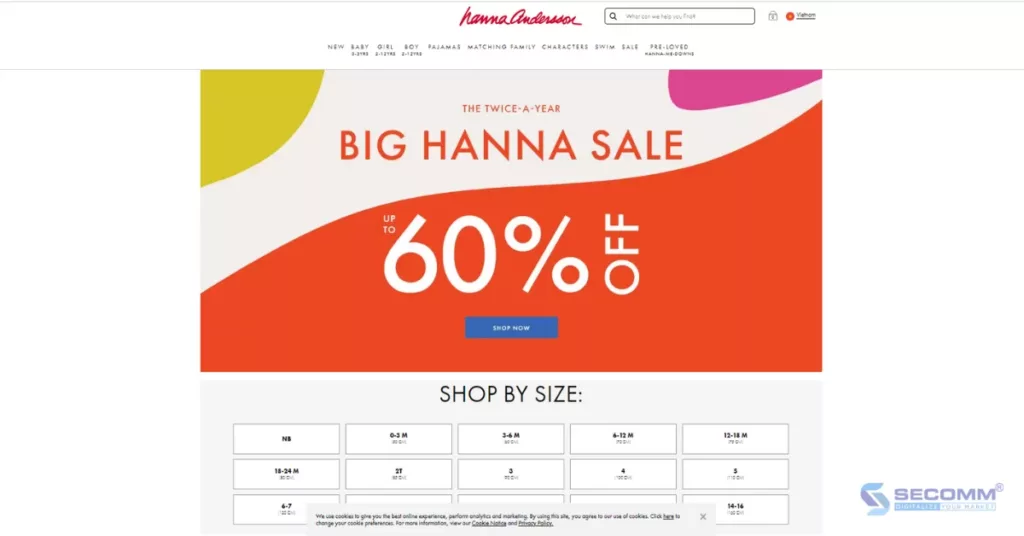
- Website: https://www.hannaandersson.com/
- Platform: Salesforce Commerce Cloud
- Traffic: 1.4M/month
- Ranking: 5,908 (USA) & 32,358 (Worldwide)
OshKosh B’gosh
OshKosh, a globally beloved children’s clothing brand, has achieved significant success by utilizing Salesforce Commerce Cloud to create an eCommerce website that delivers an exceptional online shopping experience. Presently, the website receives more than 900,000 monthly visitors and provides numerous appealing shopping incentives to its customers, including a rewards program that offers unexpected gifts, birthday presents, and discount vouchers.
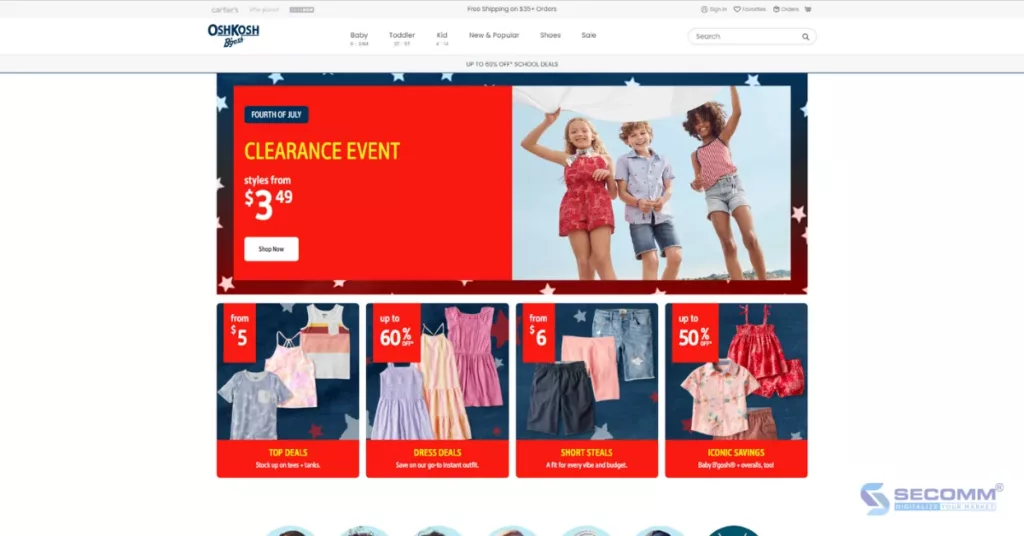
- Website: https://www.oshkosh.com/
- Platform: Salesforce Commerce Cloud
- Traffic: 919.4K/month
- Ranking: 11,805 (USA) & 56,197 (Worldwide)
Janie and Jack
Janie and Jack, another children’s fashion brand, has built an eCommerce website using the Salesforce Commerce Cloud platform. The company provides a wide variety of products for boys, girls, infants, as well as items such as jewelry and home decor. Notably, Janie and Jack has entered into a collaboration with Disney to offer fashion items featuring beloved Disney characters for children.
Additionally, the brand offers a gift-wrapping service that allows customers to select their preferred products, gift boxes, wrapping paper, and greeting cards. Customers can choose to wrap gifts themselves or take advantage of Janie and Jack’s professional gift-wrapping service.

- Website: https://www.janieandjack.com/home?lang=en
- Platform: Salesforce Commerce Cloud
- Traffic: 764.8K/month
- Ranking: 9,339 (USA) & 51,103 (Worldwide)
Children Salon
Children Salon, established in 1952, is one of the leading brands in high-end fashion for children. They offer many products, including clothing, shoes, and hats for boys, girls, and teenagers. The company specializes in designing and producing children’s fashion collections for top global brands such as Versace, Givenchy, Burberry, Dolce & Gabbana, Calvin Klein, and more. Additionally, customers who purchase these designer products on the Children Salon website can enjoy discounts of up to 60%.
Children Salon’s eCommerce website is built on the Magento platform, featuring advanced functions like filtering products by size and age, displaying available sizes, and currency conversion for product prices, among others. The website currently receives over 600,000 monthly visits.

- Website: https://www.childrensalon.com/
- Platform: Magento
- Traffic: 647.5K/month
- Ranking: 56,386 (USA) & 90,938 (Worldwide)
Motherhood Maternity
Motherhood Maternity’s eCommerce website is a well-known and trusted fashion shopping destination for expectant mothers. The website, built on the Shopify platform, garners around 400,000 monthly visits.
Beyond its wide array of clothing and supportive accessories, Motherhood offers an “Expert Guide” section dedicated to sharing valuable knowledge about prenatal healthcare. Furthermore, the “Preggie Perks” program allows customers who shop on the website to have the chance to receive discount vouchers or unique gifts, conveniently delivered with their products to their doorstep.

- Website: https://www.motherhood.com/
- Platform: Shopify
- Traffic: 426.8K/month
- Ranking: 17,468 (USA) & 98,316 (Worldwide)
HATCH Collection
HATCH Collection, a renowned global brand, specializes in offering fashion and beauty products for expectant mothers. Despite its establishment in 2011, the brand has chosen to maintain only two physical stores in California and New York, as HATCH’s primary focus lies in online retail.
Operating through its eCommerce website, HATCH has introduced several programs for their customers. One notable initiative is “NIKKI’s List,” wherein customers respond to specific questions, enabling HATCH to generate personalized product recommendations. The HATCH website is constructed and managed using the Shopify platform and receives approximately 223,000 monthly visits.
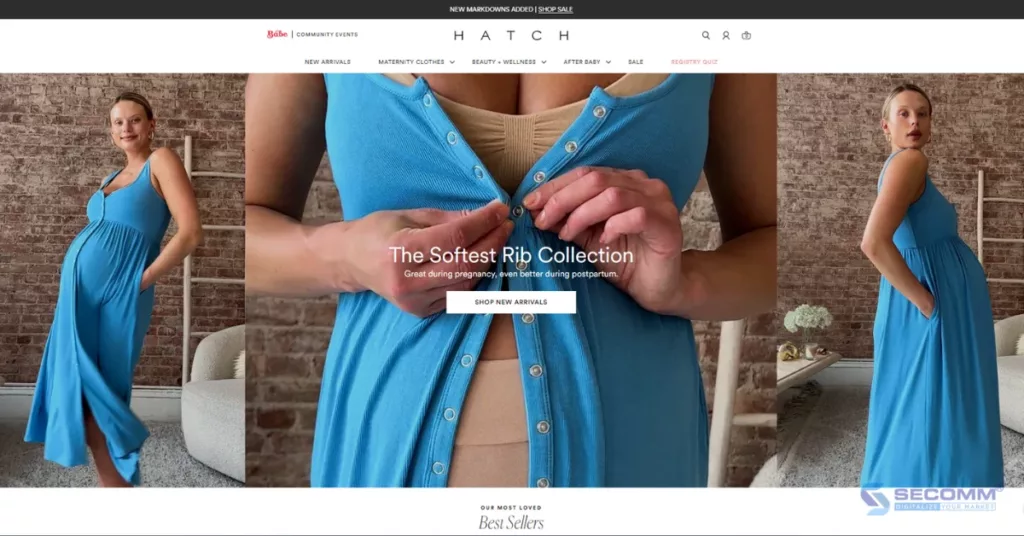
- Website: https://www.hatchcollection.com/
- Platform: Shopify
- Traffic: 223.7K/month
- Ranking: 40,787 (USA) & 204,740 (Worldwide)
The surge of the Covid-19 pandemic has made a significant impact on consumer shopping habits, particularly in the Baby sector, where a profound shift from offline to online shopping has been witnessed.
Presented here are 15 eCommerce websites, showcasing leading brands in the Mother & Baby industry, both in Vietnam and internationally. These brands exemplify their adaptability in capturing consumer trends and their commitment to enhancing technological infrastructure to compete for a share in the billion-dollar market.
With a track record of successfully implementing eCommerce solutions for a diverse clientele across various countries in recent years, SECOMM specializes in offering expert consultation and tailored eCommerce deployment solutions, tailored to the specific requirements of each industry.
For a free consultation, contact us or call directly to the SECOMM hotline at (02871089908).
 2
2

 10,145
10,145

 0
0

 1
1
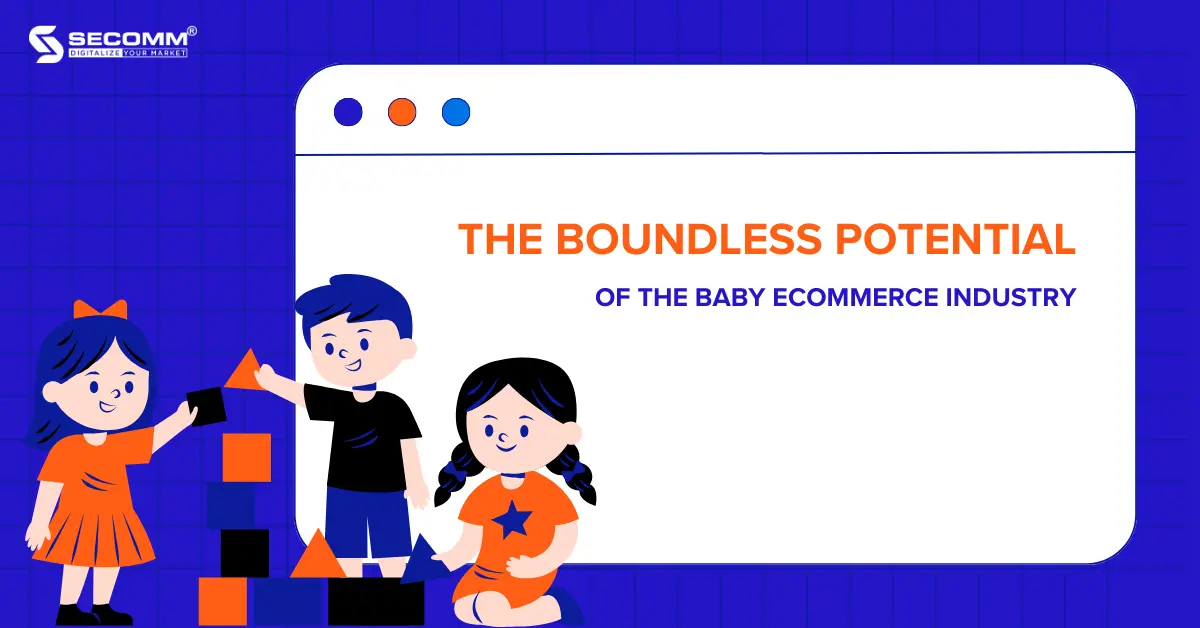
THE BOUNDLESS POTENTIAL OF THE BABY ECOMMERCE INDUSTRY
Recent statistics indicate that Vietnam has a population of 24.7 million children and roughly 24.2 million women of childbearing age. Moreover, with an annual birth rate of approximately 1.5 million children, Vietnam stands out as a prospective market for the baby industry. As a result, it comes as no surprise that many baby brands have been progressively establishing and expanding their stores year by year. Additionally, the industry benefits from the momentum created by the pandemic and the evolving trend of transitioning from offline to online shopping.
3 reasons for baby brands to get on board with eCommerce
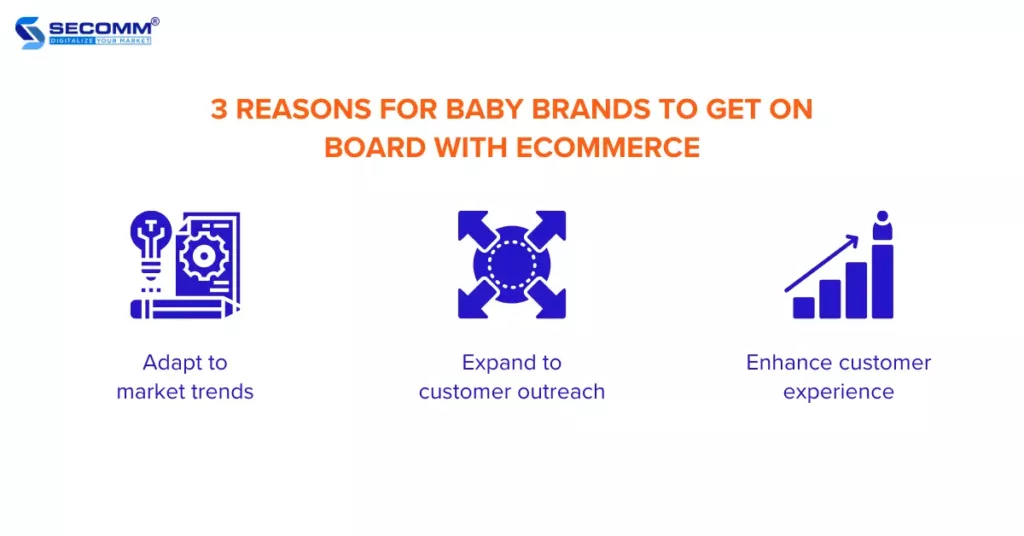
Adapt to market trends
While offline businesses experienced a downturn during the period of social distancing, leading to the contraction of many retail chains, online commerce has been flourishing. Even as society progresses towards a “reopening” phase in the post-pandemic world, the preference for online shopping remains strong. The demand for various products, spanning from timepieces, cosmetics, and groceries, to mom-and-baby essentials, on eCommerce websites and marketplaces continues to steadily surge.
Hence, the solution for Baby enterprises to align with market trends involves the implementation of an O2O (Online to Offline) model. This approach integrates offline sales (leveraging existing physical store networks) with online channels. Among these channels, establishing an eCommerce website is paramount for businesses to promptly deploy sales and marketing strategies, attracting customers and preventing potential loss to competitors.
Expand to customer outreach
When physical stores are constrained by location, staffing, and operating hours, online stores remain open and accessible from anywhere worldwide. This offers Baby businesses the opportunity to extend their reach to a large pool of potential customers on the Internet.
By implementing effective strategies like optimizing SEO, running advertising campaigns, or leveraging social media, Baby businesses can swiftly boost their brand recognition, attract a diverse clientele to their eCommerce website, and facilitate round-the-clock product sales.
Top Vietnamese Baby eCommerce sites
Con Cung
Launched in 2011, the Con Cung retail chain quickly gained recognition and became the top choice for many Vietnamese families to shop for mom-and-baby products, offering a catalog of over 2000 items. In 2016, with the investments received, Con Cung significantly expanded its store chain from 100 in 2016 to 400 in 2020 (currently at 700 stores).
Recognizing the evolving consumer landscape with a shift from offline to online shopping, the brand proactively intensified its online retail efforts through its eCommerce website and mobile app, enriching the shopping experience for its customers. With this in mind, Con Cung has set an ambitious target of reaching 1 billion USD in revenue by 2023 and aims to capture a 30% market share, envisioning a 2 billion USD in revenue by 2025, with at least 30% coming from eCommerce.
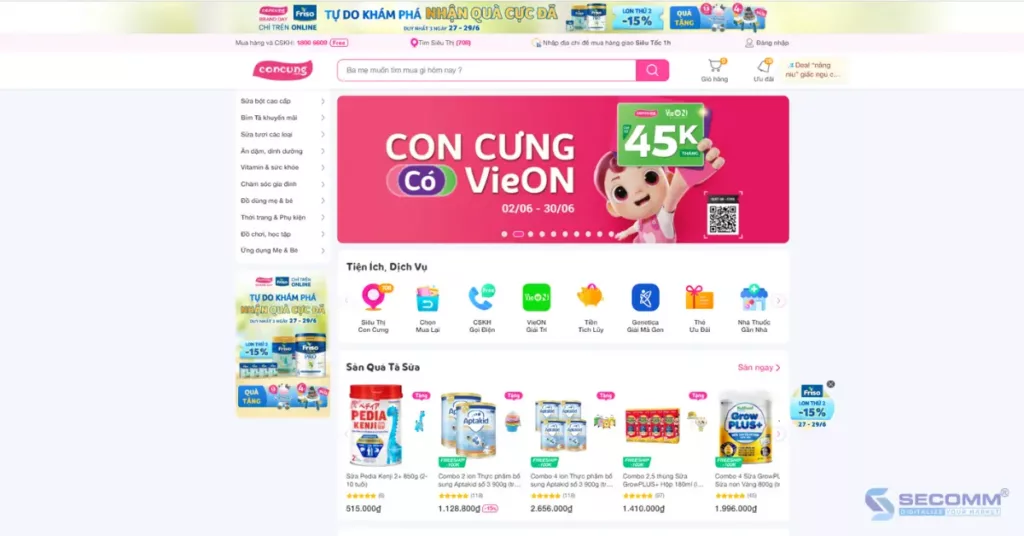
Therefore, in recent times, Con Cung has made an effort to attract customers to its eCommerce website. They consistently promote various enticing programs, including “Monday Freeship Day” and the “Stuffed Animal Fiesta for 99K.”
Additionally, Con Cung has kept pace with the Mobile Commerce trend by introducing the ‘Con Cung’ mobile app, available on both App Store and Google Play. This app has garnered highly positive user feedback and currently ranks 24th in the Shopping category.
Particularly, this retailer’s delivery service has earned high praise from customers. With a network of over 700 stores across the country. Con Cung offers lighting-fast 1-hour delivery through its “Pink Warrior” delivery team. Beyond partnering with third-party delivery providers such as Grab Expres, Giao Hang Nhanh, Giao Hang Tiet Kiem, the brand also maintains a dedicated team of delivery warriors who cater to customer’s specific time preferences.
Kids Plaza
Established in 2009, Kids Plaza offers more than 10,000 mom-and-baby products, certified safe for babies from top-notch brands in Vietnam and around the world. In the competitive race, Kids Plaza has consistently fortified its position by embracing the O2O business model.
This strategy involves harmoniously blending traditional in-store retail with a variety of online channels, including a dedicated website, eCommerce platforms, Zalo stores, mobile applications, and more. Kids Plaza has rolled out enticing customer loyalty programs such as Kicoin, the convenient Freeship policy covering a 7km radius for all purchasing channels, and exclusive discounts for expectant mothers when shopping in brick-and-mortar stores.
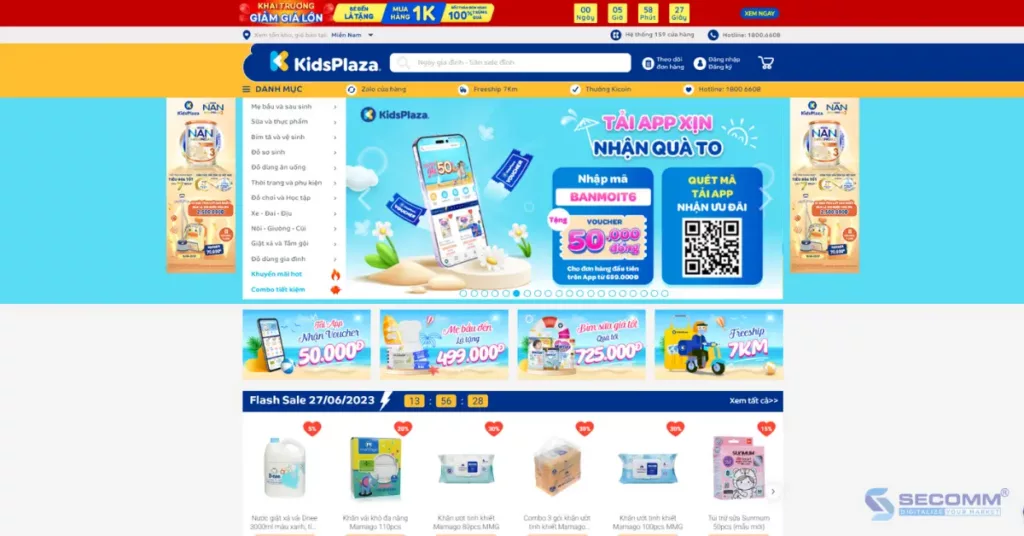
Customers aren’t only satisfied by the seamless shopping experience, affordable prices, and appealing promotional offers but also by exceptional product quality. All products undergo strict quality control before being officially offered for sale to provide the best experience and service, ensuring customers’ peace of mind while shopping.
Kids Plaza also demonstrates its care for expectant moms and babies through programs like the free antenatal classes, which have been conducted for over a decade and have successfully aided numerous mothers during their childbirth journeys. Moreover, the brand hosts annual community events and maintains an insightful knowledge-sharing blog to help elevate health awareness among both mothers and children.
Bibo Mart
The mom-and-baby retail chain, Bibo Mart, was established in 2006 and specializes in offering a wide range of products for mothers and babies, including maternity clothing, diapers, formula, and strollers. Similar to Con Cung and Kids Plaza, Bibo Mart hasn’t lagged behind in the eCommerce race. After years of operation and growth, Bibo Mart has identified a new vision for investing in an eCommerce system to meet the online shopping needs of its customers.
Currently, online sales at Bibo Mart account for 14.5% of the total revenue and are expected to increase to over 30% in the next five years. Beyond frequently offering attractive incentives to encourage customers to shop on their website and app, Bibo Mart has introduced a loyalty program with four tiers: Loyal, Silver, Gold, and Diamond. Customers are assigned membership ranks based on their specified spending levels and earn BiXu points for continued exclusive benefits.
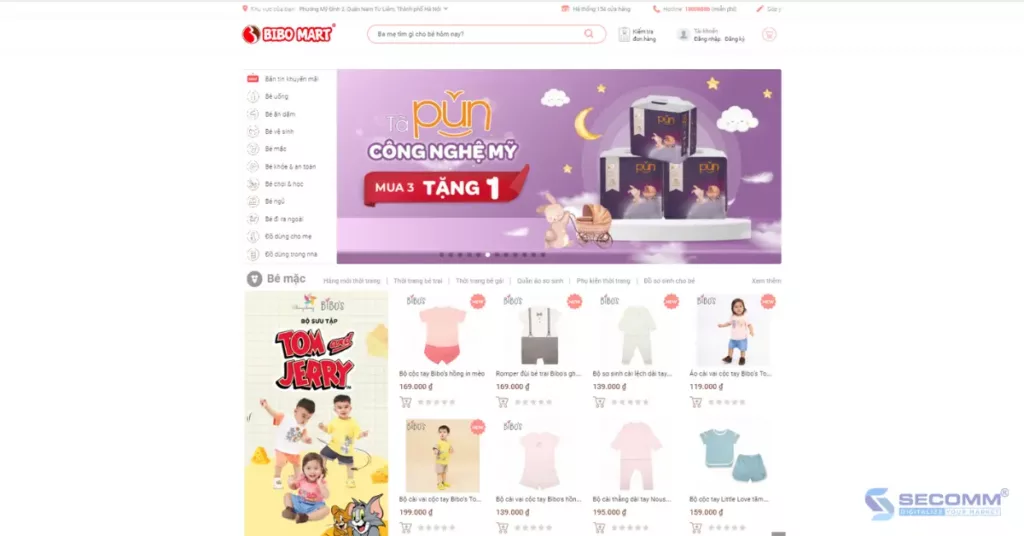
Notably, customers can use a QR code on the app to scan for product info or accumulate points when shopping in physical stores. Bibo Mart also demonstrates its commitment to its customers by providing maternal and childcare knowledge through blogs and free online seminars and classes for mothers as well as those caring for their health during pregnancy and postpartum.
The potential of the Baby eCommerce market in Vietnam is enormous, and the success of major players like Con Cung, Kids Plaza, and Bibo Mart has encouraged the participation of other businesses. However, for a Baby eCommerce business to succeed, it’s important to build a comprehensive and feasible strategy, both short-term and long-term. Particularly, eCommerce websites and mobile apps are the two crucial keys that determine the success or failure of a business in the eCommerce race.
Having partnered with many businesses in implementing eCommerce websites and apps over the years, SECOMM has accumulated practical experience to assist businesses in swift and effective deployment.
Feel free to contact us or call SECOMM’s hotline at (02871089908) for a free consultation.
 2
2

 12,757
12,757

 0
0

 1
1





